Dell 5HCKT Notebook Computer w/ Intel PRO/Wireless 2195ABG User Manual book
Dell Inc. Notebook Computer w/ Intel PRO/Wireless 2195ABG book
Dell >
Contents
Users Manual 2

Solving Problems 77
11
Solving Problems
Dell Diagnostics
CAUTION: Before you begin any of the procedures in this section, follow the safety instructions in the
Product Information Guide
.
When to Use the Dell Diagnostics
If you experience a problem with your computer, perform the checks in "Lockups and Software
Problems" on page 88 and run the Dell Diagnostics before you contact Dell for technical
assistance.
NOTICE: The Dell Diagnostics works only on Dell computers.
NOTE: The Drivers and Utilities CD is optional and may not ship with your computer.
Start the Dell Diagnostics from either your hard drive or from the Drivers and Utilities CD (also
known as the ResourceCD).
Starting the Dell Diagnostics From Your Hard Drive
The Dell Diagnostics is located on a hidden diagnostic utility partition on your hard drive.
NOTE: If your computer cannot display a screen image, contact Dell. See "Contacting Dell" on page 145.
1
Shut down the computer.
2
Connect the computer to an electrical outlet.
3
Diagnostics can be invoked one of two ways:
a
Turn on the computer. When the DELL™ logo appears, press <F12> immediately.
Select
Diagnostics
from the boot menu and press <Enter>.
NOTE: If you wait too long and the operating system logo appears, continue to wait until you see
the Microsoft® Windows® desktop. Then shut down your computer and try again.
b
Press and hold the <Fn> key while powering the system on.
NOTE: If you see a message stating that no diagnostics utility partition has been found, run the Dell
Diagnostics from the Drivers and Utilities CD.
book.book Page 77 Wednesday, September 28, 2005 2:16 PM

78 Solving Problems
www.dell.com | support.dell.com
The computer runs the Pre-boot System Assessment, a series of initial tests of your system
board, keyboard, hard drive, and display.
• During the assessment, answer any questions that appear.
• If a failure is detected, the computer stops and beeps. To stop the assessment and restart
the computer, press <n>; to continue to the next test, press <y>; to retest the
component that failed, press <r>.
• If failures are detected during the Pre-boot System Assessment, write down the error
code(s) and contact Dell.
If the Pre-boot System Assessment completes successfully, you receive the message
Booting
Dell Diagnostic Utility Partition. Press any key to continue
.
4
Press any key to start the Dell Diagnostics from the diagnostics utility partition on your
hard drive.
Starting the Dell Diagnostics From the Drivers and Utilities CD
NOTE: The Drivers and Utilities CD may be optional and may not ship with your computer.
1
Insert the
Drivers and Utilities
CD.
2
Shut down and restart the computer.
When the DELL logo appears, press <F12> immediately.
If you wait too long and the Windows logo appears, continue to wait until you see the
Windows desktop. Then shut down your computer and try again.
NOTE: The next steps change the boot sequence for one time only. On the next start-up, the computer
boots according to the devices specified in the system setup program.
3
When the boot device list appears, highlight
CD/DVD/CD-RW Drive
and press <Enter>.
4
Select the
Boot from CD-ROM
option from the menu that appears and press <Enter>.
5
Ty p e
1
to start the
ResourceCD
menu and press <Enter> to proceed.
6
Select
Run the 32 Bit Dell Diagnostics
from the numbered list. If multiple versions are listed,
select the version appropriate for your computer.
7
When the Dell Diagnostics
Main Menu
appears, select the test you want to run.
book.book Page 78 Wednesday, September 28, 2005 2:16 PM

Solving Problems 79
Dell Diagnostics Main Menu
1
After the Dell Diagnostics loads and the
Main
Menu
screen appears, click the button for the
option you want.
2
If a problem is encountered during a test, a message appears with an error code and a
description of the problem. Write down the error code and problem description and follow
the instructions on the screen.
If you cannot resolve the error condition, contact Dell.
NOTE: The Service Tag for your computer is located at the top of each test screen. If you contact Dell,
technical support will ask for your Service Tag.
3
If you run a test from the
Custom Test
or
Symptom Tree
option, click the applicable tab
described in the following table for more information.
Option Function
Express Test Performs a quick test of devices. This test typically takes
10 to 20 minutes and requires no interaction on your
part. Run Express Test first to increase the possibility of
tracing the problem quickly.
Extended Test Performs a thorough check of devices. This test typically
takes 1 hour or more and requires you to answer
questions periodically.
Custom Test Tests a specific device. You can customize the tests you
want to run.
Symptom Tree Lists the most common symptoms encountered and
allows you to select a test based on the symptom of the
problem you are having.
Tab Function
Results Displays the results of the test and any error conditions
encountered.
Errors Displays error conditions encountered, error codes, and
the problem description.
Help Describes the test and may indicate requirements for
running the test.
book.book Page 79 Wednesday, September 28, 2005 2:16 PM

80 Solving Problems
www.dell.com | support.dell.com
4
When the tests are completed, if you are running the Dell Diagnostics from the
Drivers and
Utilities
CD
,
remove the CD.
5
When the tests are complete, close the test screen to return to the
Main
Menu
screen. To exit
the Dell Diagnostics and restart the computer, close the
Main
Menu
screen.
Drive Problems
CAUTION: Before you begin any of the procedures in this section, follow the safety instructions in the
Product Information Guide
.
ENSURE THAT MICROSOFT® WINDOWS® RECOGNIZES THE DRIVE —Click the Start button and
click My Computer. If the floppy, CD, or DVD drive is not listed, perform a full scan with your
antivirus software to check for and remove viruses. Viruses can sometimes prevent Windows
from recognizing the drive.
TEST THE DRIVE —
• Insert another floppy disk, CD, or DVD to eliminate the possibility that the original one is
defective.
• Insert a bootable floppy disk and restart the computer.
CLEAN THE DRIVE OR DISK —See "Cleaning Your Computer" on page 141.
ENSURE THAT THE CD IS SNAPPED ONTO THE SPINDLE
CHECK THE CABLE CONNECTIONS
CHECK FOR HARDWARE INCOMPATIBILITIES —(See "Resolving Software and Hardware
Incompatibilities" on page 99.
RUN THE DELL DIAGNOSTICS —See "Dell Diagnostics" on page 77.
Configuration Displays your hardware configuration for the selected
device.
The Dell Diagnostics obtains configuration information
for all devices from the system setup program, memory,
and various internal tests, and it displays the information
in the device list in the left pane of the screen. The
device list may not display the names of all the
components installed on your computer or all devices
attached to your computer.
Parameters Allows you to customize the test by changing the test
settings.
Tab Function
book.book Page 80 Wednesday, September 28, 2005 2:16 PM

Solving Problems 81
CD and DVD drive problems
NOTE: High-speed CD or DVD drive vibration is normal and may cause noise, which does not indicate a
defect in the drive or the CD or DVD.
NOTE: Because of different regions worldwide and different disc formats, not all DVD titles work in all
DVD drives.
Problems writing to a CD/DVD-RW drive
CLOSE OTHER PROGRAMS —
The CD/DVD-RW drive must receive a steady stream of data when
writing. If the stream is interrupted, an error occurs. Try closing all programs before you write to the
CD/DVD-RW.
TURN OFF STANDBY MODE IN WINDOWS BEFORE WRITING TO A CD/DVD-RW DISC —See "Power
Management Modes" on page 41 for information on standby mode.
CHANGE THE WRITE SPEED TO A SLOWER RATE —
See the help files for your CD or DVD creation
software.
If you cannot eject the CD, CD-RW, DVD, or DVD+RW drive tray
1
Ensure that the computer is shut down.
2
Straighten a paper clip and insert one end into the eject hole at the front of the drive; push
firmly until the tray is partially ejected.
3
Gently pull out the tray until it stops.
If you hear an unfamiliar scraping or grinding sound
• Ensure that the sound is not caused by the program that is running.
• Ensure that the disk or disc is inserted properly.
Hard drive problems
ALLOW THE COMPUTER TO COOL BEFORE TURNING IT ON —
A hot hard drive may prevent the
operating system from starting. Try allowing the computer to return to room temperature before
turning it on.
RUN CHECK DISK —
1
Click the
Start
button and click
My Computer
.
2
Right-click
Local Disk C:
.
3
Click
Properties
.
4
Click the
Tools
tab.
5
Under
Error-checking
, click
Check Now
.
6
Click
Scan for and attempt recovery of bad sectors
.
7
Click
Start
.
book.book Page 81 Wednesday, September 28, 2005 2:16 PM

82 Solving Problems
www.dell.com | support.dell.com
E-Mail, Modem, and Internet Problems
CAUTION: Before you begin any of the procedures in this section, follow the safety instructions in the
Product Information Guide
.
NOTE: Connect the modem to an analog telephone jack only. The modem does not operate while it is
connected to a digital telephone network.
CHECK THE MICROSOFT OUTLOOK® EXPRESS SECURITY SETTINGS —
If you cannot open your e-
mail attachments:
1
In Outlook Express, click
Tools
, click
Options
, and then click
Security
.
2
Click
Do not allow attachments
to remove the checkmark.
CHECK THE TELEPHONE LINE CONNECTION
CHECK THE TELEPHONE JACK
CONNECT THE MODEM DIRECTLY TO THE TELEPHONE WALL JACK
USE A DIFFERENT TELEPHONE LINE —
• Verify that the telephone line is connected to the jack on the modem. (The jack has either a
green label or a connector-shaped icon next to it.)
• Ensure that you hear a click when you insert the telephone line connector into the modem.
• Disconnect the telephone line from the modem and connect it to a telephone. Listen for a
dial tone.
• If you have other telephone devices sharing the line, such as an answering machine, fax
machine, surge protector, or line splitter, then bypass them and connect the modem directly
to the telephone wall jack. If you are using a line that is 3 m (10 ft) or more in length, try a
shorter one.
RUN THE MODEM HELPER DIAGNOSTICS —
Click the
Start
button, point to
All
Programs
and then
click
Modem Helper
. Follow the instructions on the screen to identify and resolve modem
problems. (Modem Helper is not available on all computers.)
VERIFY THAT THE MODEM IS COMMUNICATING WITH WINDOWS —
1
Click the
Start
button and click
Control Panel
.
2
Click
Printers and Other Hardware
.
3
Click
Phone and Modem Options
.
4
Click the
Modems
tab.
5
Click the COM port for your modem.
6
Click
Properties
, click the
Diagnostics
tab, and then click
Query Modem
to verify that the
modem is communicating with Windows.
If all commands receive responses, the modem is operating properly.
book.book Page 82 Wednesday, September 28, 2005 2:16 PM

Solving Problems 83
ENSURE THAT YOU ARE CONNECTED TO THE INTERNET —
Ensure that you have subscribed to an
Internet provider. With the Outlook Express e-mail program open, click
File
. If
Work Offline
has a
checkmark next to it, click the checkmark to remove it and connect to the Internet. For help,
contact your Internet service provider.
SCAN THE COMPUTER FOR SPYWARE —
If you are experiencing slow computer performance, you
frequently receive pop-up advertisements, or you are having problems connecting to the Internet,
your computer might be infected with spyware. Use an anti-virus program that includes anti-
spyware protection (your program may require an upgrade) to scan the computer and remove
spyware. For more information, go to
support.dell.com
and search for the keyword
spyware
.
Error Messages
CAUTION: Before you begin any of the procedures in this section, follow the safety instructions in the
Product Information Guide
.
If the message is not listed, see the documentation for the operating system or the program that
was running when the message appeared.
AUXILIARY DEVICE FAILURE —The touch pad, track stick, or external mouse may be faulty. For an
external mouse, check the cable connection. Enable the Pointing Device option in the system
setup program. If the problem persists, contact Dell. See "Contacting Dell" on page 145.
BAD COMMAND OR FILE NAME —Ensure that you have spelled the command correctly, put spaces
in the proper place, and used the correct pathname.
CACHE DISABLED DUE TO FAILURE —The primary cache internal to the microprocessor has failed.
Contact Dell. See "Contacting Dell" on page 145.
CD DRIVE CONTROLLER FAILURE —The CD drive does not respond to commands from the
computer. See "Drive Problems" on page 80.
DATA ERROR —The hard drive cannot read the data. See "Drive Problems" on page 80.
DECREASING AVAILABLE MEMORY —One or more memory modules may be faulty or improperly
seated. Reinstall the memory modules and, if necessary, replace them. See "Memory" on
page 112.
DISK C: FAILED INITIALIZATION —The hard drive failed initialization. Run the hard drive tests in
the Dell Diagnostics. See "Dell Diagnostics" on page 77.
DRIVE NOT READY —The operation requires a hard drive in the bay before it can continue.
Install a hard drive in the hard drive bay. See "Hard Drive" on page 108.
ERROR READING PCMCIA CARD —The computer cannot identify the ExpressCard. Reinsert the
card or try another card. See "Using ExpressCards" on page 67.
EXTENDED MEMORY SIZE HAS CHANGED —The amount of memory recorded in NVRAM does not
match the memory installed in the computer. Restart the computer. If the error appears again,
contact Dell. See "Contacting Dell" on page 145.
book.book Page 83 Wednesday, September 28, 2005 2:16 PM

84 Solving Problems
www.dell.com | support.dell.com
THE FILE BEING COPIED IS TOO LARGE FOR THE DESTINATION DRIVE —
The file that you are trying to
copy is too large to fit on the disk, or the disk is too full. Try copying the file to a different disk or
use a larger capacity disk.
A FILENAME CANNOT CONTAIN ANY OF THE FOLLOWING CHARACTERS: \ / : * ? “ < > | —
Do not use
these characters in filenames.
GATE A20 FAILURE —A memory module may be loose. Reinstall the memory modules and, if
necessary, replace them. See "Memory" on page 112.
GENERAL FAILURE —The operating system is unable to carry out the command. The message is
usually followed by specific information—for example, Printer out of paper. Take t he
appropriate action.
HARD-DISK DRIVE CONFIGURATION ERROR —The computer cannot identify the drive type. Shut
down the computer, remove the hard drive (see page 108), and boot the computer from a CD.
Then shut down the computer, reinstall the hard drive, and restart the computer. Run the Hard-
Disk Drive tests in the Dell Diagnostics (see page 77).
HARD-DISK DRIVE CONTROLLER FAILURE 0—The hard drive does not respond to commands from
the computer. Shut down the computer, remove the hard drive (see page 108), and boot the
computer from a CD. Then shut down the computer, reinstall the hard drive, and restart the
computer. If the problem persists, try another drive. Run the Hard-Disk Drive tests in the Dell
Diagnostics (see page 77).
HARD-DISK DRIVE FAILURE —The hard drive does not respond to commands from the computer.
Shut down the computer, remove the hard drive (see page 108), and boot the computer from a
CD. Then shut down the computer, reinstall the hard drive, and restart the computer. If the
problem persists, try another drive. Run the Hard-Disk Drive tests in the Dell Diagnostics (see
page 77).
HARD-DISK DRIVE READ FAILURE —The hard drive may be defective. Shut down the computer,
remove the hard drive (see page 108), and boot the computer from a CD. Then shut down the
computer, reinstall the hard drive, and restart the computer. If the problem persists, try another
drive. Run the Hard-Disk Drive tests in the Dell Diagnostics (see page 77).
INSERT BOOTABLE MEDIA —The operating system is trying to boot to a nonbootable CD. Insert
a bootable CD.
INVALID CONFIGURATION INFORMATION-PLEASE RUN SYSTEM SETUP PROGRAM —The system
configuration information does not match the hardware configuration. The message is most
likely to occur after a memory module is installed. Correct the appropriate options in the system
setup program (see "Using the System Setup Program" on page 137).
KEYBOARD CLOCK LINE FAILURE —For external keyboards, check the cable connection. Run the
Keyboard Controller test in the Dell Diagnostics (see page 77).
KEYBOARD CONTROLLER FAILURE —For external keyboards, check the cable connection. Restart
the computer, and avoid touching the keyboard or the mouse during the boot routine. Run the
Keyboard Controller test in the Dell Diagnostics (see page 77).
book.book Page 84 Wednesday, September 28, 2005 2:16 PM

Solving Problems 85
KEYBOARD DATA LINE FAILURE —For external keyboards, check the cable connection. Run the
Keyboard Controller test in the Dell Diagnostic (see page 77)s.
KEYBOARD STUCK KEY FAILURE —For external keyboards or keypads, check the cable connection.
Restart the computer, and avoid touching the keyboard or keys during the boot routine. Run the
Stuck Key test in the Dell Diagnostics (see page 77).
LICENSED CONTENT IS NOT ACCESSIBLE IN MEDIADIRECT —Dell MediaDirect cannot verify the
Digital Rights Management (DRM) restrictions on the file, so the file cannot be played. See
"Dell MediaDirect problems" on page 89.
MEMORY ADDRESS LINE FAILURE AT ADDRESS, READ VALUE EXPECTING VALUE —A memory module
may be faulty or improperly seated. Reinstall the memory modules and, if necessary, replace
them (see page 112).
MEMORY ALLOCATION ERROR —The software you are attempting to run is conflicting with the
operating system, another program, or a utility. Shut down the computer, wait 30 seconds, and
then restart it. Try to run the program again. If the error message still appears, see the software
documentation.
MEMORY DATA LINE FAILURE AT ADDRESS, READ VALUE EXPECTING VALUE —A memory module
may be faulty or improperly seated. Reinstall the memory modules and, if necessary, replace
them (see page 112).
MEMORY DOUBLE WORD LOGIC FAILURE AT ADDRESS, READ VALUE EXPECTING VALUE —A memory
module may be faulty or improperly seated. Reinstall the memory modules and, if necessary,
replace them (see page 112).
MEMORY ODD/EVEN LOGIC FAILURE AT ADDRESS, READ VALUE EXPECTING VALUE —A memory
module may be faulty or improperly seated. Reinstall the memory modules and, if necessary,
replace them (see page 112).
MEMORY WRITE/READ FAILURE AT ADDRESS, READ VALUE EXPECTING VALUE —A memory module
may be faulty or improperly seated. Reinstall the memory modules and, if necessary, replace
them (see page 112).
NO BOOT DEVICE AVAILABLE —The computer cannot find the hard drive. If the hard drive is your
boot device, ensure that the drive is installed, properly seated, and partitioned as a boot device.
NO BOOT SECTOR ON HARD DRIVE —The operating system may be corrupted. Contact Dell. See
"Contacting Dell" on page 145.
NO TIMER TICK INTERRUPT —A chip on the system board may be malfunctioning. Run the
System Set tests in the Dell Diagnostics (see page 77).
NOT ENOUGH MEMORY OR RESOURCES. EXIT SOME PROGRAMS AND TRY AGAIN —Yo u h a v e t o o
many programs open. Close all windows and open the program that you want to use.
OPERATING SYSTEM NOT FOUND —Reinstall the hard drive (see "Hard Drive" on page 108). If the
problem persists, contact Dell. See "Contacting Dell" on page 145.
OPTIONAL ROM BAD CHECKSUM —The optional ROM apparently failed. Contact Dell. See
"Contacting Dell" on page 145.
book.book Page 85 Wednesday, September 28, 2005 2:16 PM

86 Solving Problems
www.dell.com | support.dell.com
A REQUIRED .DLL FILE WAS NOT FOUND —The program that you are trying to open is missing an
essential file. Remove and then reinstall the program.
1
Click the
Start
button and click
Control Panel
.
2
Click
Add or Remove Programs
.
3
Select the program you want to remove.
4
Click
Remove
or
Change/Remove
and follow the prompts on the screen.
5
See the program documentation for installation instructions.
SECTOR NOT FOUND —The operating system cannot locate a sector on the hard drive. You may
have a defective sector or corrupted FAT on the hard drive. Run the Windows error-checking
utility to check the file structure on the hard drive. See the Windows Help and Support Center
for instructions. To access the Help and Support Center, see "Windows Help and Support
Center" on page 13. If a large number of sectors are defective, back up the data (if possible), and
then reformat the hard drive.
SEEK ERROR —The operating system cannot find a specific track on the hard drive.
SHUTDOWN FAILURE —A chip on the system board may be malfunctioning. Run the System Set
tests in the Dell Diagnostics (see page 77).
TIME-OF-DAY CLOCK LOST POWER —
System configuration settings are corrupted. Connect your
computer to an electrical outlet to charge the battery. If the problem persists, try to restore the data
by entering the system setup program. Then immediately exit the program. See "Using the System
Setup Program" on page 137. If the message reappears, contact Dell.
See "Contacting Dell" on
page 145.
TIME-OF-DAY CLOCK STOPPED —The reserve battery that supports the system configuration
settings may require recharging. Connect your computer to an electrical outlet to charge the
battery. If the problem persists, contact Dell. See "Contacting Dell" on page 145.
TIME-OF-DAY NOT SET-PLEASE RUN THE SYSTEM SETUP PROGRAM —The time or date stored in
the system setup program does not match the system clock. Correct the settings for the Date
and Time options. See "Using the System Setup Program" on page 137.
TIMER CHIP COUNTER 2 FAILED —A chip on the system board may be malfunctioning. Run the
System Set tests in the Dell Diagnostics (see page 77).
UNEXPECTED INTERRUPT IN PROTECTED MODE —The keyboard controller may be malfunctioning,
or a memory module may be loose. Run the System Memory tests and the Keyboard Controller
test in the Dell Diagnostics (see page 77).
X:\ IS NOT ACCESSIBLE. THE DEVICE IS NOT READY —Insert a disk into the drive and try again.
WARNING: BATTERY IS CRITICALLY LOW —The battery is running out of charge. Replace the
battery, or connect the computer to an electrical outlet. Otherwise, activate hibernate mode or
shut down the computer.
book.book Page 86 Wednesday, September 28, 2005 2:16 PM

Solving Problems 87
IEEE 1394 Device Problems
CAUTION: Before you begin any of the procedures in this section, follow the safety instructions in the
Product Information Guide
.
ENSURE THAT THE IEEE 1394 DEVICE IS RECOGNIZED BY WINDOWS —
1
Click the
Start
button and click
Control Panel
.
2
Click
Printers and Other Hardware
.
If your IEEE 1394 device is listed, Windows recognizes the device.
IF YOU HAVE PROBLEMS WITH A DELL-PROVIDED IEEE 1394 DEVICE —Contact Dell or the
IEEE 1394 device manufacturer. See "Contacting Dell" on page 145.
IF YOU HAVE PROBLEMS WITH AN IEEE 1394 DEVICE NOT PROVIDED BY DELL —Contact Dell or the
IEEE 1394 device manufacturer. See "Contacting Dell" on page 145.
ENSURE THAT THE IEEE 1394 DEVICE IS PROPERLY INSERTED INTO THE CONNECTOR
Keyboard Problems
CAUTION: Before you begin any of the procedures in this section, follow the safety instructions in the
Product Information Guide
.
NOTE: Use the integrated keyboard when running the Dell Diagnostics or the system setup program.
When you attach an external keyboard, the integrated keyboard remains fully functional.
External Keyboard problems
NOTE: When you attach an external keyboard, the integrated keyboard remains fully functional.
CHECK THE KEYBOARD CABLE —Shut down the computer. Disconnect the keyboard cable and
check it for damage, and firmly reconnect the cable.
If you are using a keyboard extension cable, disconnect it and connect the keyboard directly to
the computer.
CHECK THE EXTERNAL KEYBOARD —
1
Shut down the computer, wait 1 minute, and turn it on again.
2
Verify that the numbers, capitals, and scroll lock lights on the keyboard blink during the boot
routine.
3
From the Windows desktop, click the
Start
button, point to
Programs
→
Accessories
, and
then click
Notepad
.
4
Type some characters on the external keyboard and verify that they appear on the display.
If you cannot verify these steps, you may have a defective external keyboard.
book.book Page 87 Wednesday, September 28, 2005 2:16 PM

88 Solving Problems
www.dell.com | support.dell.com
TO VERIFY THAT THE PROBLEM IS WITH THE EXTERNAL KEYBOARD, CHECK THE INTEGRATED
KEYBOARD —
1
Shut down the computer.
2
Disconnect the external keyboard.
3
Turn on the computer.
4
From the Windows desktop, click the
Start
button, point to
Programs
→
Accessories
, and
click
Notepad
.
5
Type some characters on the internal keyboard and verify that they appear on the display.
If the characters appear now but did not with the external keyboard, you may have a defective
external keyboard. Contact Dell.
See "Contacting Dell" on page 145.
RUN THE KEYBOARD DIAGNOSTICS TESTS —
Run the PC-AT Compatible Keyboards tests in the
Dell Diagnostics
(see page 77)
. If the tests indicate a defective external keyboard, contact Dell.
See
"Contacting Dell" on page 145.
Unexpected characters
DISABLE THE NUMERIC KEYPAD —
Press <Num Lk> to disable the numeric keypad if numbers are
displayed instead of letters. Verify that the numbers lock light is not lit.
Lockups and Software Problems
CAUTION: Before you begin any of the procedures in this section, follow the safety instructions in the
Product Information Guide
.
The computer does not start up
ENSURE THAT THE AC ADAPTER IS FIRMLY CONNECTED TO THE COMPUTER AND TO THE ELECTRICAL
OUTLET
The computer stops responding
NOTICE: You might lose data if you are unable to perform an operating system shutdown.
TURN THE COMPUTER OFF —If you are unable to get a response by pressing a key on your
keyboard or moving your mouse, press and hold the power button for at least 8 to 10 seconds
until the computer turns off. Then restart your computer.
A program stops responding or crashes repeatedly
END THE PROGRAM —
1
Press <Crtl><Shift><Esc> simultaneously.
2
Click the
Applications
tab and select the program that is no longer responding.
3
Click
End Task
.
book.book Page 88 Wednesday, September 28, 2005 2:16 PM

Solving Problems 89
NOTE: The chkdsk program may run when you restart the computer. Follow the instructions on the
screen.
CHECK THE SOFTWARE DOCUMENTATION —If necessary, uninstall and then reinstall the program.
Software usually includes installation instructions in its documentation or on a floppy disk
or CD.
A program is designed for an earlier Microsoft® Windows® operating system
RUN THE PROGRAM COMPATIBILITY WIZARD —
The Program Compatibility Wizard configures a
program so it runs in an environment similar to non-Windows XP operating system environments.
1
Click the
Start
button, point to
All Programs
→
Accessories
, and then click
Program
Compatibility Wizard
.
2
In the welcome screen, click
Next
.
3
Follow the instructions on the screen.
A solid blue screen appears
TURN THE COMPUTER OFF —
If you are unable to get a response by pressing a key on your keyboard
or moving your mouse, press and hold the power button for at least 8 to 10 seconds until the
computer turns off. Then restart your computer.
Dell MediaDirect problems
CHECK THE DELL MEDIADIRECT HELP FILE FOR INFORMATION —Click the ? icon at the bottom of
the Dell MediaDirect screen to access Help.
TO PLAY MOVIES WITH DELL MEDIADIRECT, YOU MUST HAVE A DVD DRIVE AND THE DELL DVD
PLAYER —If you purchased a DVD drive with your computer, this software should already be
installed.
VIDEO QUALITY PROBLEMS —Turn off the Use Hardware Acceleration option. This feature takes
advantage of the special processing in some graphics cards to reduce processor requirements
when playing DVDs and certain types of video files.
CANNOT PLAY SOME MEDIA FILES —Because Dell MediaDirect provides access to media files
outside the Windows XP environment, access to licensed content is restricted. Licensed content
is digital content that has Digital Rights Management (DRM) applied to it. The Dell
MediaDirect environment cannot verify the DRM restrictions, so the licensed files cannot be
played. Licensed music and video files have a lock icon next to them. You can access licensed
files in the Windows XP environment.
ADJUSTING THE COLOR SETTINGS FOR MOVIES THAT CONTAIN SCENES THAT ARE TOO DARK OR TOO
BRIGHT —Click EagleVision to use a video enhancement technology that detects video content
and dynamically adjusts the brightness/contrast/saturation ratios.
NOTICE: You cannot reinstall the Dell MediaDirect feature if you voluntarily reformat the hard drive.
Contact Dell for assistance. See "Contacting Dell" on page 145.
book.book Page 89 Wednesday, September 28, 2005 2:16 PM

90 Solving Problems
www.dell.com | support.dell.com
Other software problems
CHECK THE SOFTWARE DOCUMENTATION OR CONTACT THE SOFTWARE MANUFACTURER FOR
TROUBLESHOOTING INFORMATION —
• Ensure that the program is compatible with the operating system installed on your computer.
• Ensure that your computer meets the minimum hardware requirements needed to run the
software. See the software documentation for information.
• Ensure that the program is installed and configured properly.
• Verify that the device drivers do not conflict with the program.
• If necessary, uninstall and then reinstall the program.
BACK UP YOUR FILES IMMEDIATELY
USE A VIRUS-SCANNING PROGRAM TO CHECK THE HARD DRIVE, FLOPPY DISKS, OR CDS
SAVE AND CLOSE ANY OPEN FILES OR PROGRAMS AND SHUT DOWN YOUR COMPUTER THROUGH THE
Start MENU
SCAN THE COMPUTER FOR SPYWARE —If you are experiencing slow computer performance, you
frequently receive pop-up advertisements, or you are having problems connecting to the
Internet, your computer might be infected with spyware. Use an anti-virus program that
includes anti-spyware protection (your program may require an upgrade) to scan the computer
and remove spyware. For more information, go to support.dell.com and search for the keyword
spyware.
RUN THE DELL DIAGNOSTICS —If all tests run successfully, the error condition is related to a
software problem. See "Dell Diagnostics" on page 77.
Memory Problems
CAUTION: Before you begin any of the procedures in this section, follow the safety instructions in the
Product Information Guide
.
IF YOU RECEIVE AN INSUFFICIENT MEMORY MESSAGE —
• Save and close any open files and exit any open programs you are not using to see if that
resolves the problem.
• See the software documentation for minimum memory requirements. If necessary, install
additional memory
(see "Memory" on page 112)
.
• Reseat the memory modules to ensure that your computer is successfully communicating
with the memory
(see "Memory" on page 112)
.
• Run the Dell Diagnostics
(see page 77)
.
IF YOU EXPERIENCE OTHER MEMORY PROBLEMS —
• Reseat the memory modules to ensure that your computer is successfully communicating
with the memory
(see "Memory" on page 112)
.
book.book Page 90 Wednesday, September 28, 2005 2:16 PM

Solving Problems 91
• Ensure that you are following the memory installation guidelines
(see "Memory" on page 112)
.
• Run the Dell Diagnostics
(see page 77)
.
Network Problems
CAUTION: Before you begin any of the procedures in this section, follow the safety instructions in the
Product Information Guide
.
CHECK THE NETWORK CABLE CONNECTOR —
Ensure that the network cable is firmly inserted into
both the network connector on the back of the computer and the network jack.
CHECK THE NETWORK LIGHTS ON THE NETWORK CONNECTOR —
No light indicates that no network
communication exists. Replace the network cable.
RESTART THE COMPUTER AND LOG ON TO THE NETWORK AGAIN
CHECK YOUR NETWORK SETTINGS —
Contact your network administrator or the person who set up
your network to verify that your network settings are correct and that the network is functioning.
ExpressCard Problems
CAUTION: Before you begin any of the procedures in this section, follow the safety instructions in the
Product Information Guide
.
CHECK THE EXPRESSCARD —
Ensure that the ExpressCard is properly inserted into the connector.
ENSURE THAT THE CARD IS RECOGNIZED BY WINDOWS —
Double-click the
Safely Remove
Hardware
icon in the Windows taskbar. Ensure that the card is listed.
IF YOU HAVE PROBLEMS WITH A DELL-PROVIDED EXPRESSCARD —
Contact Dell.
See "Contacting
Dell" on page 145.
IF YOU HAVE PROBLEMS WITH AN EXPRESSCARD NOT PROVIDED BY DELL —
Contact the
ExpressCard manufacturer.
Power Problems
CAUTION: Before you begin any of the procedures in this section, follow the safety instructions in the
Product Information Guide
.
CHECK THE POWER LIGHT —
When the power light is lit or blinking, the computer has power. If the
power light is blinking, the computer is in standby mode—press the power button to exit standby
mode. If the light is off, press the power button to turn on the computer.
NOTE: For information on standby mode, see "Power Management Modes" on page 41.
CHARGE THE BATTERY —
The battery charge may be depleted.
1
Reinstall the battery.
2
Use the AC adapter to connect the computer to an electrical outlet.
3
Turn on the computer.
book.book Page 91 Wednesday, September 28, 2005 2:16 PM

92 Solving Problems
www.dell.com | support.dell.com
NOTE: Battery operating time (the time the battery can hold a charge) decreases over time. Depending
on how often the battery is used and the conditions under which it is used, you may need to purchase a
new battery during the life of your computer.
CHECK THE BATTERY STATUS LIGHT —If the battery status light flashes orange or is a steady
orange the battery charge is low or depleted. Connect the computer to an electrical outlet.
If the battery status light flashes green and orange, the battery is too hot to charge. Shut down
the computer, disconnect the computer from the electrical outlet, and then let the battery and
computer cool to room temperature.
If the battery status light rapidly flashes orange, the battery may be defective. Contact Dell. See
"Contacting Dell" on page 145.
CHECK THE BATTERY TEMPERATURE —If the battery temperature is below 0°C (32°F), the
computer will not start up.
TEST THE ELECTRICAL OUTLET —Ensure that the electrical outlet is working by testing it with
another device, such as a lamp.
CHECK THE AC ADAPTER —Check the AC adapter cable connections. If the AC adapter has a
light, ensure that the light is on.
CONNECT THE COMPUTER DIRECTLY TO AN ELECTRICAL OUTLET —Bypass power protection devices,
power strips, and the extension cable to verify that the computer turns on.
ELIMINATE POSSIBLE INTERFERENCE —Turn off nearby fans, fluorescent lights, halogen lamps, or
other appliances.
ADJUST THE POWER PROPERTIES —See "Power Management Modes" on page 41.
RESEAT THE MEMORY MODULES —
If the computer power light turns on but the display remains
blank, reinstall the memory modules
(see "Memory" on page 112).
Ensuring Sufficient Power for Your Computer
Your computer is designed to use the 90-W AC adapter; for optimum system performance, you
should always use this adapter.
The 65-W AC adapters used in other Dell™ portable computers can be used with your computer,
but they will decrease system performance. Using less-powerful AC adapters, including the 65-W
AC adapter, will cause you to receive a
WARNING
message.
Printer Problems
CAUTION: Before you begin any of the procedures in this section, follow the safety instructions in the
Product Information Guide
.
NOTE: If you need technical assistance for your printer, contact the printer’s manufacturer.
book.book Page 92 Wednesday, September 28, 2005 2:16 PM

Solving Problems 93
ENSURE THAT THE PRINTER IS TURNED ON
CHECK THE PRINTER CABLE CONNECTIONS —
• See the printer documentation for cable connection information.
• Ensure that the printer cables are securely connected to the printer and the computer.
TEST THE ELECTRICAL OUTLET —Ensure that the electrical outlet is working by testing it with
another device, such as a lamp.
VERIFY THAT THE PRINTER IS RECOGNIZED BY WINDOWS —
1
Click the
Start
button, click
Control Panel
, and then click
Printers and Other Hardware
.
2
Click
View installed printers or fax printers
.
If the printer is listed, right-click the printer icon.
3
Click
Properties
and click the
Ports
tab. For a parallel printer, ensure that the
Print to the
following port(s):
setting is
LPT1 (Printer Port)
. For a USB printer, ensure that the
Print to
the following port(s):
setting is
USB
.
REINSTALL THE PRINTER DRIVER —
See the printer documentation for instructions
Scanner Problems
CAUTION: Before you begin any of the procedures in this section, follow the safety instructions in the
Product Information Guide
.
NOTE: If you need technical assistance for your scanner, contact the scanner’s manufacturer.
CHECK THE PRINTER DOCUMENTATION —
See the printer documentation for setup and
troubleshooting information.
CHECK THE SCANNER DOCUMENTATION —
See the scanner documentation for setup and
troubleshooting information.
UNLOCK THE SCANNER —
Ensure that your scanner is unlocked if it has a locking tab or button.
RESTART THE COMPUTER AND TRY THE SCANNER AGAIN
CHECK THE CABLE CONNECTIONS —
• See the scanner documentation for cable connection information.
• Ensure that the scanner cables are securely connected to the scanner and the computer.
VERIFY THAT THE SCANNER IS RECOGNIZED BY MICROSOFT WINDOWS —
1
Click the
Start
button, click
Control Panel
, and then click
Printers and Other Hardware
.
2
Click
Scanners and Cameras
.
If your scanner is listed, Windows recognizes the scanner.
REINSTALL THE SCANNER DRIVER —
See the scanner documentation for instructions.
book.book Page 93 Wednesday, September 28, 2005 2:16 PM

94 Solving Problems
www.dell.com | support.dell.com
Sound and Speaker Problems
CAUTION: Before you begin any of the procedures in this section, follow the safety instructions in the
Product Information Guide
.
No sound from integrated speakers
ADJUST THE WINDOWS VOLUME CONTROL —
Double-click the speaker icon in the lower-right
corner of your screen. Ensure that the volume is turned up and that the sound is not muted. Adjust
the volume, bass, or treble controls to eliminate distortion.
ADJUST THE VOLUME USING KEYBOARD SHORTCUTS —
Press <Fn><End> to disable (mute) or
reenable the integrated speakers.
REINSTALL THE SOUND (AUDIO) DRIVER —
See "Reinstalling Drivers and Utilities" on page 97.
No sound from external speakers
ENSURE THAT THE SUBWOOFER AND THE SPEAKERS ARE TURNED ON —
See the setup diagram
supplied with the speakers. If your speakers have volume controls, adjust the volume, bass, or treble
to eliminate distortion.
ADJUST THE WINDOWS VOLUME CONTROL —
Click or double-click the speaker icon in the lower-
right corner of your screen. Ensure that the volume is turned up and that the sound is not muted.
DISCONNECT HEADPHONES FROM THE HEADPHONE CONNECTOR —
Sound from the speakers is
automatically disabled when headphones are connected to the computer’s front-panel headphone
connector.
TEST THE ELECTRICAL OUTLET —
Ensure that the electrical outlet is working by testing it with
another device, such as a lamp.
ELIMINATE POSSIBLE INTERFERENCE —
Turn off nearby fans, fluorescent lights, or halogen lamps to
check for interference.
REINSTALL THE AUDIO DRIVER —See "Reinstalling Drivers and Utilities" on page 97.
RUN THE DELL DIAGNOSTICS (see page 77)
NOTE: The volume control in some MP3 players overrides the Windows volume setting. If you have been
listening to MP3 songs, ensure that you did not turn the player volume down or off.
No sound from headphones
CHECK THE HEADPHONE CABLE CONNECTION —Ensure that the headphone cable is securely
inserted into the headphone connector (see "audio connectors" on page 20).
ADJUST THE WINDOWS VOLUME CONTROL —
Click or double-click the speaker icon in the lower-
right corner of your screen. Ensure that the volume is turned up and that the sound is not muted.
book.book Page 94 Wednesday, September 28, 2005 2:16 PM

Solving Problems 95
Touch Pad or Mouse Problems
CHECK THE TOUCH PAD SETTINGS —
1
Click the
Start
button, click
Control Panel
, and then click
Printers and Other Hardware
.
2
Click
Mouse
.
3
Try adjusting the settings.
CHECK THE MOUSE CABLE —
Shut down the computer. Disconnect the mouse cable, check it for
damage, and firmly reconnect the cable.
If you are using a mouse extension cable, disconnect it and connect the mouse directly to the
computer.
TO VERIFY THAT THE PROBLEM IS WITH THE MOUSE, CHECK THE TOUCH PAD —
1
Shut down the computer.
2
Disconnect the mouse.
3
Turn on the computer.
4
At the Windows
desktop, use the touch pad to move the cursor around, select an icon, and
open it.
If the touch pad operates correctly, the mouse may be defective.
REINSTALL THE TOUCH PAD DRIVER —
See "Reinstalling Drivers and Utilities" on page 97.
Video and Display Problems
CAUTION: Before you begin any of the procedures in this section, follow the safety instructions in the
Product Information Guide
.
If the display is blank
NOTE: If you are using a program that requires a higher resolution than your computer supports, it is
recommended that you attach an external monitor to your computer.
CHECK THE BATTERY —
If you are using a battery to power your computer, the battery charge may
be depleted. Connect the computer to an electrical outlet using the AC adapter, and turn on the
computer.
TEST THE ELECTRICAL OUTLET —
Ensure that the electrical outlet is working by testing it with
another device, such as a lamp.
CHECK THE AC ADAPTER —
Check the AC adapter cable connections. If the AC adapter has a light,
ensure that the light is on.
CONNECT THE COMPUTER DIRECTLY TO AN ELECTRICAL OUTLET —
Bypass power protection devices,
power strips, and the extension cable to verify that the computer turns on.
ADJUST THE POWER PROPERTIES —
Search for the keyword
standby
in the Windows Help and
Support Center. To access the Help and Support Center, see page 13.
book.book Page 95 Wednesday, September 28, 2005 2:16 PM

96 Solving Problems
www.dell.com | support.dell.com
SWITCH THE VIDEO IMAGE —
If your computer is attached to an external monitor, press
<Fn><F8> to switch the video image to the display.
If the display is difficult to read
ADJUST THE BRIGHTNESS —
Press <Fn> and the up- or down-arrow key
MOVE THE EXTERNAL SUBWOOFER AWAY FROM THE COMPUTER OR MONITOR —
If your external
speaker system includes a subwoofer, ensure that the subwoofer is at least 60 cm (2 ft) away from
the computer or external monitor.
ELIMINATE POSSIBLE INTERFERENCE —
Turn off nearby fans, fluorescent lights, halogen lamps, or
other appliances.
ROTATE THE COMPUTER TO FACE A DIFFERENT DIRECTION —
Eliminate sunlight glare, which can
cause poor picture quality.
ADJUST THE WINDOWS DISPLAY SETTINGS —
1
Click the
Start
button and then click
Control Panel
.
2
Click
Appearance and Themes
.
3
Click the area you want to change or click the
Display
icon.
4
Try different settings for
Color quality
and
Screen resolution
.
SEE "ERROR MESSAGES"—If an error message appears, see page 83.
If only part of the display is readable
CONNECT AN EXTERNAL MONITOR —
1
Shut down your computer and connect an external monitor to the computer.
2
Turn on the computer and the monitor and adjust the monitor brightness and contrast
controls.
If the external monitor works, the computer display or video controller may be defective. Contact
Dell.
See "Contacting Dell" on page 145.
Drivers
What Is a Driver?
A driver is a program that controls a device such as a printer, mouse, or keyboard. All devices
require a driver program.
A driver acts like a translator between the device and any other programs that use the device.
Each device has its own set of specialized commands that only its driver recognizes.
Dell ships your computer to you with required drivers already installed—no further installation
or configuration is needed.
book.book Page 96 Wednesday, September 28, 2005 2:16 PM

Solving Problems 97
NOTICE: The Drivers and Utilities CD may contain drivers for operating systems that are not on your
computer. Ensure that you are installing software appropriate for your operating system.
Many drivers, such as the keyboard driver, come with your Microsoft® Windows® operating
system. You may need to install drivers if you:
• Upgrade your operating system.
• Reinstall your operating system.
• Connect or install a new device.
Identifying Drivers
If you experience a problem with any device, identify whether the driver is the source of your
problem and, if necessary, update the driver.
1
Click the
Start
button and click
Control Panel
.
2
Under
Pick a Category
, click
Performance and Maintenance
.
3
Click
System
.
4
In the
System Properties
window, click the
Hardware
tab.
5
Click
Device Manager
.
6
Scroll down the list to see if any device has an exclamation point (a yellow circle with a [
!]
) on
the device icon.
If an exclamation point is next to the device name, you may need to reinstall the driver or
install a new driver. See "Reinstalling Drivers and Utilities" on page 97.
Reinstalling Drivers and Utilities
NOTICE: The Dell Support website at support.dell.com and your Drivers and Utilities CD provide
approved drivers for Dell™ computers. If you install drivers obtained from other sources, your computer
might not work correctly.
Using Windows XP Device Driver Rollback
If a problem occurs on your computer after you install or update a driver, use Windows XP
Device Driver Rollback to replace the driver with the previously installed version.
1
Click the
Start
button and click
Control Panel
.
2
Under
Pick a Category
, click
Performance and Maintenance
.
3
Click
System
.
4
In the
System Properties
window, click the
Hardware
tab.
5
Click
Device Manager
.
6
Right-click the device for which the new driver was installed and click
Properties
.
book.book Page 97 Wednesday, September 28, 2005 2:16 PM

98 Solving Problems
www.dell.com | support.dell.com
7
Click the
Drivers
tab.
8
Click
Roll Back Driver
.
If Device Driver Rollback does not resolve the problem, then use System Restore to return your
computer to the operating state that existed before you installed the new driver.
Using the Drivers and Utilities CD
NOTE: The Drivers and Utilities CD is optional and may not ship with your computer.
If using
Device Driver Rollback
or System Restore does not resolve the problem, then reinstall
the driver from the Drivers and Utilities CD.
1
Save and close any open files, and exit any open programs.
2
Insert the
Drivers and Utilities
CD.
In most cases, the CD starts running automatically. If it does not, start Windows Explorer,
click your CD drive directory to display the CD contents, and then double-click the
autorcd.exe
file. The first time that you run the CD, it might prompt you to install setup files.
Click
OK
, and follow the instructions on the screen to continue.
3
From the
Language
drop-down menu in the toolbar, select your preferred language for the
driver or utility (if available). A welcome screen appears.
4
Click
Next
.
The CD automatically scans your hardware to detect drivers and utilities used by your
computer.
5
After the CD completes the hardware scan, you can also detect other drivers and utilities.
Under
Search Criteria
, select the appropriate categories from the
System Model
,
Operating
System
, and
Topic
drop-down menus.
A link or links appear(s) for the specific drivers and utilities used by your computer.
6
Click the link of a specific driver or utility to display information about the driver or utility
that you want to install.
7
Click the
Install
button (if present) to begin installing the driver or utility. At the welcome
screen, follow the screen prompts to complete the installation.
If no
Install
button is present, automatic installation is not an option. For installation
instructions, either see the appropriate instructions in the following subsections, or click
Extract
, follow the extracting instructions, and then read the readme file.
If instructed to navigate to the driver files, click the CD directory on the driver information
window to display the files associated with that driver.
book.book Page 98 Wednesday, September 28, 2005 2:16 PM

Solving Problems 99
Manually Reinstalling Drivers
NOTE: If you are reinstalling an infrared sensor driver, you must first enable the infrared sensor in the
system setup program before continuing with the driver installation. See "Reinstalling Drivers and
Utilities" on page 97.
1
After extracting the driver files to your hard drive as described in the previous section, click
the
Start
button and right-click
My Computer
.
2
Click
Properties
.
3
Click the
Hardware
tab and click
Device Manager
.
4
Double-click the type of device for which you are installing the driver (for example,
Modems
or
Infrared devices
).
5
Double-click the name of the device for which you are installing the driver.
6
Click the
Driver
tab and click
Update Driver
.
7
Click
Install from a list or specific location (Advanced)
and click
Next
.
8
Click
Browse
and browse to the location to which you previously copied the driver files.
9
When the name of the appropriate driver appears, click
Next
.
10
Click
Finish
and restart your computer.
Resolving Software and Hardware Incompatibilities
If a device is either not detected during the operating system setup or is detected but incorrectly
configured, you can use the Hardware Troubleshooter to resolve the incompatibility.
To start the Hardware Troubleshooter:
1
Click the
Start
button and click
Help and Support
.
2
Ty p e
hardware troubleshooter
in the
Search
field and click the arrow to start the
search.
3
Click
Hardware Troubleshooter
in the
Search Results
list.
4
In the
Hardware Troubleshooter
list, click
I need to resolve a hardware conflict on my
computer
, and click
Next
.
Restoring Your Operating System
You can restore your operating system in the following ways:
•Microsoft
®
Windows
®
XP System Restore returns your computer to an earlier operating state
without affecting data files. Use System Restore as the first solution for restoring your
operating system and preserving data files.
book.book Page 99 Wednesday, September 28, 2005 2:16 PM

100 Solving Problems
www.dell.com | support.dell.com
• Dell PC Restore by Symantec restores your hard drive to the operating state it was in when
you purchased the computer. Dell PC Restore permanently deletes all data on the hard drive
and removes any applications installed after you received the computer. Use PC Restore only
if System Restore did not resolve your operating system problem.
• If you received an
Operating System
CD with your computer, you can use it to restore your
operating system. However, using the
Operating System
CD also deletes all data on the hard
drive. Use the CD
only
if System Restore did not resolve your operating system problem.
Using Microsoft Windows XP System Restore
The Microsoft Windows XP operating system provides System Restore to allow you to return
your computer to an earlier operating state (without affecting data files) if changes to the
hardware, software, or other system settings have left the computer in an undesirable operating
state. See the Windows Help and Support Center for information on using System Restore. To
access help, see page page 13.
NOTICE: Make regular backups of your data files. System Restore does not monitor your data files or
recover them.
NOTE: The procedures in this document were written for the Windows default view, so they may not
apply if you set your Dell™ computer to the Windows Classic view.
Creating a Restore Point
1
Click the
Start
button and click
Help and Support
.
2
Click the task for
System Restore
.
3
Follow the instructions on the screen.
Restoring the Computer to an Earlier Operating State
If problems occur after you install a device driver, use Device Driver Rollback (see page 97) to
resolve the problem. If that is unsuccessful, then use System Restore.
NOTICE: Before you restore the computer to an earlier operating state, save and close any open files
and exit any open programs. Do not alter, open, or delete any files or programs until the system
restoration is complete.
1
Click the
Start
button, point to
All Programs
→
Accessories
→
System Tools
, and then click
System Restore
.
2
Ensure that
Restore my computer to an earlier time
is selected and click
Next
.
3
Click a calendar date to which you want to restore your computer.
The
Select a Restore Point
screen provides a calendar that allows you to see and select restore
points. All calendar dates with available restore points appear in boldface type.
book.book Page 100 Wednesday, September 28, 2005 2:16 PM

Solving Problems 101
4
Select a restore point and click
Next
.
If a calendar date has only one restore point, then that restore point is automatically selected.
If two or more restore points are available, click the restore point that you prefer.
5
Click
Next
.
The
Restoration Complete
screen appears after System Restore finishes collecting data and
then the computer restarts.
6
After the computer restarts, click
OK
.
To change the restore point, you can either repeat the steps using a different restore point, or
you can undo the restoration.
Undoing the Last System Restore
NOTICE: Before you undo the last system restore, save and close all open files and exit any open
programs. Do not alter, open, or delete any files or programs until the system restoration is complete.
1
Click the
Start
button, point to
All Programs
→
Accessories
→
System Tools
, and then click
System Restore
.
2
Click
Undo my last restoration
and click
Next
.
Enabling System Restore
If you reinstall Windows XP with less than 200 MB of free hard-disk space available, System
Restore is automatically disabled. To see if System Restore is enabled:
1
Click the
Start
button and click
Control
Panel
.
2
Click
Performance and Maintenance
.
3
Click
System
.
4
Click the
System Restore
tab.
5
Ensure that
Turn off System Restore
is unchecked.
Using Dell PC Restore by Symantec
NOTICE: Using Dell PC Restore permanently deletes all data on the hard drive and removes any
applications or drivers installed after you received your computer. If possible, back up the data before
using PC Restore. Use PC Restore only if System Restore did not resolve your operating system problem.
NOTE: Dell PC Restore by Symantec may not be available in certain countries nor on certain computers.
Use Dell PC Restore by Symantec only as the last method to restore your operating system.
PC Restore restores your hard drive to the operating state it was in when you purchased the
computer. Any programs or files added since you received your computer—including data
files—are permanently deleted from the hard drive. Data files include documents, spreadsheets,
e-mail messages, digital photos, music files, and so on. If possible, back up all data before using
PC Restore.
book.book Page 101 Wednesday, September 28, 2005 2:16 PM

102 Solving Problems
www.dell.com | support.dell.com
To use PC Restore:
1
Turn on the computer.
During the boot process, a blue bar with
www.dell.com
appears at the top of the screen.
2
Immediately upon seeing the blue bar, press <Ctrl><F11>.
If you do not press <Ctrl><F11> in time, let the computer finish starting, and then restart
the computer again.
NOTICE: If you do not want to proceed with PC Restore, click Reboot in the following step.
3
On the next screen that appears, click
Restore
.
4
On the next screen, click
Confirm
.
The restore process takes approximately 6–10 minutes to complete.
5
When prompted, click
Finish
to reboot the computer.
NOTE: Do not manually shut down the computer. Click Finish and let the computer completely
reboot.
6
When prompted, click
Yes
.
The computer restarts. Because the computer is restored to its original operating state, the
screens that appear, such as the End User License Agreement, are the same ones that
appeared the first time the computer was turned on.
7
Click
Next
.
The
System Restore
screen appears and the computer restarts.
8
After the computer restarts, click
OK
.
Removing Dell PC Restore
NOTICE: Removing Dell PC Restore from the hard drive permanently deletes the PC Restore utility from
your computer. After you have removed Dell PC Restore, you will not be able to use it to restore your
computer’s operating system.
Dell PC Restore enables you to restore your hard drive to the operating state it was in when you
purchased your computer. It is recommended that you do not remove PC Restore from your
computer, even to gain additional hard-drive space. If you remove PC Restore from the hard
drive, you cannot ever recall it, and you will never be able to use PC Restore to return your
computer’s operating system to its original state.
To remove PC Restore:
1
Log on to the computer as a local administrator.
2
In Windows Explorer, go to
c:\dell\utilities\DSR
.
book.book Page 102 Wednesday, September 28, 2005 2:16 PM

Solving Problems 103
3
Double-click the filename
DSRIRRemv2.exe
.
NOTE: If you do not log on as a local administrator, a message appears stating that you must log on
as administrator. Click Quit, and then log on as a local administrator.
NOTE: If the partition for PC Restore does not exist on your computer’s hard drive, a message
appears stating that the partition was not found. Click Quit; there is no partition to delete.
4
Click
OK
to remove the PC Restore partition on the hard drive.
5
Click
Yes
when a confirmation message appears.
The PC Restore partition is deleted and the newly available disk space is added to the free
space allocation on the hard drive.
6
Right-click
Local Disk (C)
in Windows Explorer, click
Properties
, and verify that the
additional disk space is available as indicated by the increased value for
Free Space
.
7
Click
Finish
to close the
PC Restore Removal
window.
8
Restart the computer.
Using the Operating System CD
Before You Begin
If you are considering reinstalling the Windows XP operating system to correct a problem with a
newly installed driver, first try using Windows XP Device Driver Rollback (see page 97). If
Device Driver Rollback does not resolve the problem, then use System Restore to return your
operating system to the operating state it was in before you installed the new device driver. See
"Using Microsoft Windows XP System Restore" on page 100.
To reinstall Windows XP, you need the following items:
•Dell™
Operating System
CD
•Dell
Drivers and Utilities
CD
NOTE: The Drivers and Utilities CD contains drivers that were installed during assembly of the computer.
Use the Drivers and Utilities CD to load any required drivers. Depending on the region from where you
ordered your computer, or whether you requested the CDs, the ResourceCD and Operating System CD
may not ship with your system.
Reinstalling Windows XP
To reinstall Windows XP, perform all the steps in the following sections in the order in which
they are listed.
The reinstallation process can take 1 to 2 hours to complete. After you reinstall the operating
system, you must also reinstall the device drivers, virus protection program, and other software.
NOTICE: The Operating System CD provides options for reinstalling Windows XP. The options can
overwrite files and possibly affect programs installed on your hard drive. Therefore, do not reinstall
Windows XP unless a Dell technical support representative instructs you to do so.
book.book Page 103 Wednesday, September 28, 2005 2:16 PM

104 Solving Problems
www.dell.com | support.dell.com
NOTICE: To prevent conflicts with Windows XP, disable any virus protection software installed on your
computer before you reinstall Windows XP. See the documentation that came with the software for
instructions.
1
Save and close any open files and exit any open programs.
2
Insert the
Operating System
CD. Click
Exit
if the
Install Windows XP
message appears.
3
Restart the computer.
4
Press <F2> immediately after the DELL™ logo appears.
If the operating system logo appears, wait until you see the Windows desktop, and then shut
down the computer and try again.
5
Press the arrow keys to select
CD-ROM
, and press <Enter>.
6
When the
Press any key to boot from CD
message appears, press any key.
7
When the
Windows XP Setup
screen appears, press <Enter>.
8
Follow the instructions on the screen to complete the reinstallation.
9
When the operating system reinstallation completes, reinstall drivers and applications as
necessary.
book.book Page 104 Wednesday, September 28, 2005 2:16 PM

Adding and Replacing Parts 105
12
Adding and Replacing Parts
Before You Begin
This chapter provides procedures for removing and installing the components in your computer.
Unless otherwise noted, each procedure assumes that the following conditions exist:
• You have performed the steps in "Turning Off Your Computer" (see this page) and "Before
Working Inside Your Computer" (see page 106).
• You have read the safety information in your Dell™
Product Information Guide.
• A component can be replaced—or if purchased separately—installed by performing the
removal procedure in reverse order.
Recommended Tools
The procedures in this document may require the following tools:
• Small flat-blade screwdriver
• Phillips screwdriver
• Small plastic scribe
• Flash BIOS update (see the Dell Support website at
support.dell.com
)
Turning Off Your Computer
NOTICE: To avoid losing data, save and close any open files and exit any open programs before you turn
off your computer.
1
Shut down the operating system:
a
Save and close any open files, exit any open programs, click the
Start
button, and then
click
Turn Off Computer
.
b
In the
Tur n of f co m put e r
window, click
Tur n off
.
The computer turns off after the operating system shutdown process finishes.
2
Ensure that the computer and any attached devices are turned off. If your computer and
attached devices did not automatically turn off when you shut down your operating system,
press and hold the power button for 4 seconds.
book.book Page 105 Wednesday, September 28, 2005 2:16 PM

106 Adding and Replacing Parts
www.dell.com | support.dell.com
Before Working Inside Your Computer
Use the following safety guidelines to help protect your computer from potential damage and to
help ensure your own personal safety.
CAUTION: Before you begin any of the procedures in this section, follow the safety instructions in the
Product Information Guide
.
CAUTION: Handle components and cards with care. Do not touch the components or contacts on a
card. Hold a card by its edges or by its metal mounting bracket. Hold a component such as a processor
by its edges, not by its pins.
NOTICE: Only a certified service technician should perform repairs on your computer. Damage due to
servicing that is not authorized by Dell is not covered by your warranty.
NOTICE: When you disconnect a cable, pull on its connector or on its strain-relief loop, not on the cable
itself. Some cables have a connector with locking tabs; if you are disconnecting this type of cable, press
in on the locking tabs before you disconnect the cable. As you pull connectors apart, keep them evenly
aligned to avoid bending any connector pins. Also, before you connect a cable, ensure that both
connectors are correctly oriented and aligned.
NOTICE: To avoid damaging the computer, perform the following steps before you begin working inside
the computer.
1
Ensure that the work surface is flat and clean to prevent the computer cover from being
scratched.
2
Turn off your computer. See "Turning Off Your Computer" on page 105.
NOTICE: To disconnect a network cable, first unplug the cable from your computer and then unplug it
from the network wall jack.
3
Disconnect any telephone or network cables from the computer.
NOTICE: To avoid damaging the system board, you must remove the main battery before you service the
computer.
book.book Page 106 Wednesday, September 28, 2005 2:16 PM
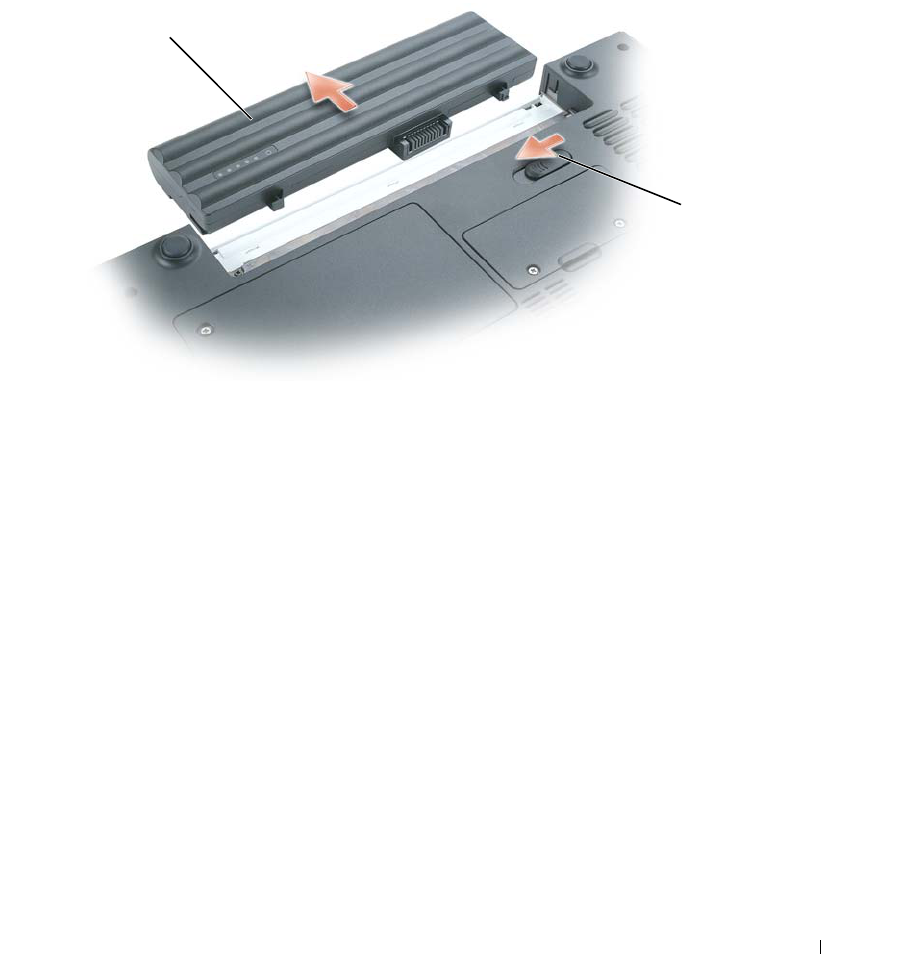
Adding and Replacing Parts 107
4
Disconnect your computer and all attached devices from their electrical outlets.
5
Remove the battery.
Slide and hold the battery-bay latch release on the bottom of the computer, and then pull the
battery out of the battery bay.
6
Remove the optical drive, if installed, from the optical drive bay. See "Optical Drives" on
page 111.
7
Press the power button to ground the system board.
8
Remove any installed ExpressCards from the ExpressCard slot. See "Removing an
ExpressCard or Blank" on page 68.
9
Remove any installed media memory cards from the 5-in-1 media memory card reader. See
"Removing a Media Memory Card or Blank" on page 72.
10
Close the display and turn the computer upside down on a flat work surface.
11
Remove the hard drive. See "Hard Drive" on page 108.
1battery 2battery-bay latch release
2
1
book.book Page 107 Wednesday, September 28, 2005 2:16 PM
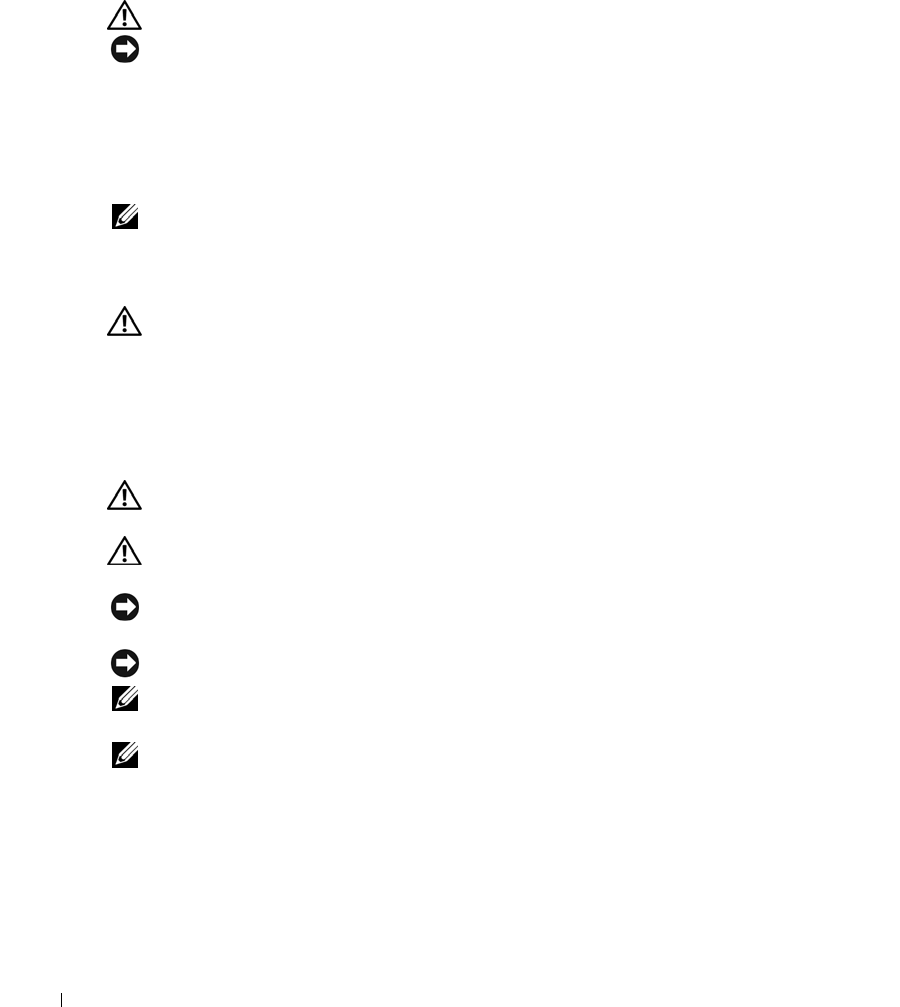
108 Adding and Replacing Parts
www.dell.com | support.dell.com
Battery
Removing a Battery
CAUTION: Before performing these procedures, disconnect the modem from the telephone wall jack.
NOTICE: If you choose to replace the battery with the computer in standby mode, you have up to
1 minute to complete the battery replacement before the computer shuts down and loses any unsaved
data.
1
Ensure that the computer is turned off or suspended in a power management mode.
2
Slide and hold the battery-bay latch release on the bottom of the computer, and then remove
the battery from the bay by pulling it straight out from the computer.
NOTE: The 6-cell battery is flush with the back of the computer. The 9-cell battery extends beyond the
back of the computer.
Installing a Battery
CAUTION: Using an incompatible battery may increase the risk of fire or explosion. Replace the
battery only with a compatible battery purchased from Dell. The battery is designed to work with your
Dell computer. Do not use a battery from other computers with your computer.
Slide the battery into the bay until the latch release clicks.
Hard Drive
CAUTION: If you remove the hard drive from the computer when the drive is hot,
do not touch
the metal
housing of the hard drive.
CAUTION: Before you begin any of the procedures in this section, follow the safety instructions in the
Product Information Guide
.
NOTICE: To prevent data loss, turn off your computer (see page 105) before removing the hard drive. Do
not remove the hard drive while the computer is on, in standby mode, or in hibernate mode.
NOTICE: Hard drives are extremely fragile; even a slight bump can damage the drive.
NOTE: Dell does not guarantee compatibility or provide support for hard drives from sources other
than Dell.
NOTE: If you are installing a hard drive from a source other than Dell, you need to install an operating
system, drivers, and utilities on the new hard drive.
To replace the hard drive in the hard drive bay:
1
Follow the procedures in "Before You Begin" on page 105.
2
Turn the computer over, and loosen the two captive screws in the hard drive cover.
book.book Page 108 Wednesday, September 28, 2005 2:16 PM
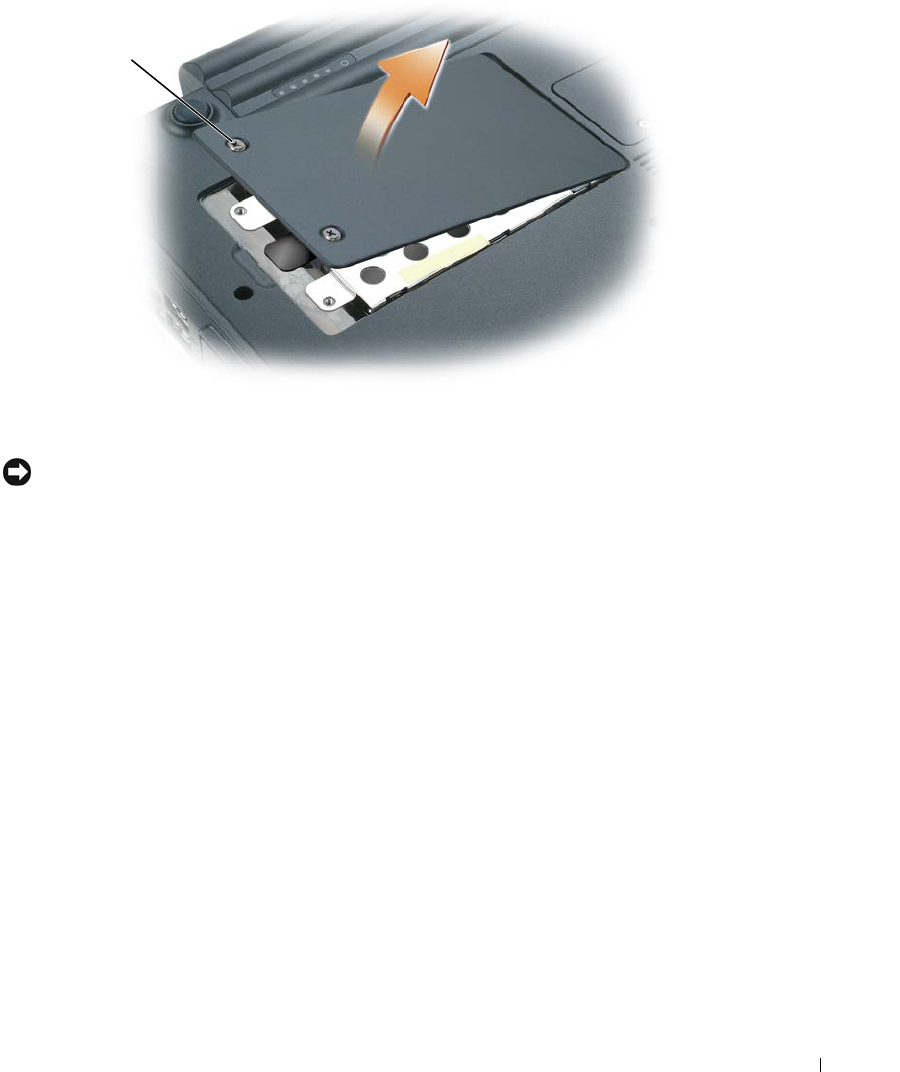
Adding and Replacing Parts 109
NOTICE: When the hard drive is not in the computer, store it in protective antistatic packaging. See
"Protecting Against Electrostatic Discharge" in the Product Information Guide.
3
Lift the cover off the computer and set it aside.
4
Use the pull-tab to slide the hard drive toward the screw holes, and then lift the hard drive
straight up to remove it from the computer.
1screws (2)
1
book.book Page 109 Wednesday, September 28, 2005 2:16 PM
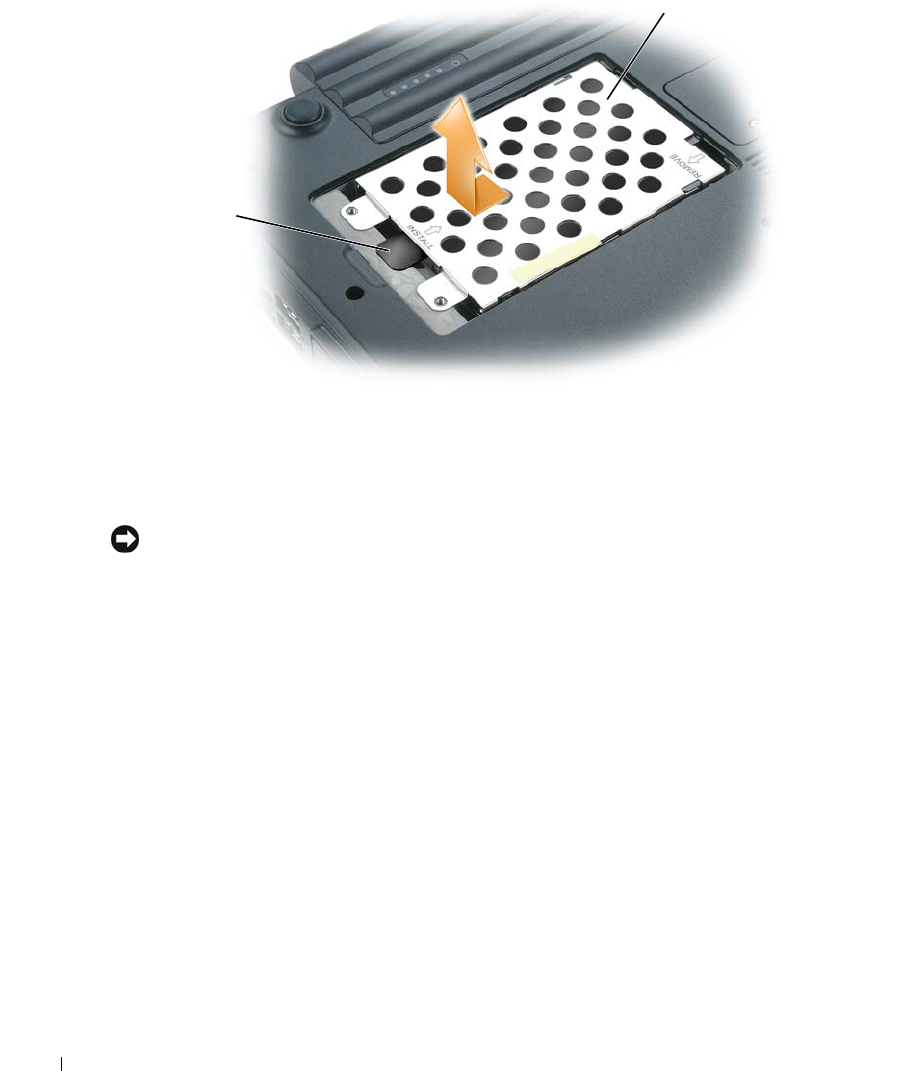
110 Adding and Replacing Parts
www.dell.com | support.dell.com
5
Remove the new drive from its packaging.
Save the original packaging for storing or shipping the hard drive.
NOTICE: Use firm and even pressure to slide the drive into place. If you use excessive force, you may
damage the connector.
6
Seat the new hard drive into the bay, and then slide it into the connector by sliding it away
from the screw holes until it is fully seated.
7
Replace the cover and tighten the screws.
8
Install the operating system for your computer. See "Restoring Your Operating System" on
page 99.
9
Install the drivers and utilities for your computer. See "Reinstalling Drivers and Utilities" on
page 97.
1pull-tab 2hard drive
2
1
book.book Page 110 Wednesday, September 28, 2005 2:16 PM
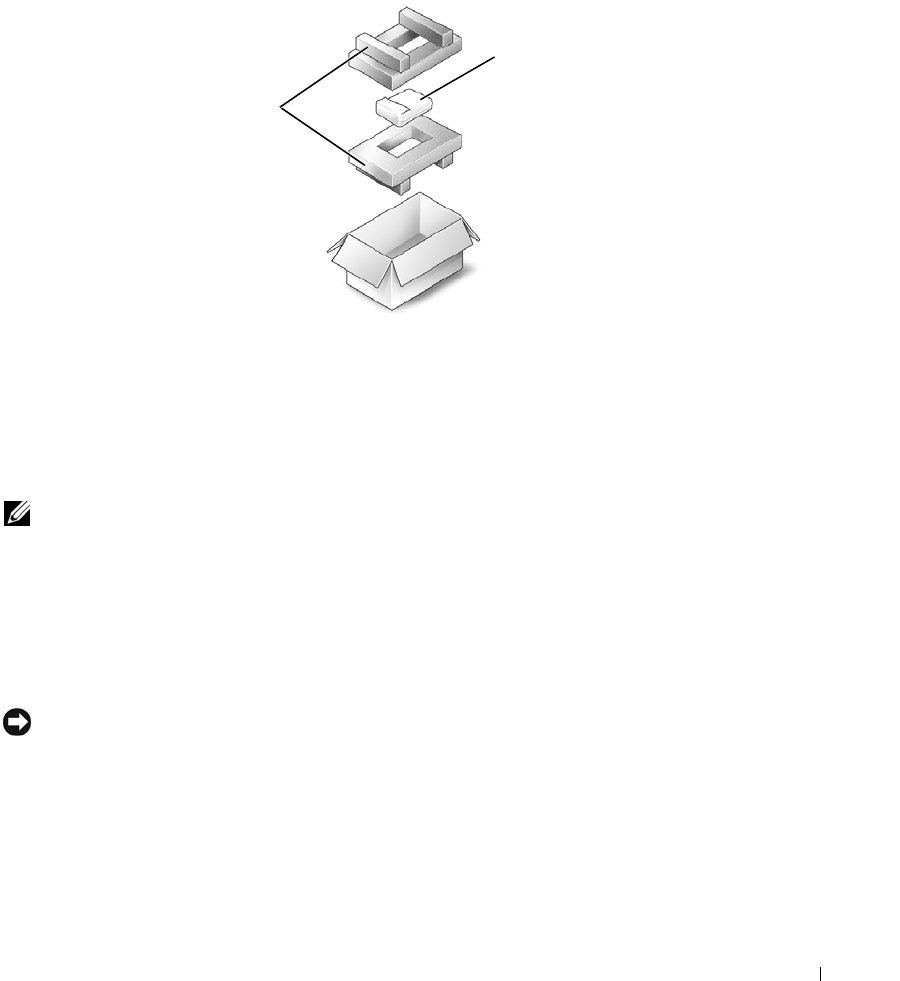
Adding and Replacing Parts 111
Returning a Hard Drive to Dell
Return your old hard drive to Dell in its original or comparable foam packaging. Otherwise, the
hard drive may be damaged in transit.
Optical Drives
About the Device Security Screw
NOTE: You do not need to install the device security screw unless you want to prevent the module from
being easily removed.
Your Dell™ computer ships with an optical drive installed in the module bay and a device security
screw, which may not be installed in the optical drive but packaged separately. When you install a
module in the bay, you can install the device security screw to prevent the module from being easily
removed.
Removing and Installing Optical Drives
NOTICE: To prevent damage to drives, store them in a safe, dry place when they are not installed in the
computer. Avoid pressing down on them or placing heavy objects on top of them.
1
While the computer is turned on
, double-click the
Safely Remove Hardware
icon on the
taskbar, click the device that you want to eject, and click
Stop
.
2
Close your display and turn the computer upside-down.
3
Use a Phillips screwdriver to remove the device security screw from the bottom of the
computer.
1foam packaging 2hard drive
2
1
book.book Page 111 Wednesday, September 28, 2005 2:16 PM
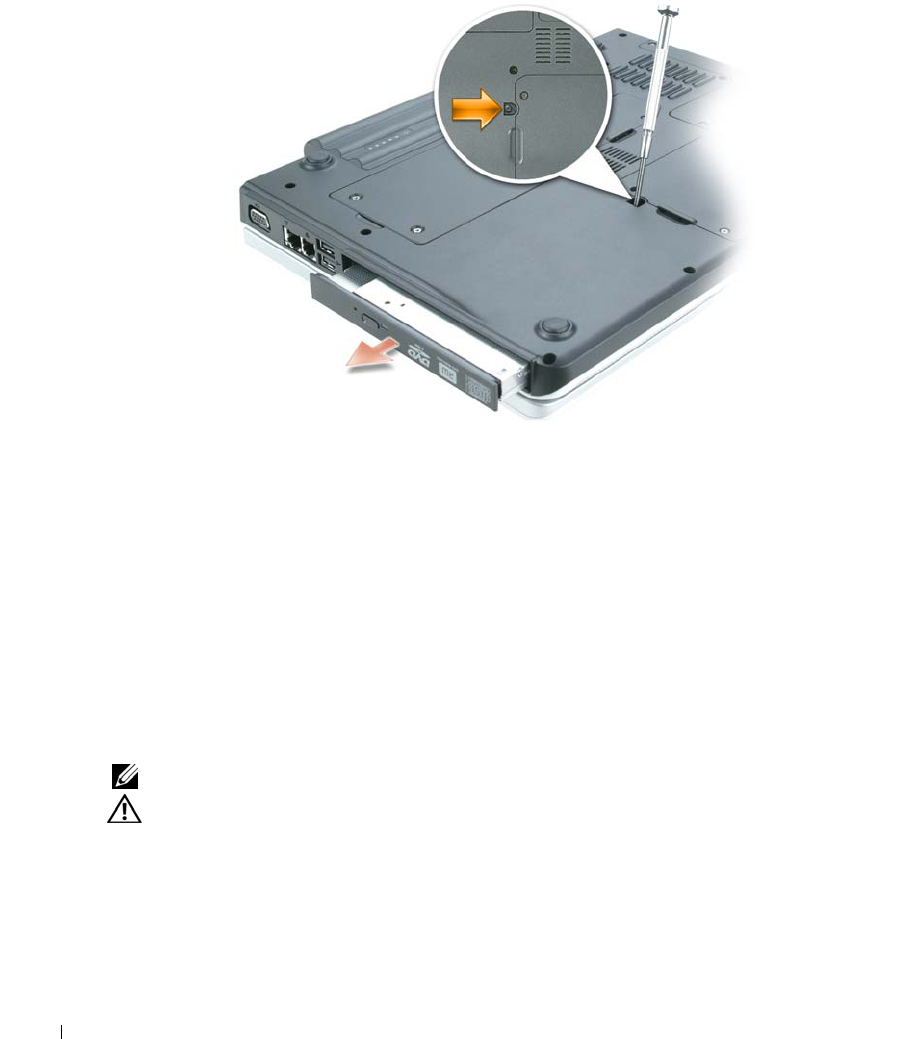
112 Adding and Replacing Parts
www.dell.com | support.dell.com
4
Insert a Phillips screwdriver into the screw hole to push the drive out of the module bay.
5
Pull the drive straight out of the module bay.
6
Push the new drive straight into the module bay until it clicks.
7
Replace the security device screw.
8
Turn the computer right-side up and open the display.
9
The operating system automatically recognizes the drive. If necessary, enter your password to
unlock your computer.
Memory
You can increase your computer memory by installing memory modules on the system board. See
"Specifications" on page 131 for information on the memory supported by your computer. Install
only memory modules that are intended for your computer.
NOTE: Memory modules purchased from Dell are covered under your computer warranty.
CAUTION: Before you begin any of the procedures in this section, follow the safety instructions in the
Product Information Guide
.
The computer has two memory module connectors labeled "DIMM A" and "DIMM B." Connector
DIMM A (located under the keyboard) holds the basic memory module as configured from the
factory. If you did not order additional memory, connector DIMM B (located on the bottom of the
computer under the memory module cover) will be empty. Generally, if you are adding memory,
book.book Page 112 Wednesday, September 28, 2005 2:16 PM
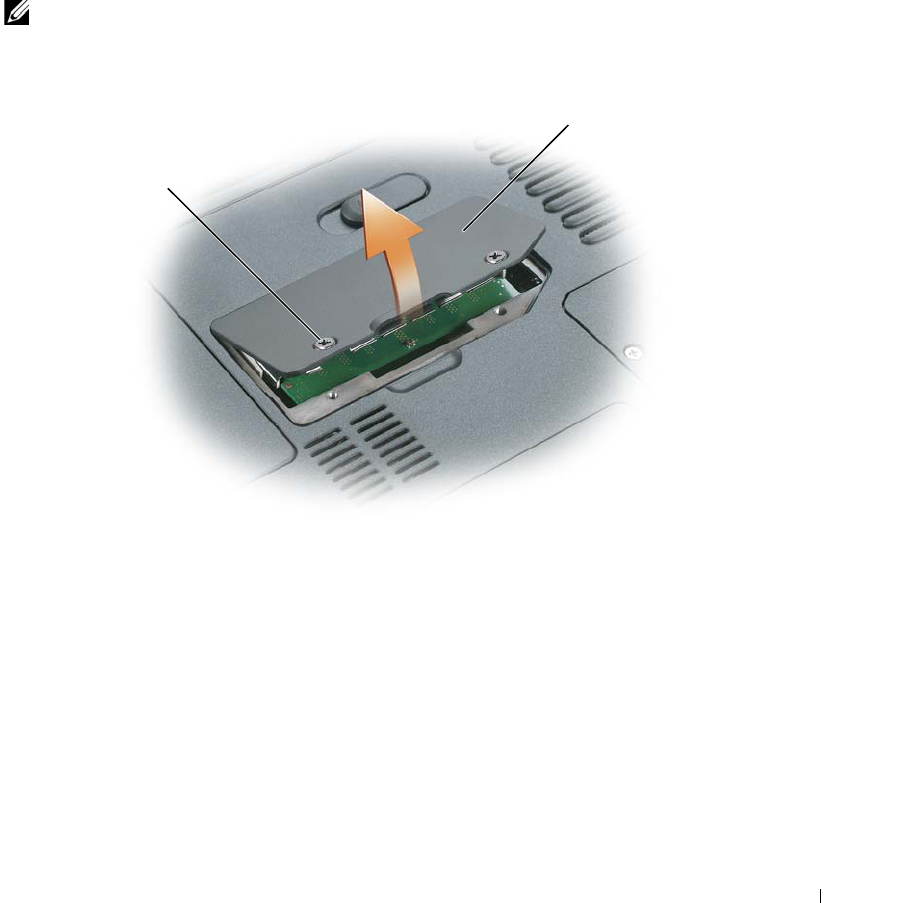
Adding and Replacing Parts 113
you will install a memory module in connector DIMM B. If you are upgrading memory, you may
need to install memory in both the DIMM A and B connectors, depending on the extent of the
upgrade.
Installing a Memory Module in Connector DIMM B
1
Follow the procedures in "Before You Begin" on page 105.
2
Ground yourself by touching one of the metal connectors on the back of the computer.
NOTE: If you leave the area, ground yourself again when you return to the computer.
3
Turn the computer over, loosen the captive screws on the memory module cover, and then
remove the memory module cover.
1screws (2) 2memory module cover
1
2
book.book Page 113 Wednesday, September 28, 2005 2:16 PM
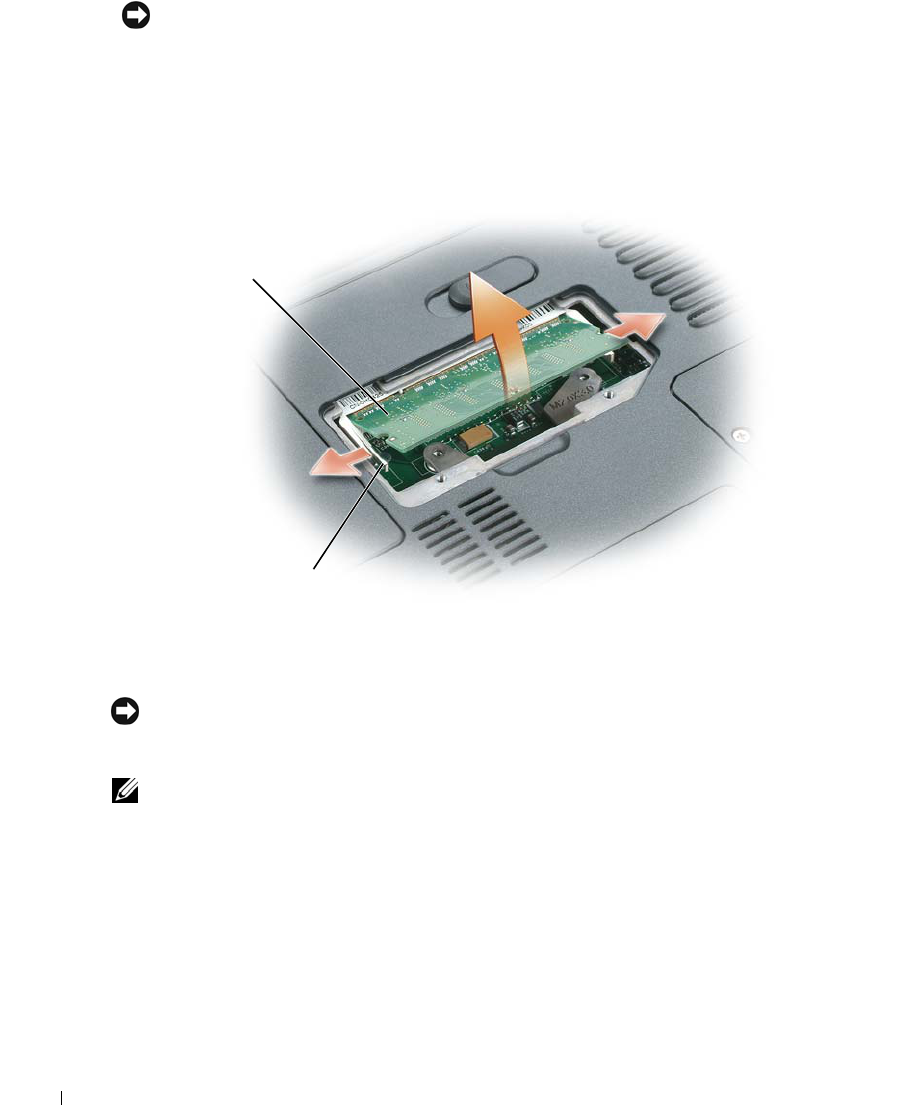
114 Adding and Replacing Parts
www.dell.com | support.dell.com
NOTICE: To prevent damage to the memory module connector, do not use tools to spread the memory-
module securing clips.
4
If you are replacing a memory module, remove the existing module:
a
Use your fingertips to carefully spread apart the securing clips on each end of the memory
module connector until the module pops up.
b
Remove the module from the connector.
NOTICE: If you need to install memory modules in two connectors, install a memory module in the
connector labeled “DIMM A” before you install a module in the connector labeled “DIMM B.” Insert
memory modules at a 45-degree angle to avoid damaging the connector.
NOTE: If the memory module is not installed properly, the computer may not boot properly. No error
message indicates this failure.
5
Ground yourself and install the new memory module:
a
Align the notch in the module edge connector with the tab in the connector slot.
b
Slide the module firmly into the slot at a 45-degree angle, and rotate the module down
until it clicks into place. If you do not feel the click, remove the module and reinstall it.
1memory module 2securing clips
(2 per connector)
1
2
book.book Page 114 Wednesday, September 28, 2005 2:16 PM
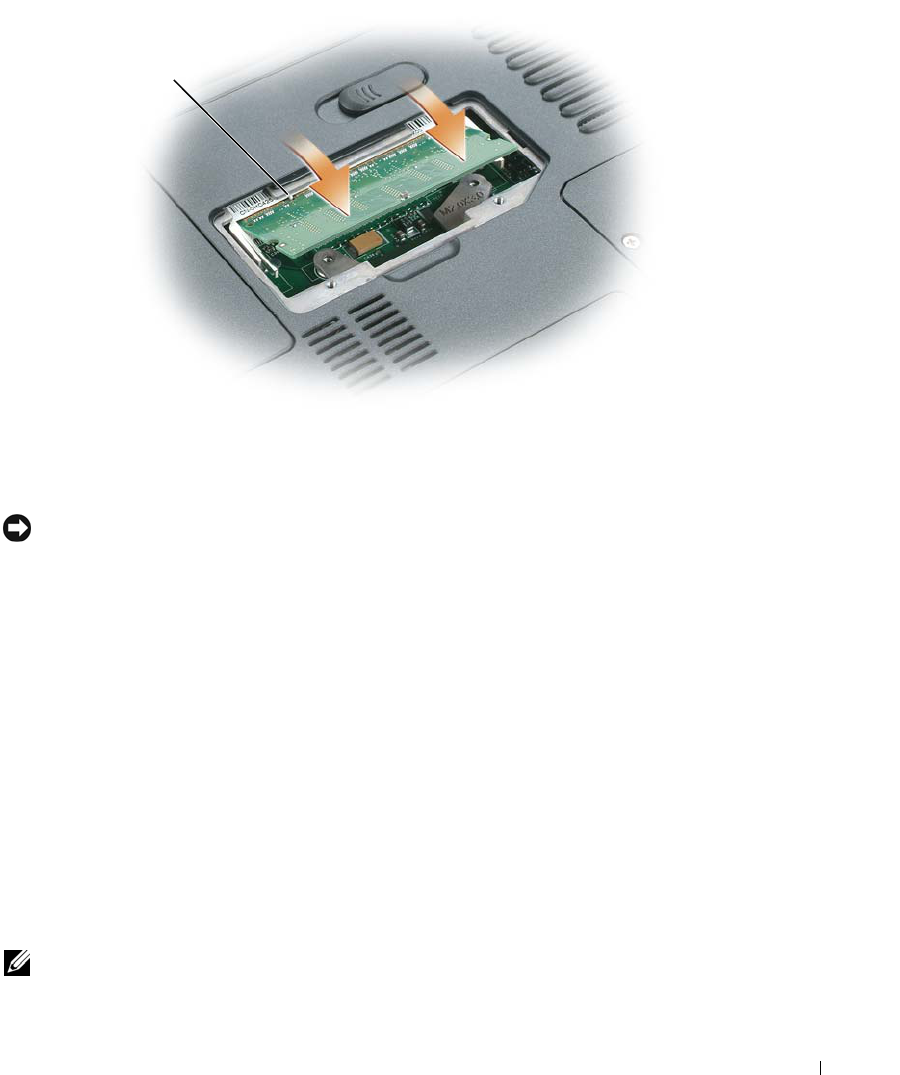
Adding and Replacing Parts 115
6
Replace the memory module cover and tighten the screws.
NOTICE: If the cover is difficult to close, remove the module and reinstall it. Forcing the cover to close
may damage your computer.
7
Insert the battery into the battery bay, or connect the AC adapter to your computer and an
electrical outlet.
8
Reinstall the hard drive. See "Hard Drive" on page 108.
9
Turn on the computer.
As the computer boots, it detects the additional memory and automatically updates the system
configuration information.
To confirm the amount of memory installed in the computer, click the
Start
button, click
Help and
Support
, and then click
Computer Information
.
Installing a Memory Module in Connector DIMM A
The memory module connector labeled "DIMM A" is located under the keyboard.
1
Follow the procedures in "Before You Begin" on page 105.
2
Ground yourself by touching one of the metal connectors on the back of the computer.
NOTE: If you leave the area, ground yourself again when you return to the computer.
1tab in connector slot
1
book.book Page 115 Wednesday, September 28, 2005 2:16 PM
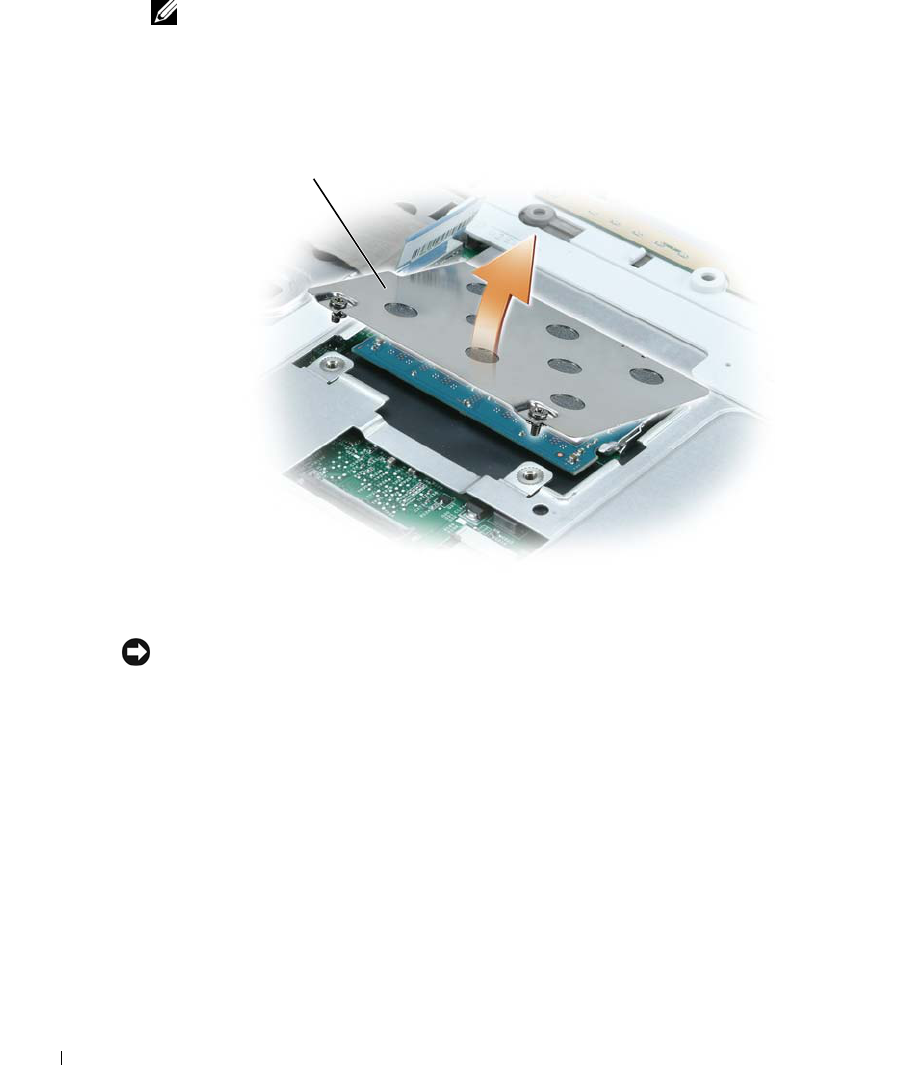
116 Adding and Replacing Parts
www.dell.com | support.dell.com
3
Remove the hinge cover. See "Hinge Cover" on page 123.
NOTE: Ensure that you remove the two screws in the battery bay as part of the hinge removal
procedure.
4
Remove the keyboard. See "Keyboard" on page 125.
5
Loosen the captive screws on the memory module cover, and then remove the memory
module cover.
NOTICE: To prevent damage to the memory module connector, do not use tools to spread the memory-
module securing clips.
6
If you are replacing a memory module, remove the existing module:
a
Use your fingertips to carefully spread apart the securing clips on each end of the memory
module connector until the module pops up.
b
Remove the module from the connector.
1tab in connector slot
1
book.book Page 116 Wednesday, September 28, 2005 2:16 PM
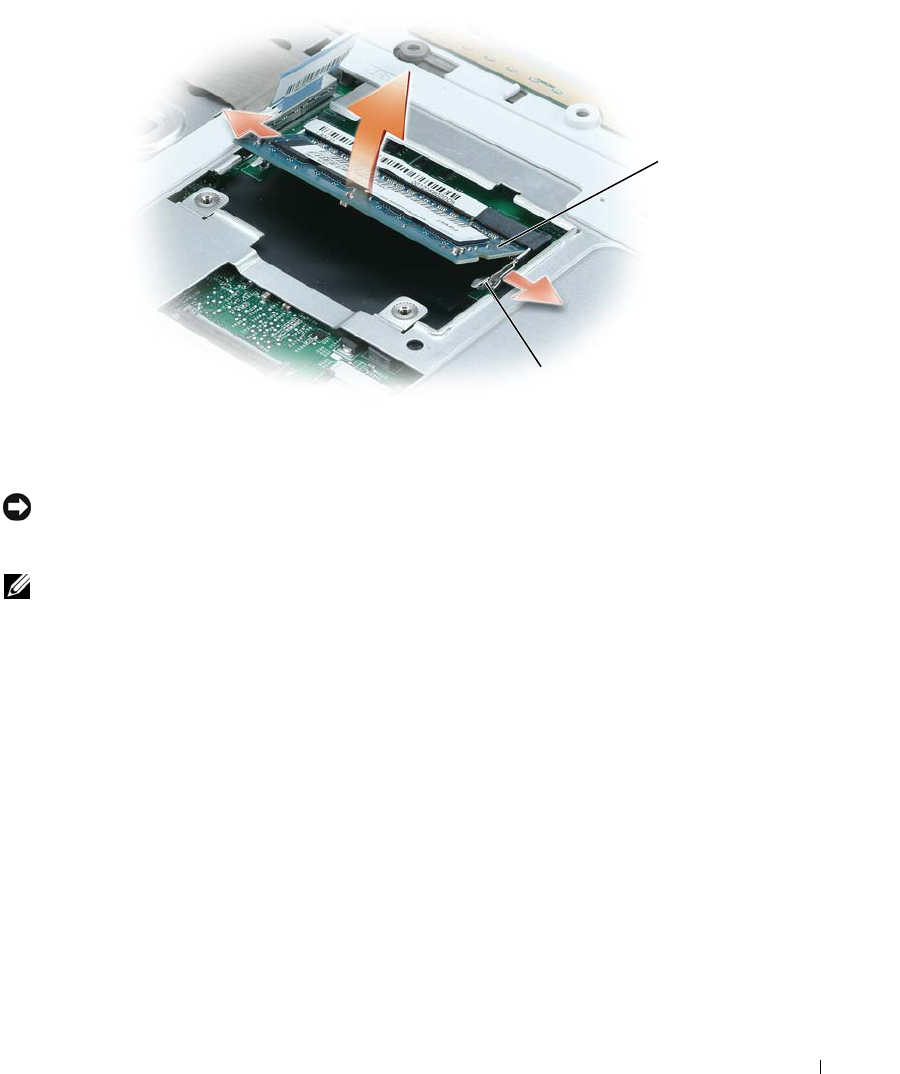
Adding and Replacing Parts 117
NOTICE: If you need to install memory modules in two connectors, install a memory module in the
connector labeled “DIMM A” before you install a module in the connector labeled “DIMM B.” Insert
memory modules at a 45-degree angle to avoid damaging the connector.
NOTE: If the memory module is not installed properly, the computer may not boot properly. No error
message indicates this failure.
7
Ground yourself and install the new memory module:
a
Align the notch in the module edge connector with the tab in the connector slot.
b
Slide the module firmly into the slot at a 45-degree angle, and rotate the module down
until it clicks into place. If you do not feel the click, remove the module and reinstall it.
1memory module 2securing clips
(2 per connector)
1
2
book.book Page 117 Wednesday, September 28, 2005 2:16 PM
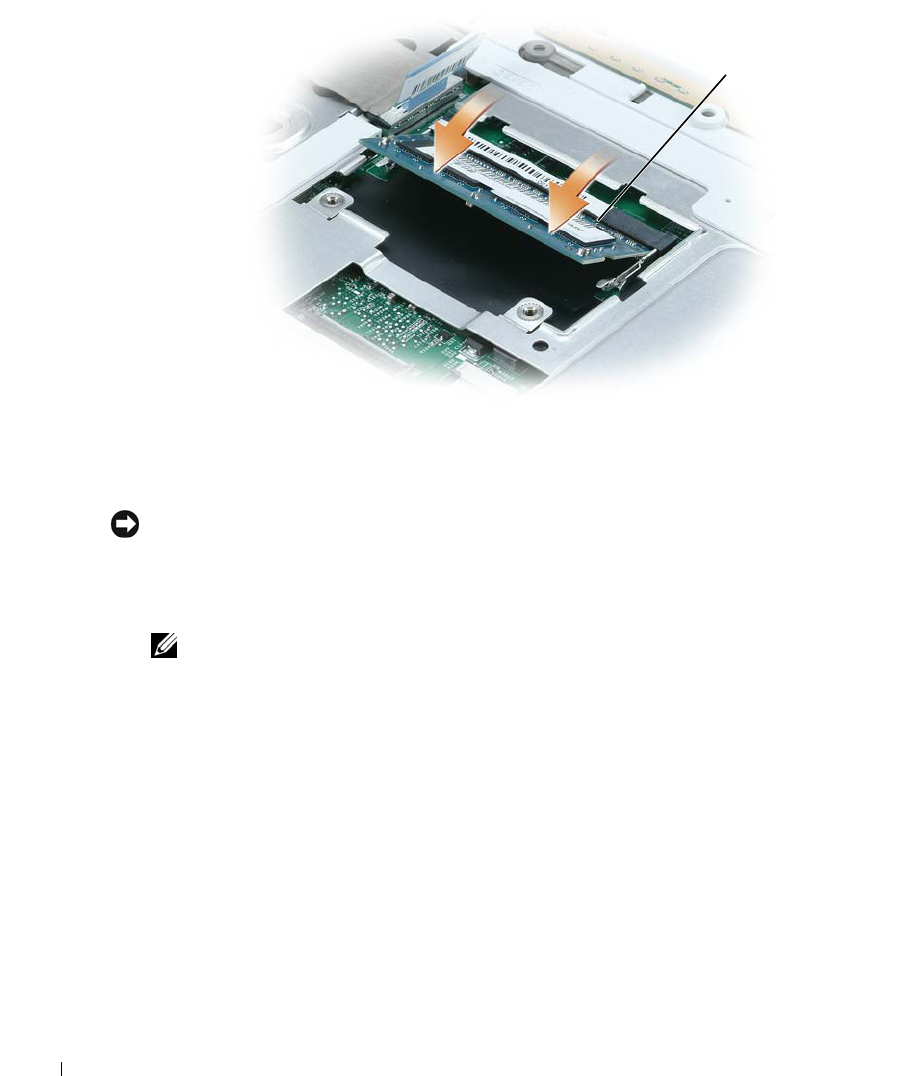
118 Adding and Replacing Parts
www.dell.com | support.dell.com
8
Replace the memory module cover and tighten the screws.
NOTICE: If the cover is difficult to close, remove the module and reinstall it. Forcing the cover to close
may damage your computer.
9
Replace the keyboard. See "Keyboard" on page 125.
10
Replace the hinge cover. See "Hinge Cover" on page 123.
NOTE: Ensure that you replace the two screws inside the battery bay as part of the hinge
replacement procedure.
11
Insert the battery into the battery bay, or connect the AC adapter to your computer and an
electrical outlet.
12
Reinstall the hard drive. See "Hard Drive" on page 108.
13
Turn on the computer.
As the computer boots, it detects the additional memory and automatically updates the system
configuration information.
To confirm the amount of memory installed in the computer, click the
Start
button, click
Help and
Support
, and then click
Computer Information
.
1tab in connector slot
1
book.book Page 118 Wednesday, September 28, 2005 2:16 PM
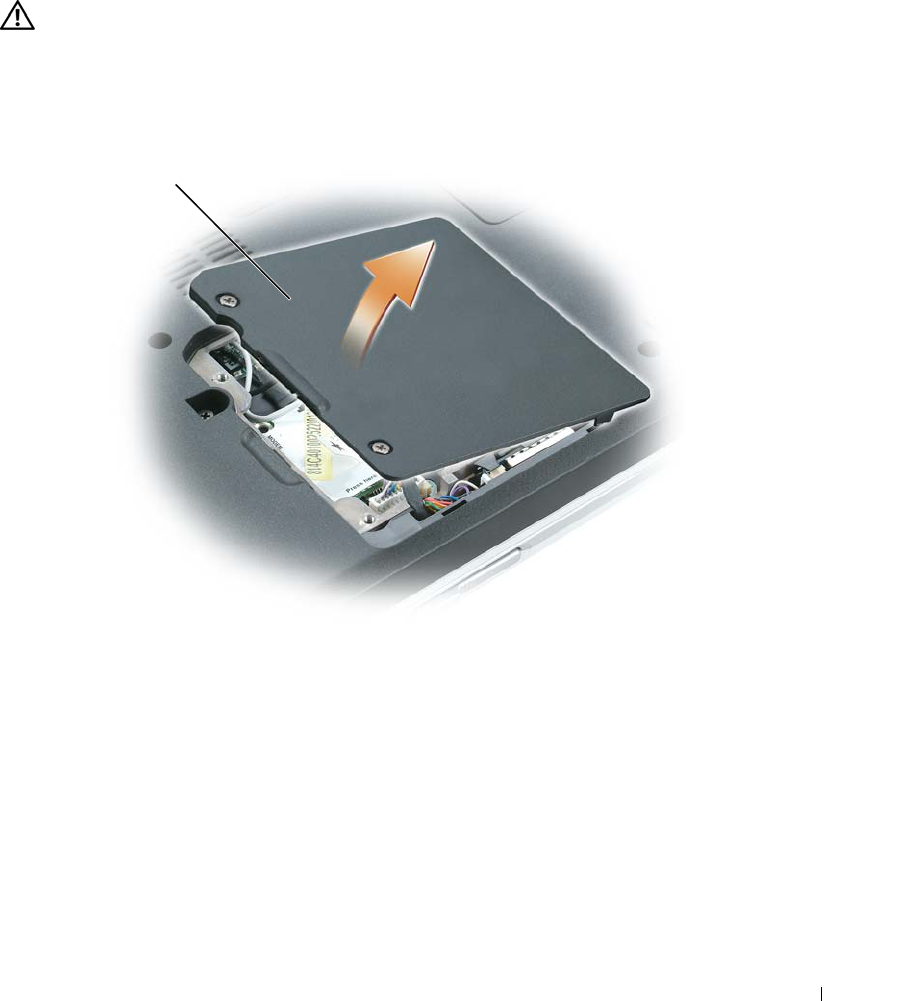
Adding and Replacing Parts 119
Modem (Optional)
If you ordered the optional modem at the same time that you ordered your computer, the modem
is already installed.
CAUTION: Before you begin any of the procedures in this section, follow the safety instructions in the
Product Information Guide
.
1
Follow the procedures in "Before You Begin" on page 105.
2
Turn the computer over, loosen the captive screws on the modem/Mini PCI/wireless cover,
and then remove the cover.
1
modem/Mini
PCI/wireless
cover
1
book.book Page 119 Wednesday, September 28, 2005 2:16 PM
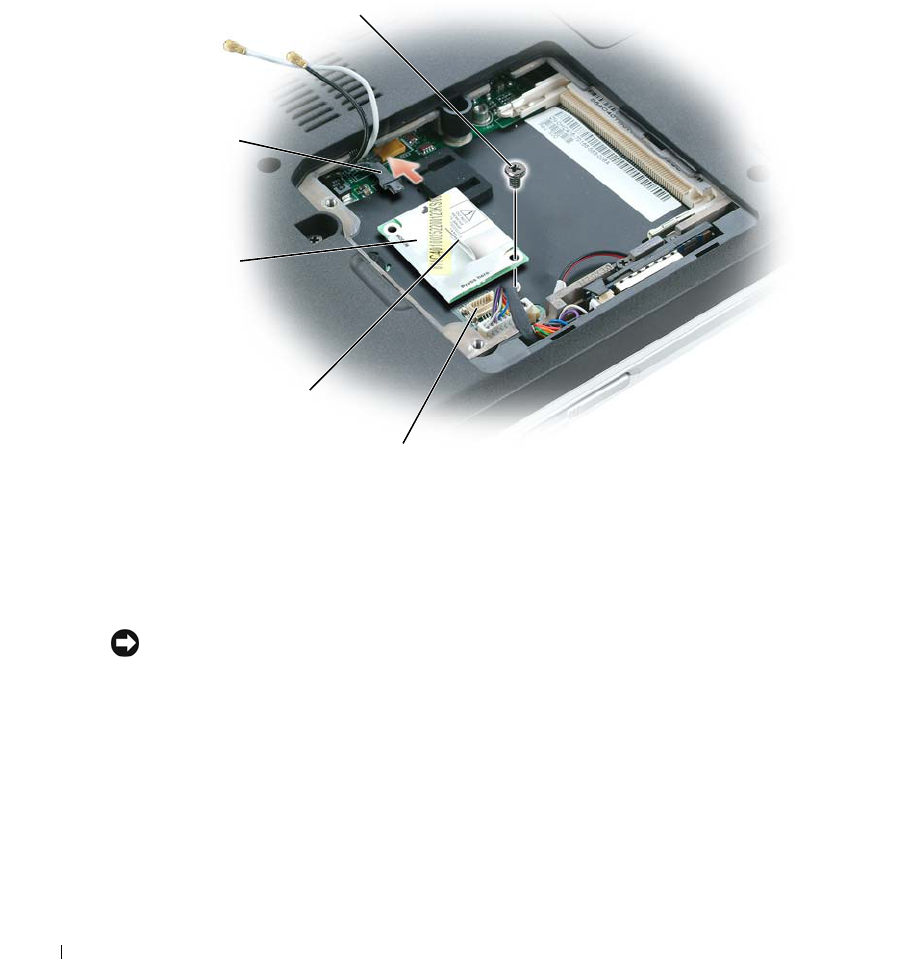
120 Adding and Replacing Parts
www.dell.com | support.dell.com
3
Remove the existing modem:
a
Remove the screw securing the modem to the system board, and set it aside.
b
Pull straight up on the attached pull-tab to lift the modem out of its connector on the
system board, and disconnect the modem cable.
4
Install the replacement modem:
a
Connect the modem cable to the modem.
NOTICE: The connectors are keyed to ensure correct insertion. If you feel resistance, check the
connectors and realign the card.
b
Align the modem with the screw holes and press the modem into the connector on the
system board.
c
Replace the screw that secures the modem to the system board.
5
Replace the modem/Mini PCI/wireless cover.
1screw 3modem 5system board connector
2modem cable 4pull-tab
4
5
1
2
3
book.book Page 120 Wednesday, September 28, 2005 2:16 PM
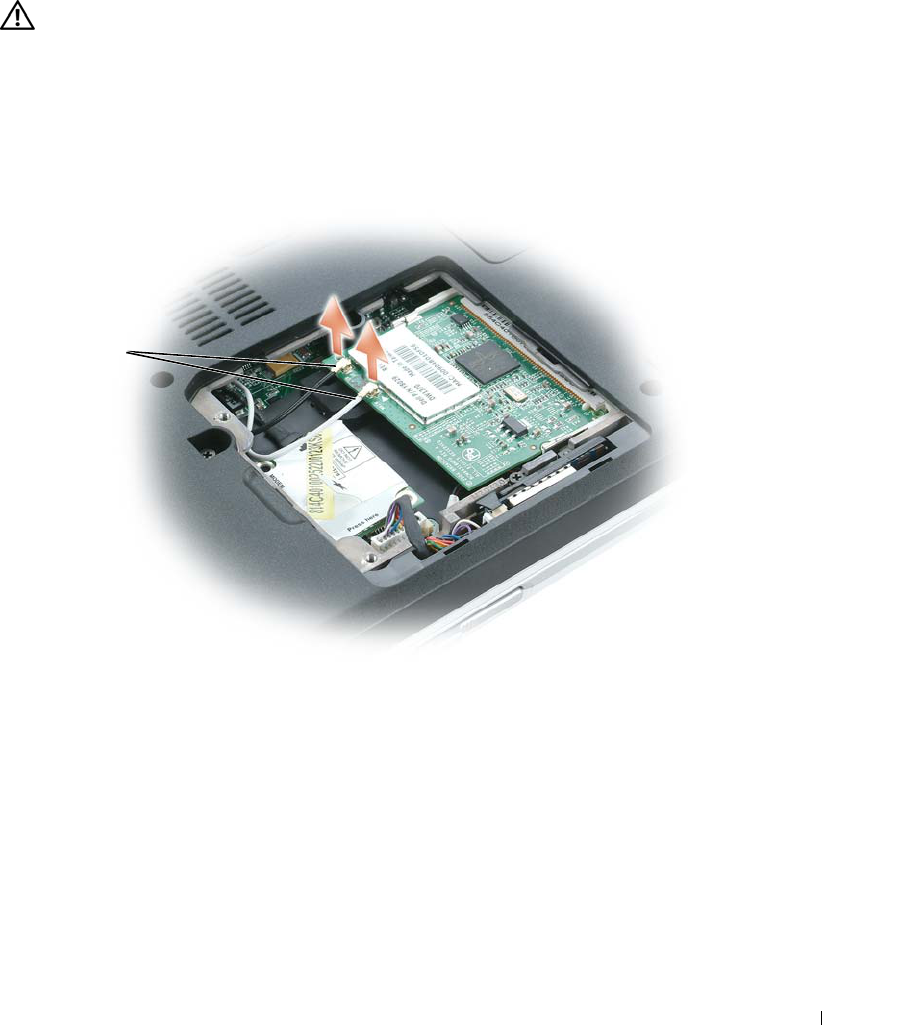
Adding and Replacing Parts 121
Wireless Mini PCI Card
If you ordered a Mini PCI card with your computer, the card is already installed.
CAUTION: Before you begin any of the procedures in this section, follow the safety instructions in the
Product Information Guide
.
1
Follow the procedures in "Before You Begin" on page 105.
2
If a Mini PCI card is not already installed, go to step . If you are replacing a Mini PCI card,
remove the existing card:
a
Disconnect the antenna cables from the Mini PCI card.
b
Release the Mini PCI card by spreading the metal securing tabs until the card pops up
slightly.
c
Lift the Mini PCI card out of its connector.
1
antenna cables
1
book.book Page 121 Wednesday, September 28, 2005 2:16 PM
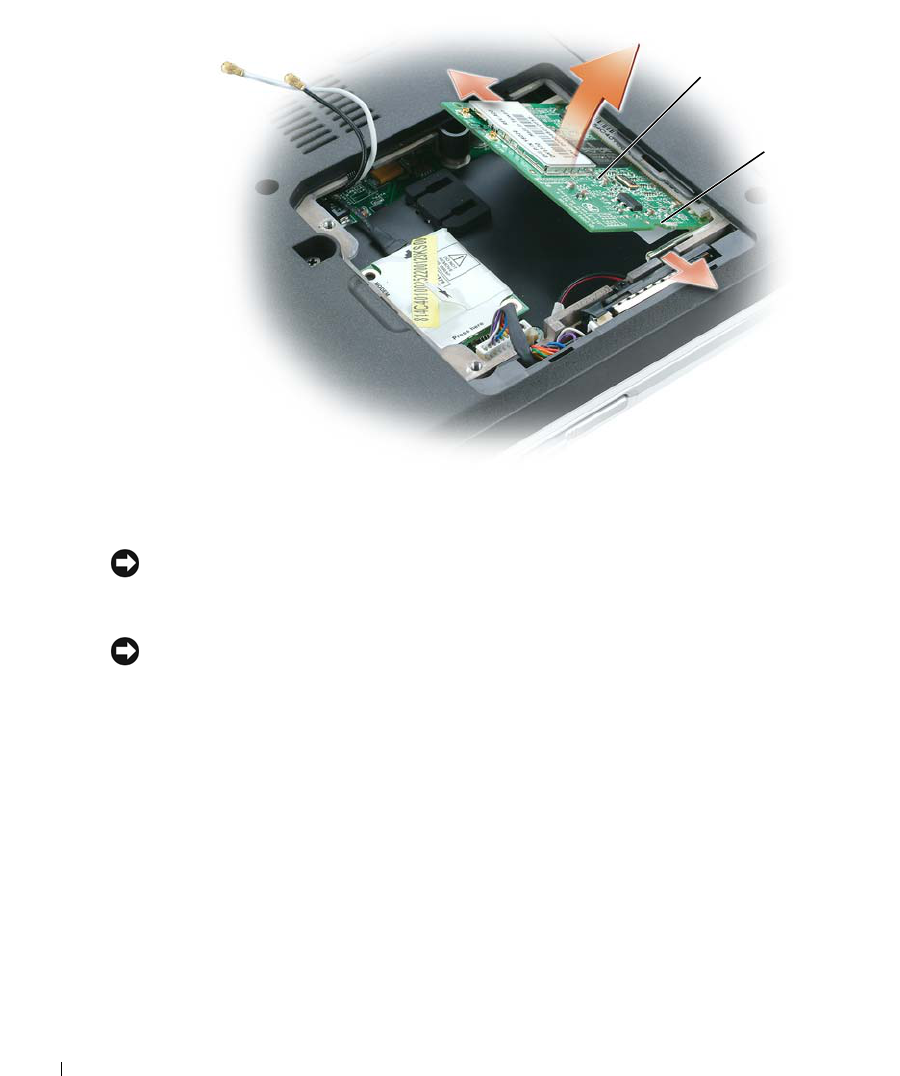
122 Adding and Replacing Parts
www.dell.com | support.dell.com
NOTICE: The connectors are keyed to ensure correct insertion. If you feel resistance, check the
connectors and realign the card.
3
Install the replacement Mini PCI card:
NOTICE: To avoid damaging the Mini PCI card, make sure the antenna cables are not under the card
when you click the card into place.
a
Align the Mini PCI card with the connector at a 45-degree angle, and press the Mini PCI
card into the connector until it clicks.
b
Connect the antenna cables to the Mini PCI card. Make sure the cables snap onto the
tiny connectors on the Mini PCI card.
1Mini PCI card 2metal securing tabs (2)
1
2
book.book Page 122 Wednesday, September 28, 2005 2:16 PM
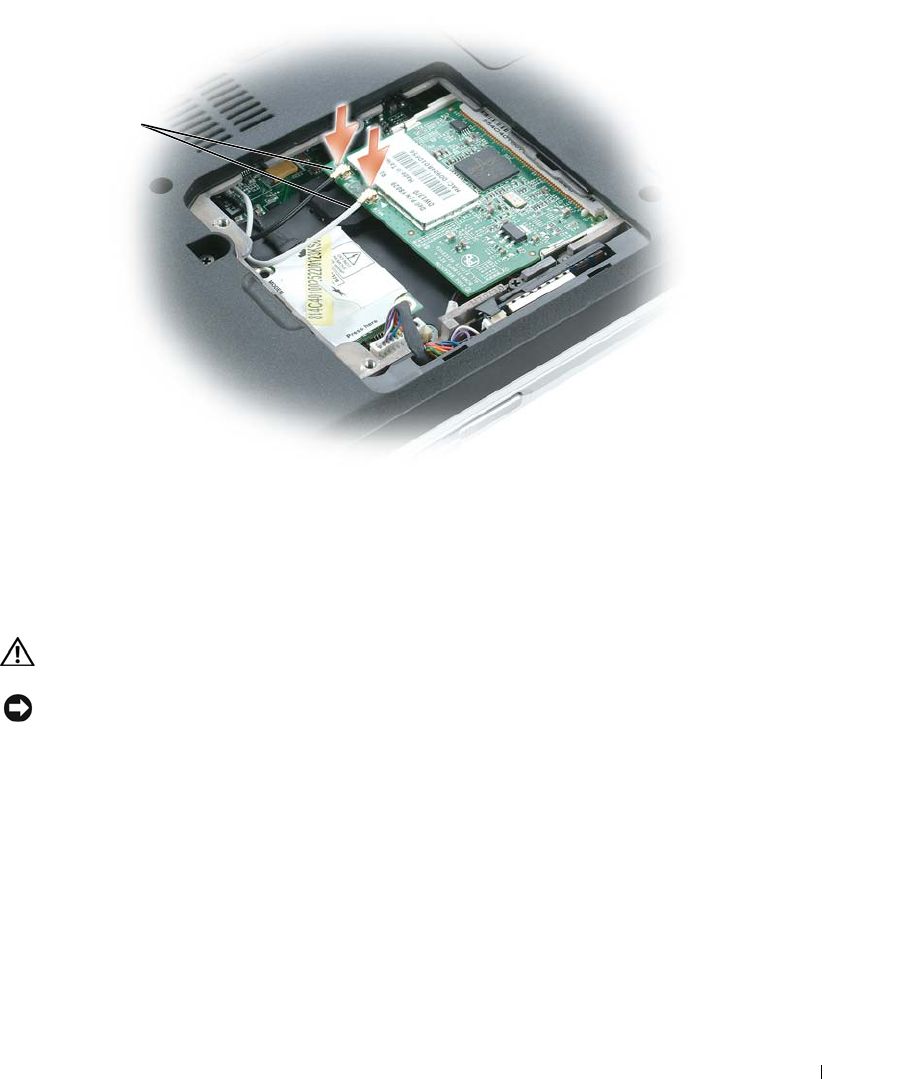
Adding and Replacing Parts 123
Hinge Cover
Removing the Hinge Cover
CAUTION: Before you begin any of the procedures in this section, follow the safety instructions in the
Product Information Guide
.
NOTICE: To avoid electrostatic discharge, ground yourself by using a wrist grounding strap or by
periodically touching an unpainted metal surface (such as a connector on the back of the computer).
1
antenna cables
1
book.book Page 123 Wednesday, September 28, 2005 2:16 PM
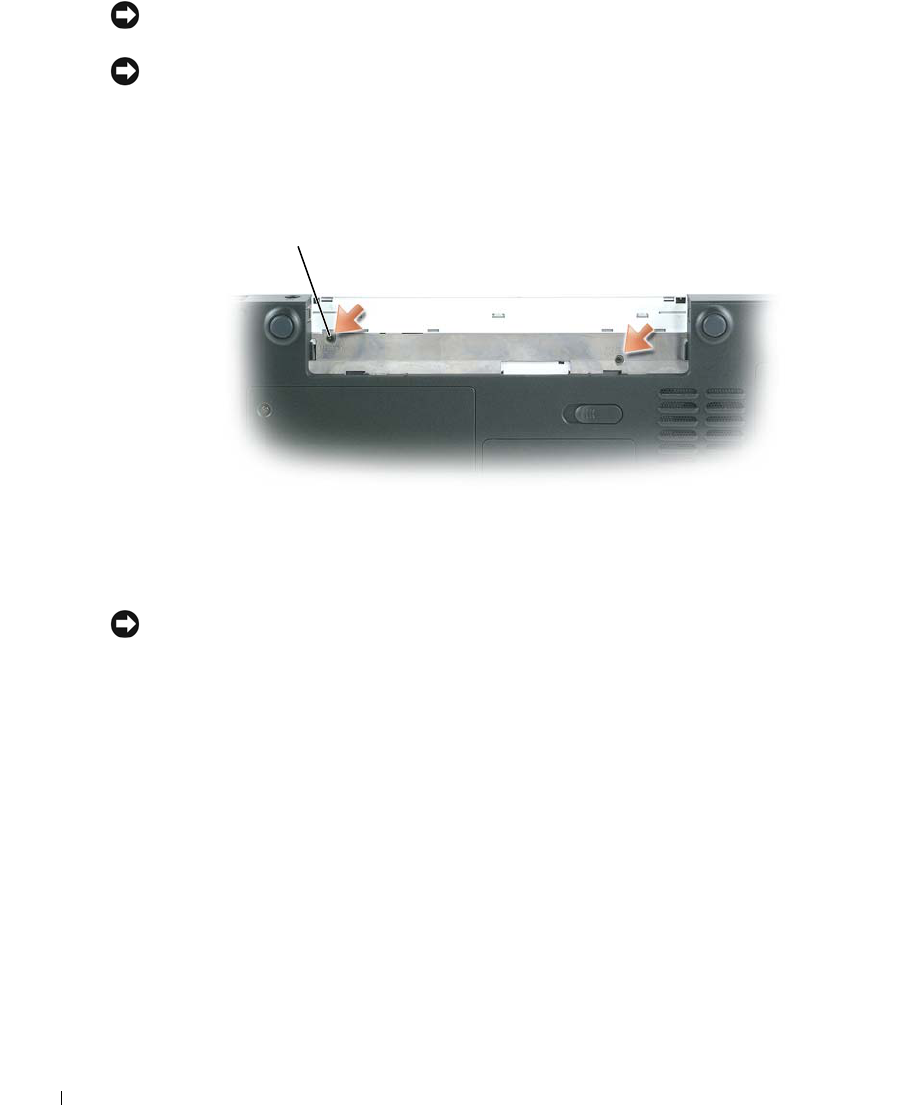
124 Adding and Replacing Parts
www.dell.com | support.dell.com
NOTICE: To avoid damaging the system board, you must remove the main battery before you begin
working inside the computer.
NOTICE: The hinge cover is fragile and can be damaged if extreme force is used. Be careful when
removing the hinge cover.
1
Follow the procedures in "Before You Begin" on page 105.
2
Remove the battery (see page 108).
3
Remove the two screws inside the battery bay.
4
Turn the computer right-side up, and then open the display all the way (180 degrees) so that
it rests on your work surface.
NOTICE: To avoid damaging the hinge cover, do not lift the cover on both sides simultaneously.
5
Insert a scribe into the indent to lift the hinge cover on the right side.
1screws (2)
1
book.book Page 124 Wednesday, September 28, 2005 2:16 PM
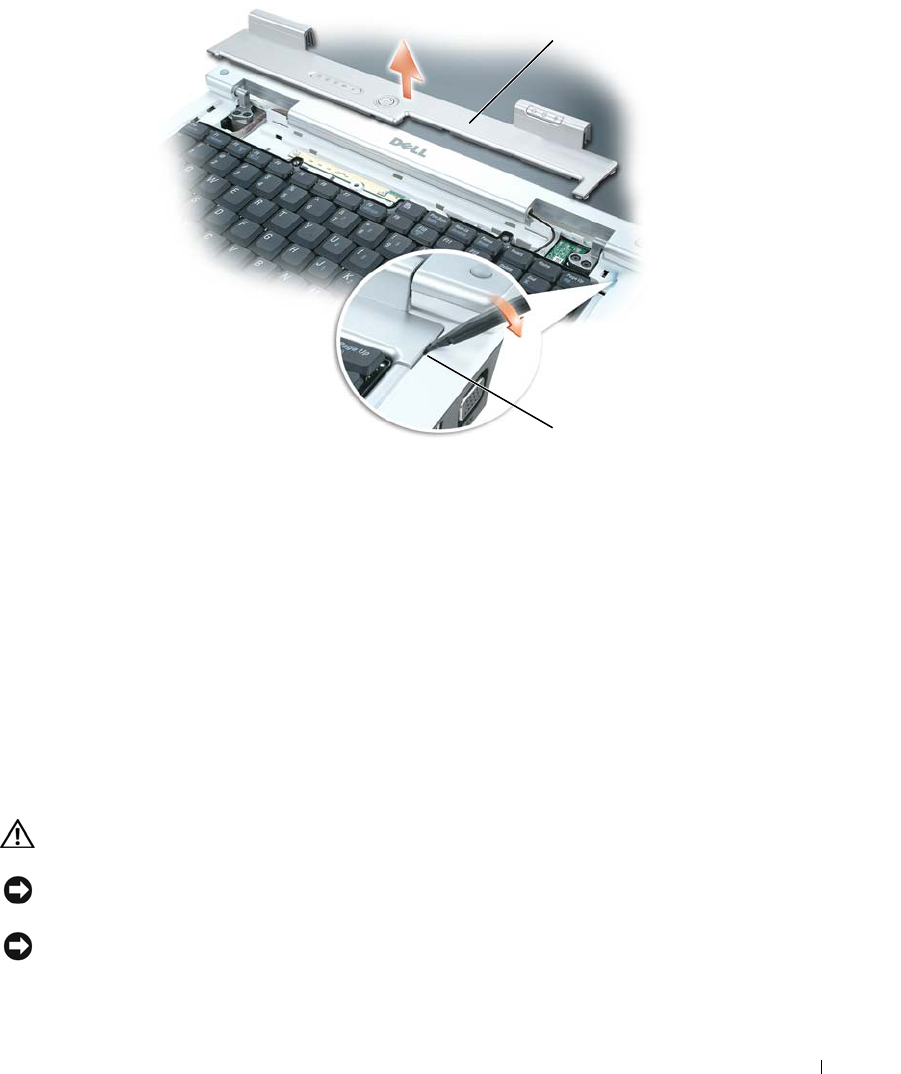
Adding and Replacing Parts 125
6
Ease the hinge cover up, moving from right to left, and remove it.
Replacing the Hinge Cover
1
Insert the left edge of the cover into place.
2
Press from left to right until the cover snaps into place.
3
Close the display and turn the computer upside down.
4
Replace the two screws in the battery bay.
5
Replace the battery (see page 108).
Keyboard
CAUTION: Before you begin any of the procedures in this section, follow the safety instructions in the
Product Information Guide
.
NOTICE: To avoid electrostatic discharge, ground yourself by using a wrist grounding strap or by
periodically touching an unpainted metal surface (such as a connector on the back of the computer).
NOTICE: To avoid damaging the system board, you must remove the main battery before you begin
working inside the computer.
1hinge cover 2indent
1
2
book.book Page 125 Wednesday, September 28, 2005 2:16 PM
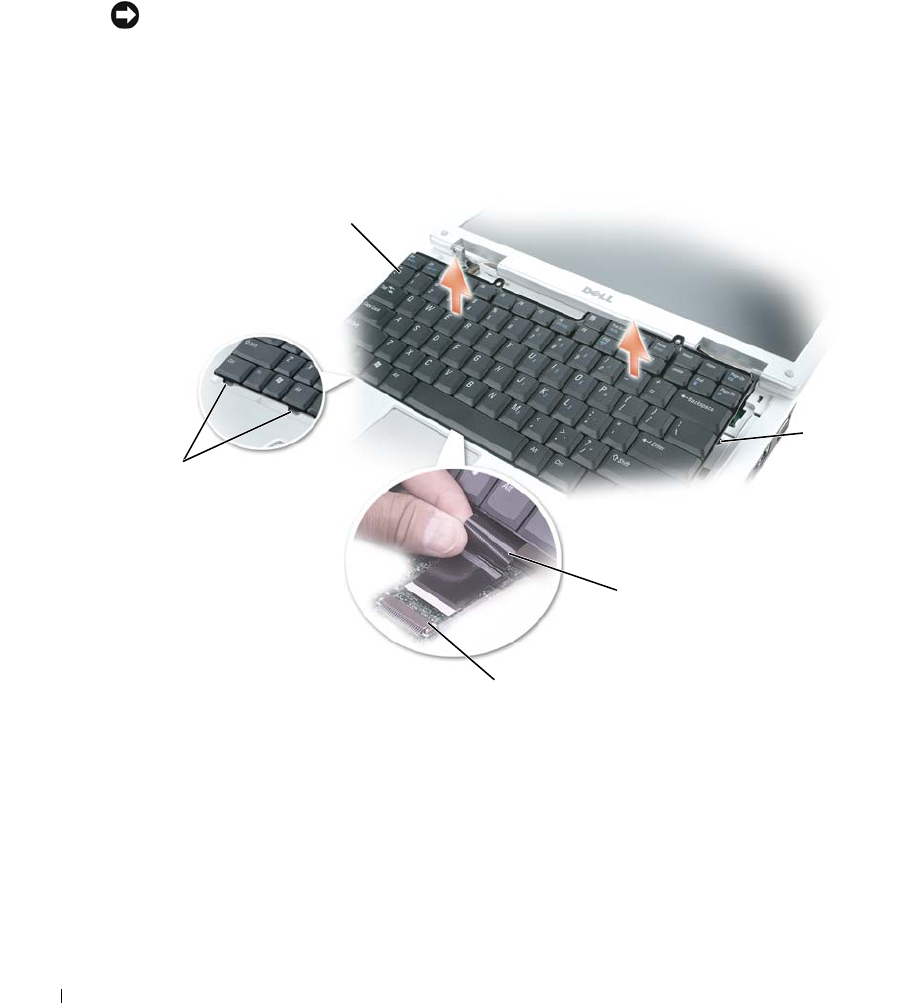
126 Adding and Replacing Parts
www.dell.com | support.dell.com
Removing the Keyboard
1
Follow the procedures in "Before You Begin" on page 105.
2
Remove the hinge cover. See "Hinge Cover" on page 123.
NOTICE: The keycaps on the keyboard are fragile, easily dislodged, and time-consuming to replace. Be
careful when removing and handling the keyboard.
3
Lift the keyboard and hold it up and slightly forward to allow access to the keyboard
connector.
4
Release the lever on the system board connector to disconnect the keyboard cable from the
system board.
1keyboard 3keyboard cable 5tabs (6)
2side tabs (2) 4lever on system board connector
5
1
4
3
2
book.book Page 126 Wednesday, September 28, 2005 2:16 PM

Adding and Replacing Parts 127
Replacing the Keyboard
NOTICE: To avoid scratching the palm rest when replacing the keyboard, hook the six tabs along the
front edge of the keyboard into the palm rest, and then secure the keyboard in place.
1
Connect the keyboard cable to the system board.
2
Place the six tabs along the front edge of the keyboard into the palm rest.
3
Fasten the keyboard cable with the lever on the system board connector.
4
Snap the keyboard into place under the two side tabs.
Internal Card With Bluetooth® Wireless Technology
CAUTION: Before you begin any of the procedures in this section, follow the safety instructions in the
Product Information Guide
.
NOTICE: To avoid electrostatic discharge, ground yourself by using a wrist grounding strap or by
periodically touching an unpainted metal surface (such as a connector on the back of the computer).
NOTICE: To avoid damaging the system board, you must remove the main battery before you begin
working inside the computer.
If you ordered a card with Bluetooth wireless technology with your computer, the card is already
installed.
1
Follow the procedures in "Before You Begin" on page 105.
2
Loosen the captive screws in the modem/Mini PCI/wireless cover, and then remove the cover.
3
Remove the screw securing the card carrier.
4
Pull the carrier out of the compartment so that you can disconnect the card from its cable and
remove the card from the computer.
5
To replace the card, connect the card to the cable.
6
Then carefully insert the card into the carrier and insert the carrier into the compartment.
7
Replace the screw securing the card carrier into place.
book.book Page 127 Wednesday, September 28, 2005 2:16 PM
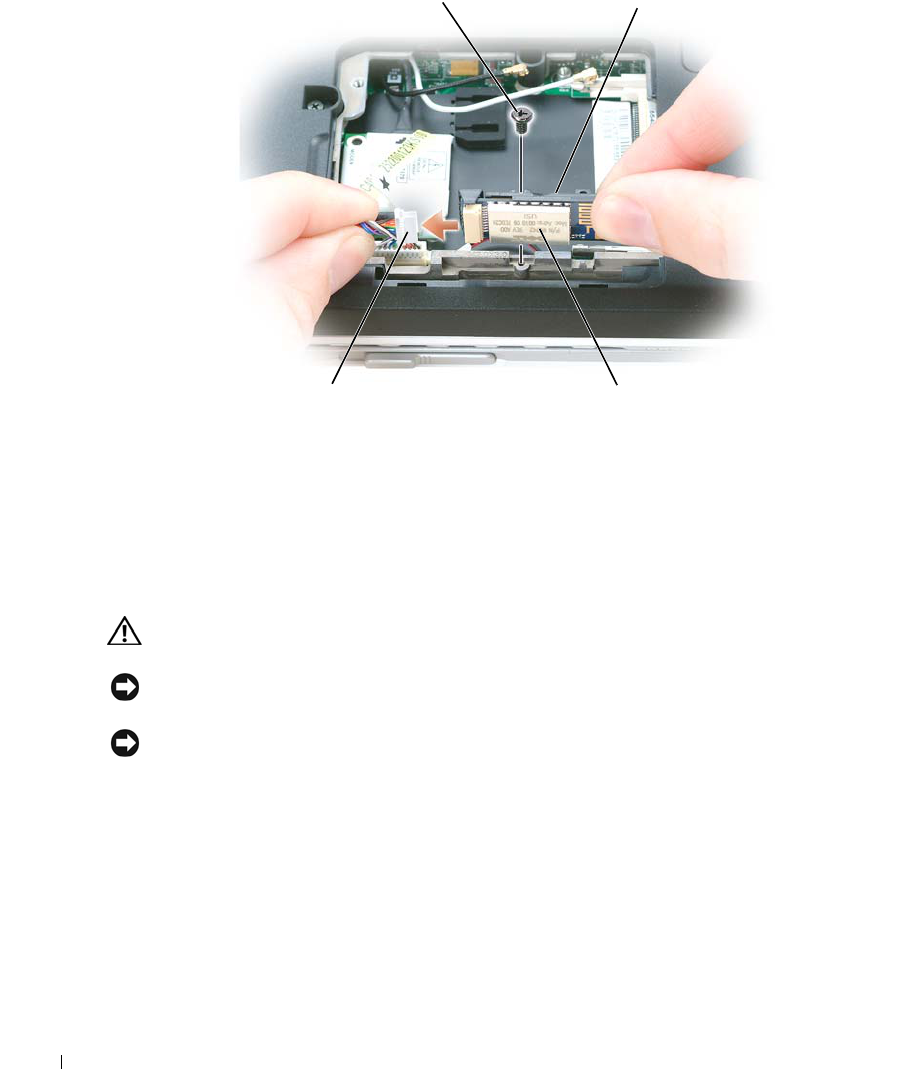
128 Adding and Replacing Parts
www.dell.com | support.dell.com
Coin-Cell Battery
Removing the Coin-Cell Battery
CAUTION: Before you perform the following procedures, see the safety instructions in the
Product
Information Guide
.
NOTICE: To avoid electrostatic discharge, ground yourself by using a wrist grounding strap or by
periodically touching an unpainted metal surface (such as the back panel) on the computer.
NOTICE: To avoid damaging the system board, you must remove the main battery before you begin
working inside the computer.
1
Follow the procedures in "Before You Begin" on page 105.
2
Remove the hinge cover (see page 123).
3
Remove the keyboard (see page 125).
4
Use a plastic scribe to lift the battery upward to remove it from the system board.
1screw 3card
2card carrier 4card connector
1
3
4
2
book.book Page 128 Wednesday, September 28, 2005 2:16 PM
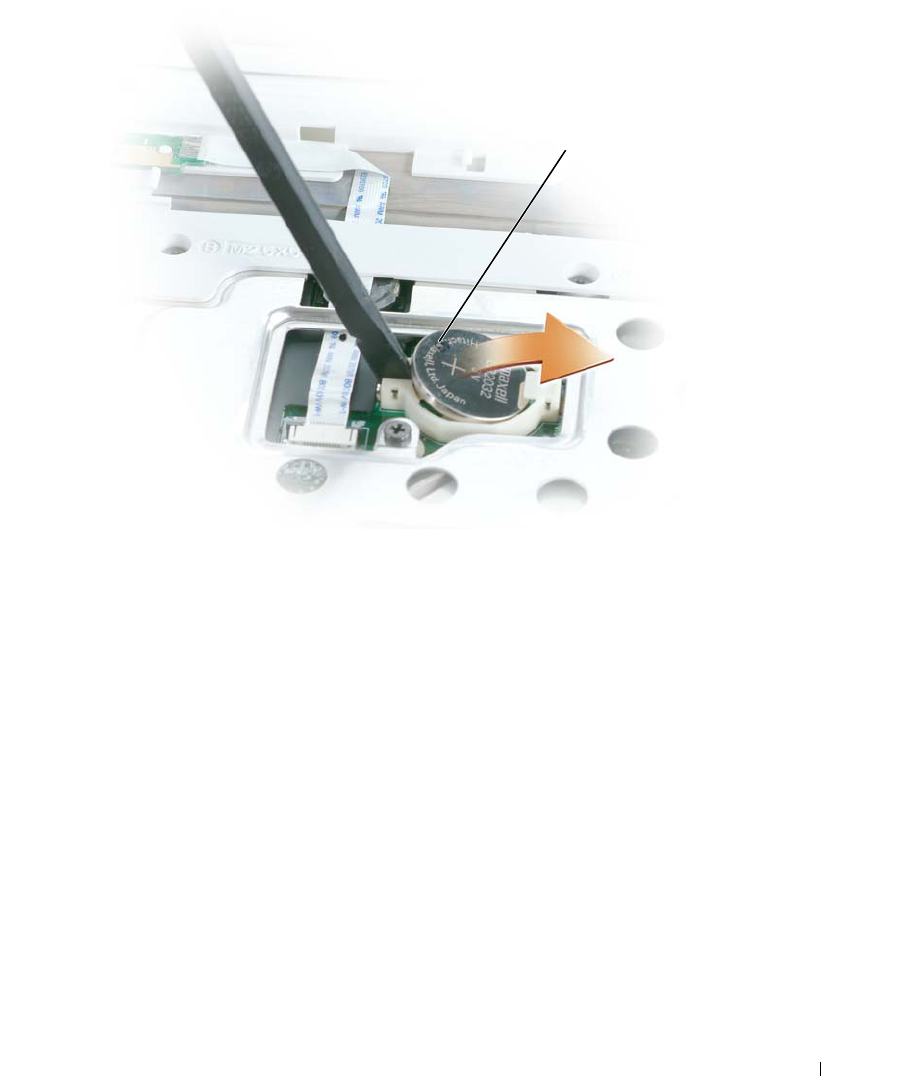
Adding and Replacing Parts 129
Replacing the Coin-Cell Battery
When you replace the battery, insert it into the circular socket with the positive side up, and then
push it into place.
1coin-cell battery
1
book.book Page 129 Wednesday, September 28, 2005 2:16 PM

130 Adding and Replacing Parts
www.dell.com | support.dell.com
book.book Page 130 Wednesday, September 28, 2005 2:16 PM

Appendix 131
13
Appendix
Specifications
Processor
Processor type Intel® Pentium® M or Intel Celeron® M
L1 cache 32-KB I-cache
32-KB D-cache
L2 cache 2 MB
External bus frequency (front side
bus)
400 MHz and 533 MHz
System Information
System chip set Mobile Intel 915 GM Express
Data bus width 64 bits
DRAM bus width dual-channel (2) 64-bit buses
Processor address bus width 32 bits
Flash EPROM 1 MB
Graphics bus internal
PCI bus 32 bits
ExpressCard
ExpressCard controller Intel ICH6
ExpressCard connector one ExpressCard slot (54 mm)
Cards supported ExpressCard/34 (34 mm) and
ExpressCard/54 (54 mm)
1.5 V and 3.3 V
ExpressCard connector size 28 pins
book.book Page 131 Wednesday, September 28, 2005 2:16 PM

132 Appendix
www.dell.com | support.dell.com
5-in-1 Media Memory Card Reader
5-in-1 media memory card controller Ricoh R5C832
5-in-1 media memory card connector 5-in-1 combo card connector
Cards supported MS
MS Pro
SSD/SDIO
MMC
xD
CD Type I/II & IBM® Microdrive through
ExpressCard adapter
5-in-1 media memory card connector
size
36.8 x 29.3 x 4.75 mm
Memory
Memory module connector two SODIMM connectors
Memory module capacities 256 MB, 512 MB, and 1 GB
Memory type 1.8-V SODIMM DDR-2
Minimum memory 256 MB
Maximum memory 2 GB
Ports and Connectors
Audio microphone connector, stereo
headphone/speaker connector
IEEE 1394a 4-pin serial connector
Mini PCI one Type IIIA Mini PCI card slot
Modem RJ-11 port
Network adapter RJ-45 port
S-video TV-out 7-pin mini-DIN connector (optional S-video
to composite video adapter cable)
USB four 4-pin USB 2.0-compliant connectors
Video 15-hole connector
book.book Page 132 Wednesday, September 28, 2005 2:16 PM

Appendix 133
Communications
Modem:
Ty p e
v.92 56K MDC
Controller
softmodem
Interface
internal HDA bus
Network adapter 10/100 Ethernet LAN on system board
Wireless internal Mini PCI Wi-Fi and Bluetooth®
wireless technology support
Video
Video type: integrated on system board
Video controller
Intel® Graphics Media
Accelerator (GMA) 900
Video memory
Up to 64 MB of shared memory
LCD interface
LVDS
TV support
NTSC/PAL
Audio
Audio type High Definition Audio (HDA) bus
Audio controller Sigmatel STAC9200
Stereo conversion 24-bit (analog-to-digital and digital-to-
analog)
Interfaces:
Internal
HDA bus
External
microphone-in connector, stereo
headphones/speakers connector
Speaker two 4-ohm speakers
Internal speaker amplifier 1-W channel into 4 ohms
Volume controls keyboard shortcuts, program menus, media
control buttons
book.book Page 133 Wednesday, September 28, 2005 2:16 PM

134 Appendix
www.dell.com | support.dell.com
Display
Type (active-matrix TFT) 14.1-inch WXGA
Dimensions:
Height
206 mm (8.11 inches)
Width
320 mm (12.59 inches)
Diagonal
357.74 mm (14.1 inches)
Maximum resolutions:
WXGA
1280 x 800 at 16.7 million colors
Refresh rate 60 Hz
Operating angle 0° (closed) to 180°
Viewing angles:
Horizontal
±40° (WXGA) typical
Vertical
+15°/–30° (WXGA)
Pixel pitch:
WXGA
0.237 mm
Controls brightness can be controlled through
keyboard shortcuts
Keyboard
Number of keys 87 (U.S. and Canada); 88 (Europe);
91 (Japan)
Layout QWERTY/AZERTY/Kanji
Touch Pad
X/Y position resolution
(graphics table mode) 240 cpi
Size:
Width
73.0-mm (2.9-inch) sensor-active area
Height
42.9-mm (1.7-inch) rectangle
book.book Page 134 Wednesday, September 28, 2005 2:16 PM

Appendix 135
Battery
Type 9-cell "smart" lithium ion
6-cell "smart" lithium ion
Dimensions:
Depth
60.1 mm (2.37 inches) (9 cell)
49 mm (1.93 inches) (6 cell)
Height
24 mm (0.94 inch)
Width
206.8 mm (8.14 inches)
Weight 0.48 kg (1.06 lb) (9 cell)
0.32 kg (0.7 lb) (6 cell)
Voltage 11.1 VDC
Charge time (approximate):
Computer off
2 hours
Operating time Battery operating time varies depending on
operating conditions and can be significantly
reduced under certain power-intensive
conditions. See "Power Problems" on
page 91.
See "Using a Battery" on page 45 for more
information on battery life.
Life span (approximate) 500 discharge/charge cycles
Temperature range:
Operating
0° to 35°C (32° to 95°F)
Storage
–40° to 60°C (–40° to 140°F)
Coin-cell battery CR-2032
AC Adapter
Input voltage 90–264 VAC
Input current (maximum) 1.5 A
Input frequency 47–63 Hz
Output current 4.34 A (maximum at 4-second pulse);
3.34 A (continuous)
Output power 65 W
Rated output voltage 19.5 +/–1.0 VDC
book.book Page 135 Wednesday, September 28, 2005 2:16 PM

136 Appendix
www.dell.com | support.dell.com
Dimensions:
Height
28.2 mm (1.11 inches)
Width
57.9 mm (2.28 inches)
Depth
137.2 mm (5.4 inches)
Weight (with cables) 0.4 kg (0.9 lb)
Temperature range:
Operating
0° to 35°C (32° to 95°F)
Storage
–40° to 65°C (–40° to 149°F)
Physical
Height 38.6 mm (1.52 inches)
Width 330 mm (12.99 inches)
Depth 243 mm (9.56 inches)
Weight (with 6-cell battery,
CDRW/DVD combo, and 40G hard
drive):
Configurable to less than
2.5 kg (5.5 lb)
Environmental
Temperature range:
Operating
0° to 35°C (32° to 95°F)
Storage
–40° to 65°C (–40° to 149°F)
Relative humidity (maximum):
Operating
10% to 90% (noncondensing)
Storage
5% to 95% (noncondensing)
Maximum vibration (using a
random-vibration spectrum that
simulates user environment):
Operating
0.66 GRMS
Storage
1.3 GRMS
Maximum shock (measured with
hard drive in head-parked position
and a 2-ms half-sine pulse):
Operating
122 G
AC Adapter
(continued)
book.book Page 136 Wednesday, September 28, 2005 2:16 PM

Appendix 137
Using the System Setup Program
Overview
NOTE: Your operating system may automatically configure most of the options available in the system
setup program, thus overriding options that you set through the system setup program. (An exception is
the External Hot Key option, which you can disable or enable only through the system setup program.) For
more information on configuring features for your operating system, see the Windows Help and Support
Center. To access the Help and Support Center, see page 13.
The system setup screens display the current setup information and settings for your computer,
such as:
• System configuration
• Basic device-configuration settings
• System security and hard-drive password settings
• Power management settings
• Boot (start-up) configuration and display settings
• Docking-device settings
• Wireless control settings
NOTICE: Unless you are an expert computer user or are directed to do so by Dell technical support, do
not change the system setup program settings. Certain changes might make your computer work
incorrectly.
Viewing the System Setup Screen
1
Turn on (or restart) your computer.
2
When the DELL™ logo appears, press <F2> immediately. If you wait too long and the
Windows logo appears, continue to wait until you see the Windows desktop. Then shut down
your computer and try again.
Storage
163 G
Altitude (maximum):
Operating
–15.2 to 3048 m (–50 to 10,000 ft)
Storage
–15.2 to 10,668 m (–50 to 35,000 ft)
Environmental
(continued)
book.book Page 137 Wednesday, September 28, 2005 2:16 PM

138 Appendix
www.dell.com | support.dell.com
System Setup Screen
The system setup screen consists of three windows of information. The window on the left contains
an expandable hierarchy of control categories. If you select (highlight) a category (such as
System
,
Onboard Devices
, or
Video
) and press <Enter>, you can show or hide the related subcategories.
The window on the right contains information about the category or subcategory selected in the
window on the left.
The window at the bottom tells you how to control the system setup program with key functions.
Use these keys to select a category, modify its settings, or exit the system setup program.
Commonly Used Options
Certain options require that you reboot the computer for new settings to take effect.
Changing the Boot Sequence
The
boot sequence,
or
boot order,
tells the computer where to look to find the software needed to
start the operating system. You can control the boot sequence and enable/disable devices using the
Boot Order
page of the system setup program.
NOTE: To change the boot sequence on a one-time-only basis, see "Performing a One-Time Boot" on
page 139.
The
Boot Order
page displays a general list of the bootable devices that may be installed in your
computer, including but not limited to the following:
•Diskette Drive
• Internal HDD
•USB Storage Device
•CD/DVD/CD-RW drive
•Modular bay HDD
NOTE: Only devices that are preceded by a number are bootable.
During the boot routine, the computer starts at the top of the list and scans each enabled device
for the operating system start-up files. When the computer finds the files, it stops searching and
starts the operating system.
To control the boot devices, select (highlight) a device by pressing the down-arrow or up-arrow key,
and then enable or disable the device or change its order in the list.
• To enable or disable a device, highlight the item and press the space bar. Enabled items are
preceded by a number; disabled items are not preceded by a number.
• To reorder a device in the list, highlight the device and press either <u> to move the device
up the list or <d> to move a device down the list.
Boot sequence changes take effect as soon as you save the changes and exit the system setup
program.
book.book Page 138 Wednesday, September 28, 2005 2:16 PM

Appendix 139
Performing a One-Time Boot
You can set a one-time-only boot sequence without entering the system setup program. (You can
also use this procedure to boot the Dell Diagnostics on the diagnostics utility partition on your
hard drive.)
1
Shut down the computer through the
Start
menu.
2
Connect the computer to an electrical outlet.
3
Turn on the computer. When the DELL logo appears, press <F2> immediately. If you wait
too long and the Windows logo appears, continue to wait until you see the Windows desktop.
Then shut down your computer and try again.
4
When the boot device list appears, highlight the device from which you want to boot and
press <Enter>.
The computer boots to the selected device.
The next time you reboot the computer, the previous boot order is restored.
Computer Tracking Software
Computer tracking software may enable you to locate your computer if it is lost or stolen. The
software is either preinstalled on your computer, or you can purchase it from www.dell.com. To
use tracking software, activate the setting, if necessary, in the system setup program (BIOS). To
access the system setup program, start your computer and press <F2> immediately when the
blue DELL™ logo appears.
Traveling With Your Computer
Identifying Your Computer
• Attach a name tag or business card to the computer.
• Write down your Service Tag and store it in a safe place away from the computer or carrying
case. Use the Service Tag if you need to report a loss or theft to law enforcement officials and
to Dell.
• Create a file on the Microsoft
®
Windows
®
desktop called
if_found
. Place information such
as your name, address, and phone number in this file.
• Contact your credit card company and ask if it offers coded identification tags.
Packing the Computer
• Remove any external devices attached to the computer and store them in a safe place.
• To make the computer as light as possible, replace any devices installed in the module bay
with the Dell TravelLite™ module.
• Fully charge the main battery and any spare batteries that you plan to carry with you.
book.book Page 139 Wednesday, September 28, 2005 2:16 PM

140 Appendix
www.dell.com | support.dell.com
• Shut down the computer.
• Disconnect the AC adapter.
NOTICE: When the display is closed, extraneous items on the keyboard or palm rest could damage the
display.
• Remove any extraneous items, such as paper clips, pens, and paper, from the keyboard and
palm rest and close the display.
• Use the optional Dell™ carrying case to pack the computer and its accessories together safely.
• Avoid packing the computer with items such as shaving cream, colognes, perfumes, or food.
NOTICE: If the computer has been exposed to extreme temperatures, allow it to acclimate to room
temperature for 1 hour before turning it on.
• Protect the computer, the batteries, and the hard drive from hazards such as extreme
temperatures and overexposure to sunlight, dirt, dust, or liquids.
• Pack the computer so that it does not slide around in the trunk of your car or in an overhead
storage compartment.
Travel Tips
NOTICE: Do not move the computer while using the optical drive to prevent loss of data.
NOTICE: Do not check the computer as baggage.
• Consider disabling wireless activity on your computer to maximize battery operating time. To
disable wireless activity, press<Fn><F2>.
• Consider changing your power management options to maximize battery operating time. See
"Power Management" on page 39.
• If you are the system setup program internationally, carry proof of ownership—or of your right
to use the computer if it is company-owned—to speed your passage through customs.
Investigate the customs regulations of the countries you plan to visit, and consider acquiring
an international carnet (also known as a
merchandise passport
) from your government.
• Find out what type of electrical outlets are used in the countries you will visit, and have
appropriate power adapters.
• Check with your credit card company for information about the kinds of emergency travel
assistance it offers to users of portable computers.
Traveling by Air
NOTICE: Do not walk the computer through a metal detector. Send the computer through an X-ray
machine or have it hand-inspected.
• Ensure that you have a charged battery available in case you are asked to turn on the
computer.
book.book Page 140 Wednesday, September 28, 2005 2:16 PM

Appendix 141
• Prior to entering the airplane, verify that using a computer is permitted. Some airlines forbid
the use of electronic devices during flight. All airlines forbid the use of electronic devices
during takeoff and landing.
If Your Computer Is Lost or Stolen
• Call a law enforcement agency to report the lost or stolen computer. Include the Service Tag
in your description of the computer. Ask that a case number be assigned and write down the
number, along with the name, address, and phone number of the law enforcement agency. If
possible, obtain the name of the investigating officer.
NOTE: If you know where the computer was lost or stolen, call a law enforcement agency in that area. If
you do not know, call a law enforcement agency where you live.
• If the computer belongs to a company, notify the security office of the company.
• Contact Dell customer service to report the missing computer. Provide the computer Service
Tag, the case number, and the name, address, and phone number of the law enforcement
agency to which you reported the missing computer. If possible, give the name of the
investigating officer.
The Dell customer service representative will log your report under the computer Service Tag and
record the computer as missing or stolen. If someone calls Dell for technical assistance and gives
your Service Tag, the computer is identified automatically as missing or stolen. The representative
will attempt to get the phone number and address of the caller. Dell will then contact the law
enforcement agency to which you reported of the missing computer.
Cleaning Your Computer
CAUTION: Before you begin any of the procedures in this section, follow the safety instructions
located in the
Product Information Guide
.
Computer, Keyboard, and Display
CAUTION: Before you clean your computer, disconnect the computer from the electrical outlet and
remove any installed batteries. Clean your computer with a soft cloth dampened with water. Do not use
liquid or aerosol cleaners, which may contain flammable substances.
• Use a can of compressed air to remove dust from between the keys on the keyboard and to
remove any dirt or lint from the display.
NOTICE: To avoid damaging the computer or display, do not spray cleaning solution directly onto the
display. Only use products specifically designed for cleaning displays, and follow the instructions that are
included with the product.
• Moisten a soft, lint-free cloth with either water or a display cleaner. Do not use alcohol or an
ammonia-based cleaner. Wipe the display gently working from the center to the edges until it
is clean and any fingerprints are removed. Do not use excessive pressure.
book.book Page 141 Wednesday, September 28, 2005 2:16 PM

142 Appendix
www.dell.com | support.dell.com
• Moisten a soft, lint-free cloth with water and wipe the computer and keyboard. Do not allow
water from the cloth to seep between the touch pad and the surrounding palm rest.
Touch Pad
1
Shut down and turn off your computer. See "Turning Off Your Computer" on page 105.
2
Disconnect any attached devices from the computer and from their electrical outlets.
3
Remove any installed batteries. See "Battery" on page 108.
4
Moisten a soft, lint-free cloth with water, and wipe it gently across the surface of the touch
pad. Do not allow water from the cloth to seep between the touch pad and the surrounding
palm rest.
Floppy Drive
NOTICE: Do not attempt to clean drive heads with a swab. You might accidentally misalign the heads
which prevents the drive from operating.
Clean your floppy drive using a commercially available cleaning kit. These kits contain
pretreated floppies to remove contaminants that accumulate during normal operation.
CDs and DVDs
NOTICE: Always use compressed air to clean the lens in the CD/DVD drive, and follow the instructions
that come with the compressed-air product. Never touch the lens in the drive.
If you notice problems, such as skipping, with the playback quality of your CDs or DVDs, try
cleaning the discs.
1
Hold the disc by its outer edge. You can also touch the inside edge of the center hole.
NOTICE: To avoid damaging the surface, do not wipe in a circular motion around the disc.
2
With a soft, lint-free cloth, gently wipe the bottom of the disc (the unlabeled side) in a
straight line from the center to the outer edge of the disc.
For stubborn dirt, try using water or a diluted solution of water and mild soap. You can also
purchase commercial products that clean discs and provide some protection from dust,
fingerprints, and scratches. Cleaning products for CDs are also safe to use on DVDs.
FCC Notices (U.S. Only)
Most Dell computers are classified by the Federal Communications Commission (FCC) as Class B
digital devices. To determine which classification applies to your computer, examine all FCC
registration labels located on the bottom, side, or back panel of your computer, on card-mounting
brackets, and on the cards themselves. If any one of the labels carries a Class A rating, your entire
computer is considered to be a Class A digital device. If
all
labels carry an FCC Class B rating as
distinguished by either an FCC ID number or the FCC logo, ( ), your computer is considered to
be a Class B digital device.
book.book Page 142 Wednesday, September 28, 2005 2:16 PM

Appendix 143
Once you have determined your computer’s FCC classification, read the appropriate FCC notice.
Note that FCC regulations provide that changes or modifications not expressly approved by Dell
could void your authority to operate this equipment.
This device complies with Part 15 of the FCC Rules. Operation is subject to the following two
conditions:
• This device may not cause harmful interference.
• This device must accept any interference received, including interference that may cause
undesired operation.
Class A
This equipment has been tested and found to comply with the limits for a Class A digital device
pursuant to Part 15 of the FCC Rules. These limits are designed to provide reasonable protection
against harmful interference when the equipment is operated in a commercial environment. This
equipment generates, uses, and can radiate radio frequency energy and, if not installed and used in
accordance with the manufacturer’s instruction manual, may cause harmful interference with radio
communications. Operation of this equipment in a residential area is likely to cause harmful
interference, in which case you will be required to correct the interference at your own expense.
Class B
This equipment has been tested and found to comply with the limits for a Class B digital device
pursuant to Part 15 of the FCC Rules. These limits are designed to provide reasonable protection
against harmful interference in a residential installation. This equipment generates, uses, and can
radiate radio frequency energy and, if not installed and used in accordance with the manufacturer’s
instruction manual, may cause interference with radio communications. However, there is no
guarantee that interference will not occur in a particular installation. If this equipment does cause
harmful interference to radio or television reception, which can be determined by turning the
equipment off and on, you are encouraged to try to correct the interference by one or more of the
following measures:
• Reorient or relocate the receiving antenna.
• Increase the separation between the equipment and the receiver.
• Connect the equipment into an outlet on a circuit different from that to which the receiver is
connected.
• Consult the dealer or an experienced radio/television technician for help.
book.book Page 143 Wednesday, September 28, 2005 2:16 PM

144 Appendix
www.dell.com | support.dell.com
FCC Identification Information
The following information is provided on the device or devices covered in this document in
compliance with FCC regulations:
• Model number: PP19L
• Company name:
Dell Inc.
One Dell Way
Round Rock, Texas 78682 USA
512-338-4400
Macrovision Product Notice
This product incorporates copyright protection technology that is protected by U.S. patents and
other intellectual property rights. Use of this copyright protection technology must be authorized
by Macrovision, and is intended for home and other limited viewing uses only unless otherwise
authorized by Macrovision. Reverse engineering or disassembly is prohibited.
Dell Technical Support Policy (U.S. Only)
Technician-assisted technical support requires the cooperation and participation of the customer
in the troubleshooting process and provides for restoration of the operating system, software
programs, and hardware drivers to the original default configuration as shipped from Dell, as well as
the verification of appropriate functionality of the computer and all Dell-installed hardware. In
addition to this technician-assisted technical support, online technical support is available at
support.dell.com
. Additional technical support options may be available for purchase.
Dell provides limited technical support for the computer and any "Dell-installed" software and
peripherals
1
. Support for third-party software and peripherals is provided by the original
manufacturer, including those purchased and/or installed through Dell Software and Peripherals,
Readyware, and Custom Factory Integration
2
.
1 Repair services are provided pursuant to the terms and conditions of your limited warranty and any optional
support service contract purchased with the computer.
2 All Dell-standard components included in a Custom Factory Integration (CFI) project are covered by the stan-
dard Dell limited warranty for your computer. However, Dell also extends a parts replacement program to
cover all nonstandard, third-party hardware components integrated through CFI for the duration of the com-
puter’s service contract.
Definition of "Dell-Installed" Software and Peripherals
Dell-installed software includes the operating system and some of the software programs that are
installed on the computer during the manufacturing process (Microsoft
®
Office, Norton Antivirus,
and so on).
book.book Page 144 Wednesday, September 28, 2005 2:16 PM

Appendix 145
Dell-installed peripherals include any internal expansion cards, or Dell-branded module bay or
ExpressCard accessories. In addition, any Dell-branded monitors, keyboards, mice, speakers,
microphones for telephonic modems, docking stations/port replicators, networking products, and
all associated cabling are included.
Definition of "Third-Party" Software and Peripherals
Third-party software and peripherals include any peripheral, accessory, or software program sold by
Dell not under the Dell brand (printers, scanners, cameras, games, and so on). Support for all third-
party software and peripherals is provided by the original manufacturer of the product.
Contacting Dell
To contact Dell electronically, you can access the following websites:
• www.dell.com
•
support.dell.com
(technical support)
•
premiersupport.dell.com
(technical support for educational, government, healthcare, and
medium/large business customers, including Premier, Platinum, and Gold customers)
For specific web addresses for your country, find the appropriate country section in the table
below.
NOTE: Toll-free numbers are for use within the country for which they are listed.
NOTE: In certain countries, technical support specific to Dell XPS portable computers is available at a
separate telephone number listed for participating countries. If you do not see a telephone number listed that is
specific for XPS portable computers, you may contact Dell through the technical support number listed and
your call will be routed appropriately.
When you need to contact Dell, use the electronic addresses, telephone numbers, and codes
provided in the following table. If you need assistance in determining which codes to use,
contact a local or an international operator.
Country (City)
International Access Code
Country Code
City Code
Department Name or Service Area,
Website and E-Mail Address
Area Codes,
Local Numbers, and
Toll-Free Numbers
Anguilla General Support
toll-free: 800-335-0031
Antigua and Barbuda General Support
1-800-805-5924
book.book Page 145 Wednesday, September 28, 2005 2:16 PM

146 Appendix
www.dell.com | support.dell.com
Argentina (Buenos Aires)
International Access Code: 00
Country Code: 54
City Code: 11
Website: www.dell.com.ar
E-mail: us_latin_services@dell.com
E-mail for desktop and portable computers:
la-techsupport@dell.com
E-mail for servers and EMC
®
storage products:
la_enterprise@dell.com
Customer Care
toll-free: 0-800-444-0730
Tech Support
toll-free: 0-800-444-0733
Tech Support Services
toll-free: 0-800-444-0724
Sales
0-810-444-3355
Aruba General Support
toll-free: 800-1578
Australia (Sydney)
International Access Code: 0011
Country Code: 61
City Code: 2
E-mail (Australia): au_tech_support@dell.com
E-mail Customer Care (Australia and
New Zealand): apcustserv@dell.com
Home and Small Business
1-300-655-533
Government and Business
toll-free: 1-800-633-559
Preferred Accounts Division (PAD)
toll-free: 1-800-060-889
Customer Care (after sales) toll-free 1-333-55(option 3)
Technical Support (portables and desktops)
toll-free: 1-300-655-533
Technical Support (servers and workstations)
toll-free: 1-800-733-314
Corporate Sales
toll-free: 1-800-808-385
Transa c tion Sa l es
toll-free: 1-800-808-312
Fax
toll-free: 1-800-818-341
Country (City)
International Access Code
Country Code
City Code
Department Name or Service Area,
Website and E-Mail Address
Area Codes,
Local Numbers, and
Toll-Free Numbers
book.book Page 146 Wednesday, September 28, 2005 2:16 PM

Appendix 147
Austria (Vienna)
International Access Code: 900
Country Code: 43
City Code: 1
Website: support.euro.dell.com
E-mail: tech_support_central_europe@dell.com
Home/Small Business Sales
0820 240 530 00
Home/Small Business Fax
0820 240 530 49
Home/Small Business Customer Care
0820 240 530 14
Preferred Accounts/Corporate Customer Care
0820 240 530 16
Technical Support for XPS portable computers only
0820 240 530 81
Home/Small Business Technical Support for all
other Dell computers
0820 240 530 14
Preferred Accounts/Corporate Technical Support
0660 8779
Switchboard
0820 240 530 00
Bahamas General Support
toll-free: 1-866-278-6818
Barbados General Support
1-800-534-3066
Belgium (Brussels)
International Access Code: 00
Country Code: 32
City Code: 2
Website: support.euro.dell.com
E-mail for French-speaking Customers:
support.euro.dell.com/be/fr/emaildell/
Technical Support for XPS portable computers only
024819296
Technical Support for all other Dell computers
024819288
Technical Support Fax
024819295
Customer Care
027131565
Corporate Sales
024819100
Fax
024819299
Switchboard
024819100
Bermuda General Support
1-800-342-0671
Bolivia General Support
toll-free: 800-10-0238
Brazil
International Access Code: 00
Country Code: 55
City Code: 51
Website: www.dell.com/br
Customer Support, Technical Support
0800 90 3355
Technical Support Fax
51 481 5470
Customer Care Fax
51 481 5480
Sales
0800 90 3390
British Virgin Islands General Support
toll-free: 1-866-278-6820
Country (City)
International Access Code
Country Code
City Code
Department Name or Service Area,
Website and E-Mail Address
Area Codes,
Local Numbers, and
Toll-Free Numbers
book.book Page 147 Wednesday, September 28, 2005 2:16 PM

148 Appendix
www.dell.com | support.dell.com
Brunei
Country Code: 673
Customer Technical Support (Penang, Malaysia)
604 633 4966
Customer Care (Penang, Malaysia) 604 633 4888
Transaction Sales (Penang, Malaysia)
604 633 4955
Canada (North York, Ontario)
International Access Code: 011
Online Order Status: www.dell.ca/ostatus
AutoTech (automated technical support)
toll-free: 1-800-247-9362
Customer Care (Home Sales/Small Business)
toll-free: 1-800-847-4096
Customer Care (med./large business, government)
toll-free: 1-800-326-9463
Technical Support (Home Sales/Small Business)
toll-free: 1-800-847-4096
Technical Support (med./large bus., government)
toll-free: 1-800-387-5757
Technical Support (printers, projectors, televisions,
handhelds, digital jukebox, and wireless)
1-877-335-5767
Sales (Home Sales/Small Business)
toll-free: 1-800-387-5752
Sales (med./large bus., government)
toll-free: 1-800-387-5755
Spare Parts Sales & Extended Service Sales
18664403355
Cayman Islands General Support
1-800-805-7541
Chile (Santiago)
Country Code: 56
City Code: 2
Sales, Customer Support, and Technical Support
toll-free: 1230-020-4823
Country (City)
International Access Code
Country Code
City Code
Department Name or Service Area,
Website and E-Mail Address
Area Codes,
Local Numbers, and
Toll-Free Numbers
book.book Page 148 Wednesday, September 28, 2005 2:16 PM

Appendix 149
China (Xiamen)
Country Code: 86
City Code: 592
Technical Support website: support.dell.com.cn
Technical Support E-mail: cn_support@dell.com
Customer Care E-mail: customer_cn@dell.com
Technical Support Fax
592 818 1350
Technical Support (Dell™ Dimension™ and
Inspiron)
toll-free: 800 858 2969
Technical Support (OptiPlex™, Latitude™, and
Dell Precision™)
toll-free: 800 858 0950
Technical Support (servers and storage)
toll-free: 800 858 0960
Technical Support (projectors, PDAs, switches,
routers, and so on)
toll-free: 800 858 2920
Technical Support (printers)
toll-free: 800 858 2311
Customer Care
toll-free: 800 858 2060
Customer Care Fax
592 818 1308
Home and Small Business
toll-free: 800 858 2222
Preferred Accounts Division
toll-free: 800 858 2557
Large Corporate Accounts GCP
toll-free: 800 858 2055
Large Corporate Accounts Key Accounts
toll-free: 800 858 2628
Large Corporate Accounts North
toll-free: 800 858 2999
Large Corporate Accounts North Government and
Education
toll-free: 800 858 2955
Large Corporate Accounts East
toll-free: 800 858 2020
Large Corporate Accounts East Government and
Education
toll-free: 800 858 2669
Large Corporate Accounts Queue Team
toll-free: 800 858 2572
Large Corporate Accounts South
toll-free: 800 858 2355
Large Corporate Accounts West
toll-free: 800 858 2811
Large Corporate Accounts Spare Parts
toll-free: 800 858 2621
Colombia General Support
980-9-15-3978
Costa Rica General Support
0800-012-0435
Country (City)
International Access Code
Country Code
City Code
Department Name or Service Area,
Website and E-Mail Address
Area Codes,
Local Numbers, and
Toll-Free Numbers
book.book Page 149 Wednesday, September 28, 2005 2:16 PM

150 Appendix
www.dell.com | support.dell.com
Czech Republic (Prague)
International Access Code: 00
Country Code: 420
Website: support.euro.dell.com
E-mail: czech_dell@dell.com
Technical Support
22537 2727
Customer Care
22537 2707
Fax
22537 2714
Tech Fax
22537 2728
Switchboard
22537 2711
Denmark (Copenhagen)
International Access Code: 00
Country Code: 45
Website: support.euro.dell.com
E-mail: support.euro.dell.com/dk/da/emaildell/
Technical Support for XPS portable computers only
7010 0074
Technical Support for all other Dell computers
7023 0182
Customer Care (Relational)
7023 0184
Home/Small Business Customer Care
3287 5505
Switchboard (Relational)
3287 1200
Switchboard Fax (Relational)
3287 1201
Switchboard (Home/Small Business)
3287 5000
Switchboard Fax (Home/Small Business)
3287 5001
Dominica General Support
toll-free: 1-866-278-6821
Dominican Republic General Support
1-800-148-0530
Ecuador General Support
toll-free: 999-119
El Salvador General Support
01-899-753-0777
Finland (Helsinki)
International Access Code: 990
Country Code: 358
City Code: 9
Website: support.euro.dell.com
E-mail: support.euro.dell.com/fi/fi/emaildell/
Technical Support
09 253 313 60
Customer Care
09 253 313 38
Fax
09 253 313 99
Switchboard
09 253 313 00
Country (City)
International Access Code
Country Code
City Code
Department Name or Service Area,
Website and E-Mail Address
Area Codes,
Local Numbers, and
Toll-Free Numbers
book.book Page 150 Wednesday, September 28, 2005 2:16 PM

Appendix 151
France (Paris) (Montpellier)
International Access Code: 00
Country Code: 33
City Codes: (1) (4)
Website: support.euro.dell.com
E-mail: support.euro.dell.com/fr/fr/emaildell/
Home and Small Business
Technical Support for XPS portable computers only
0825 387 129
Technical Support for all other Dell computers
0825 387 270
Customer Care
0825 823 833
Switchboard
0825 004 700
Switchboard (calls from outside of France)
04 99 75 40 00
Sales
0825 004 700
Fax
0825 004 701
Fax (calls from outside of France)
04 99 75 40 01
Corporate
Technical Support
0825 004 719
Customer Care
0825 338 339
Switchboard
01 55 94 71 00
Sales
01 55 94 71 00
Fax
01 55 94 71 01
Germany (Langen)
International Access Code: 00
Country Code: 49
City Code: 6103
Website: support.euro.dell.com
E-mail: tech_support_central_europe@dell.com
Technical Support for XPS portable computers only
06103 766-7222
Technical Support for all other Dell computers
06103 766-7200
Home/Small Business Customer Care
0180-5-224400
Global Segment Customer Care
06103 766-9570
Preferred Accounts Customer Care
06103 766-9420
Large Accounts Customer Care
06103 766-9560
Public Accounts Customer Care
06103 766-9555
Switchboard
06103 766-7000
Country (City)
International Access Code
Country Code
City Code
Department Name or Service Area,
Website and E-Mail Address
Area Codes,
Local Numbers, and
Toll-Free Numbers
book.book Page 151 Wednesday, September 28, 2005 2:16 PM

152 Appendix
www.dell.com | support.dell.com
Greece
International Access Code: 00
Country Code: 30
Website: support.euro.dell.com
E-mail: support.euro.dell.com/gr/en/emaildell/
Technical Support
00800-44 14 95 18
Gold Service Technical Support
00800-44 14 00 83
Switchboard
2108129810
Gold Service Switchboard
2108129811
Sales
2108129800
Fax
2108129812
Grenada General Support
toll-free: 1-866-540-3355
Guatemala General Support
1-800-999-0136
Guyana General Support
toll-free: 1-877-270-4609
Hong Kong
International Access Code: 001
Country Code: 852
Website: support.ap.dell.com
Technical Support E-mail: apsupport@dell.com
Technical Support (Dimension and Inspiron)
2969 3188
Technical Support (OptiPlex, Latitude, and Dell
Precision)
2969 3191
Technical Support (PowerApp™, PowerEdge™,
PowerConnect™, and PowerVault™)
2969 3196
Customer Care
3416 0910
Large Corporate Accounts
3416 0907
Global Customer Programs
3416 0908
Medium Business Division
3416 0912
Home and Small Business Division
2969 3105
India E-mail: india_support_desktop@dell.com
india_support_notebook@dell.com
india_support_Server@dell.com
Technical Support
1600338045
and 1600448046
Sales (Large Corporate Accounts)
1600 33 8044
Sales (Home and Small Business)
1600 33 8046
Country (City)
International Access Code
Country Code
City Code
Department Name or Service Area,
Website and E-Mail Address
Area Codes,
Local Numbers, and
Toll-Free Numbers
book.book Page 152 Wednesday, September 28, 2005 2:16 PM

Appendix 153
Ireland (Cherrywood)
International Access Code: 16
Country Code: 353
City Code: 1
Website: support.euro.dell.com
E-mail: dell_direct_support@dell.com
Technical Support for XPS portable computers only
1850 200 722
Technical Support for all other Dell computers
1850 543 543
U.K. Technical Support (dial within U.K. only)
0870 908 0800
Home User Customer Care
01 204 4014
Small Business Customer Care
01 204 4014
U.K. Customer Care (dial within U.K. only)
0870 906 0010
Corporate Customer Care
1850 200 982
Corporate Customer Care (dial within U.K. only)
0870 907 4499
Ireland Sales
01 204 4444
U.K. Sales (dial within U.K. only)
0870 907 4000
Fax/Sales Fax
01 204 0103
Switchboard
01 204 4444
Italy (Milan)
International Access Code: 00
Country Code: 39
City Code: 02
Website: support.euro.dell.com
E-mail: support.euro.dell.com/it/it/emaildell/
Home and Small Business
Technical Support
02 577 826 90
Customer Care
02 696 821 14
Fax
02 696 821 13
Switchboard
02 696 821 12
Corporate
Technical Support
02 577 826 90
Customer Care
02 577 825 55
Fax
02 575 035 30
Switchboard
02 577 821
Jamaica General Support (dial from within Jamaica only)
1-800-682-3639
Country (City)
International Access Code
Country Code
City Code
Department Name or Service Area,
Website and E-Mail Address
Area Codes,
Local Numbers, and
Toll-Free Numbers
book.book Page 153 Wednesday, September 28, 2005 2:16 PM

154 Appendix
www.dell.com | support.dell.com
Japan (Kawasaki)
International Access Code: 001
Country Code: 81
City Code: 44
Website: support.jp.dell.com
Technical Support (servers)
toll-free: 0120-198-498
Technical Support outside of Japan (servers)
81-44-556-4162
Technical Support (Dimension and Inspiron)
toll-free: 0120-198-226
Technical Support outside of Japan (Dimension and
Inspiron)
81-44-520-1435
Technical Support (Dell Precision, OptiPlex, and
Latitude)
toll-free:0120-198-433
Technical Support outside of Japan (Dell Precision,
OptiPlex, and Latitude)
81-44-556-3894
Technical Support (PDAs, projectors, printers,
routers)
toll-free: 0120-981-690
Technical Support outside of Japan (PDAs,
projectors, printers, routers)
81-44-556-3468
Faxbox Service
044-556-3490
24-Hour Automated Order Service
044-556-3801
Customer Care
044-556-4240
Business Sales Division (up to 400 employees)
044-556-1465
Preferred Accounts Division Sales (over 400
employees)
044-556-3433
Large Corporate Accounts Sales (over 3500
employees)
044-556-3430
Public Sales (government agencies, educational
institutions, and medical institutions)
044-556-1469
Global Segment Japan
044-556-3469
Individual User
044-556-1760
Switchboard
044-556-4300
Korea (Seoul)
International Access Code: 001
Country Code: 82
City Code: 2
E-mail: krsupport@dell.com
Technical Support
toll-free: 080-200-3800
Technical Support (Dimension, PDA, Electronics
and Accessories)
toll-free: 080-200-3801
Sales
toll-free: 080-200-3600
Fax
2194-6202
Switchboard
2194-6000
Country (City)
International Access Code
Country Code
City Code
Department Name or Service Area,
Website and E-Mail Address
Area Codes,
Local Numbers, and
Toll-Free Numbers
book.book Page 154 Wednesday, September 28, 2005 2:16 PM

Appendix 155
Latin America Customer Technical Support (Austin, Texas,
U.S.A.)
512 728-4093
Customer Service (Austin, Texas, U.S.A.)
512 728-3619
Fax (Technical Support and Customer Service)
(Austin, Texas, U.S.A.)
512 728-3883
Sales (Austin, Texas, U.S.A.)
512 728-4397
SalesFax (Austin, Texas, U.S.A.)
512 728-4600
or 512 728-3772
Luxembourg
International Access Code: 00
Country Code: 352
Website: support.euro.dell.com
Technical Support
3420808075
Home/Small Business Sales
+32 (0)2 713 15 96
Corporate Sales
26 25 77 81
Customer Care
+32 (0)2 481 91 19
Fax
26 25 77 82
Macao
Country Code: 853
Technical Support
toll-free: 0800 105
Customer Service (Xiamen, China)
34 160 910
Transaction Sales (Xiamen, China)
29 693 115
Malaysia (Penang)
International Access Code: 00
Country Code: 60
City Code: 4
Website: support.ap.dell.com
Technical Support (Dell Precision, OptiPlex, and
Latitude)
toll-free: 1 800 880 193
Technical Support (Dimension, Inspiron, and
Electronics and Accessories)
toll-free: 1 800 881 306
Technical Support (PowerApp, PowerEdge,
PowerConnect, and PowerVault)
toll-free: 1800 881 386
Customer Care
toll-free:
1800 881 306
(option 6)
Transa c t ion S ales
toll-free: 1 800 888 202
Corporate Sales
toll-free: 1 800 888 213
Country (City)
International Access Code
Country Code
City Code
Department Name or Service Area,
Website and E-Mail Address
Area Codes,
Local Numbers, and
Toll-Free Numbers
book.book Page 155 Wednesday, September 28, 2005 2:16 PM

156 Appendix
www.dell.com | support.dell.com
Mexico
International Access Code: 00
Country Code: 52
Customer Technical Support
001-877-384-8979
or 001-877-269-3383
Sales
50-81-8800
or 01-800-888-3355
Customer Service
001-877-384-8979
or 001-877-269-3383
Main
50-81-8800
or 01-800-888-3355
Montserrat General Support
toll-free: 1-866-278-6822
Netherlands Antilles General Support
001-800-882-1519
Netherlands (Amsterdam)
International Access Code: 00
Country Code: 31
City Code: 20
Website: support.euro.dell.com
Technical Support for XPS portable computers only
0206744594
Technical Support for all other Dell computers
0206744500
Technical Support Fax
0206744766
Home/Small Business Customer Care
0206744200
Relational Customer Care
020 674 4325
Home/Small Business Sales
0206745500
Relational Sales
0206745000
Home/Small Business Sales Fax
0206744775
Relational Sales Fax
0206744750
Switchboard
0206745000
Switchboard Fax
0206744750
Country (City)
International Access Code
Country Code
City Code
Department Name or Service Area,
Website and E-Mail Address
Area Codes,
Local Numbers, and
Toll-Free Numbers
book.book Page 156 Wednesday, September 28, 2005 2:16 PM

Appendix 157
New Zealand
International Access Code: 00
Country Code: 64
E-mail (New Zealand): nz_tech_support@dell.com
E-mail Customer Care (Australia and
New Zealand): apcustserv@dell.com
Customer Care toll-free: 0800-289-335
(option 3)
Technical Support (for desktop and portable
computers)
toll-free:
0800 446 255
Technical Support (for servers and workstations)
toll-free: 0800 443 563
Home and Small Business
0800 446 255
Government and Business
0800 444 617
Sales
0800 441 567
Fax
0800 441 566
Nicaragua General Support
001-800-220-1006
Norway (Lysaker)
International Access Code: 00
Country Code: 47
Website: support.euro.dell.com
E-mail: support.euro.dell.com/no/no/emaildell/
Technical Support for XPS portable computers only
815 35 043
Technical Support for all other Dell products
671 16882
Relational Customer Care
671 17575
Home/Small Business Customer Care
23162298
Switchboard
671 16800
Fax Switchboard
671 16865
Panama General Support
001-800-507-0962
Peru General Support
0800-50-669
Poland (Warsaw)
International Access Code: 011
Country Code: 48
City Code: 22
Website: support.euro.dell.com
E-mail: pl_support_tech@dell.com
Customer Service Phone
57 95 700
Customer Care
57 95 999
Sales
57 95 999
Customer Service Fax
57 95 806
Reception Desk Fax
57 95 998
Switchboard
57 95 999
Country (City)
International Access Code
Country Code
City Code
Department Name or Service Area,
Website and E-Mail Address
Area Codes,
Local Numbers, and
Toll-Free Numbers
book.book Page 157 Wednesday, September 28, 2005 2:16 PM

158 Appendix
www.dell.com | support.dell.com
Portugal
International Access Code: 00
Country Code: 351
Website: support.euro.dell.com
E-mail: support.euro.dell.com/pt/en/emaildell/
Technical Support
707200149
Customer Care
800 300 413
Sales
800 300 410 or 800 300 411 or
800 300 412 or 21 422 07 10
Fax
214240112
Puerto Rico General Support
1-800-805-7545
St. Kitts and Nevis General Support
toll-free: 1-877-441-4731
St. Lucia General Support
1-800-882-1521
St. Vincent and the Grenadines General Support
toll-free: 1-877-270-4609
Singapore (Singapore)
International Access Code: 005
Country Code: 65
Website: support.ap.dell.com
Technical Support (Dimension, Inspiron, and
Electronics and Accessories)
toll-free: 1800 394 7430
Technical Support (OptiPlex, Latitude, and Dell
Precision)
toll-free: 1800 394 7488
Technical Support (PowerApp, PowerEdge,
PowerConnect, and PowerVault)
toll-free: 1800 394 7478
Customer Care
toll-free:
1 800 394 7430
(option 6)
Transa c tion Sa l es
toll-free: 18003947412
Corporate Sales
toll-free: 1 800 394 7419
Slovakia (Prague)
International Access Code: 00
Country Code: 421
Website: support.euro.dell.com
E-mail: czech_dell@dell.com
Technical Support
02 5441 5727
Customer Care
420 22537 2707
Fax
02 5441 8328
Tech Fax
02 5441 8328
Switchboard (Sales)
02 5441 7585
Country (City)
International Access Code
Country Code
City Code
Department Name or Service Area,
Website and E-Mail Address
Area Codes,
Local Numbers, and
Toll-Free Numbers
book.book Page 158 Wednesday, September 28, 2005 2:16 PM

Appendix 159
South Africa (Johannesburg)
International Access Code:
09/091
Country Code: 27
City Code: 11
Website: support.euro.dell.com
E-mail: dell_za_support@dell.com
Gold Queue
011 709 7713
Technical Support
011 709 7710
Customer Care
011 709 7707
Sales
011 709 7700
Fax
011 706 0495
Switchboard
011 709 7700
Southeast Asian and Pacific
Countries
Customer Technical Support, Customer Service,
and Sales (Penang, Malaysia)
604 633 4810
Spain (Madrid)
International Access Code: 00
Country Code: 34
City Code: 91
Website: support.euro.dell.com
E-mail: support.euro.dell.com/es/es/emaildell/
Home and Small Business
Technical Support
902 100 130
Customer Care
902 118 540
Sales
902 118 541
Switchboard
902 118 541
Fax
902 118 539
Corporate
Technical Support
902 100 130
Customer Care
902 115 236
Switchboard
917229200
Fax
917229583
Country (City)
International Access Code
Country Code
City Code
Department Name or Service Area,
Website and E-Mail Address
Area Codes,
Local Numbers, and
Toll-Free Numbers
book.book Page 159 Wednesday, September 28, 2005 2:16 PM

160 Appendix
www.dell.com | support.dell.com
Sweden (Upplands Vasby)
International Access Code: 00
Country Code: 46
City Code: 8
Website: support.euro.dell.com
E-mail: support.euro.dell.com/se/sv/emaildell/
Technical Support for XPS portable computers only
0771 340 340
Technical Support for all other Dell products
08 590 05 199
Relational Customer Care
08 590 05 642
Home/Small Business Customer Care
08 587 70 527
Employee Purchase Program (EPP) Support
201401444
Technical Support Fax
08 590 05 594
Sales
08 590 05 185
Switzerland (Geneva)
International Access Code: 00
Country Code: 41
City Code: 22
Website: support.euro.dell.com
E-mail: Tech_support_central_Europe@dell.com
E-mail for French-speaking HSB and Corporate
Customers: support.euro.dell.com/ch/fr/emaildell/
Technical Support for XPS portable computers only
0848 33 88 57
Technical Support (Home and Small Business) for
all other Dell products
0844 811 411
Technical Support (Corporate)
0844 822 844
Customer Care (Home and Small Business)
0848 802 202
Customer Care (Corporate)
0848 821 721
Fax
0227990190
Switchboard
0227990101
Tai wa n
International Access Code: 002
Country Code: 886
Website: support.ap.dell.com
E-mail: ap_support@dell.com
Technical Support (OptiPlex, Latitude, Inspiron,
Dimension, and Electronics and Accessories)
toll-free: 00801 86 1011
Technical Support (PowerApp, PowerEdge,
PowerConnect, and PowerVault)
toll-free: 00801 60 1256
Customer Care
toll-free:
00801 60 1250
(option 5)
Transa c tion Sa l es
toll-free: 00801 65 1228
Corporate Sales
toll-free: 00801 651 227
Country (City)
International Access Code
Country Code
City Code
Department Name or Service Area,
Website and E-Mail Address
Area Codes,
Local Numbers, and
Toll-Free Numbers
book.book Page 160 Wednesday, September 28, 2005 2:16 PM

Appendix 161
Thailand
International Access Code: 001
Country Code: 66
Website: support.ap.dell.com
Technical Support (OptiPlex, Latitude, and Dell
Precision)
toll-free: 1800 0060 07
Technical Support (PowerApp, PowerEdge,
PowerConnect, and PowerVault)
toll-free: 1800 0600 09
Customer Care
toll-free:
1800 006 007
(option 7)
Corporate Sales
toll-free: 1800 006 009
Transa c t ion S ales
toll-free: 1800 006 006
Trinidad/Tobago General Support
1-800-805-8035
Turks and Caicos Islands General Support
toll-free: 1-866-540-3355
U.K. (Bracknell)
International Access Code: 00
Country Code: 44
City Code: 1344
Website: support.euro.dell.com
Customer Care website:
support.euro.dell.com/uk/en/ECare/Form/Home.asp
E-mail: dell_direct_support@dell.com
Technical Support (Corporate/Preferred
Accounts/PAD [1000+ employees])
0870 908 0500
Technical Support for XPS portable computers only
0870 366 4180
Technical Support (direct and general) for all other
products
0870 908 0800
Global Accounts Customer Care
01344 373 186
Home and Small Business Customer Care
0870 906 0010
Corporate Customer Care
01344 373 185
Preferred Accounts (500–5000 employees)
Customer Care
0870 906 0010
Central Government Customer Care
01344 373 193
Local Government & Education Customer Care
01344 373 199
Health Customer Care
01344 373 194
Home and Small Business Sales
0870 907 4000
Corporate/Public Sector Sales
01344 860 456
Home and Small Business Fax
0870 907 4006
Uruguay General Support
toll-free: 000-413-598-2521
Country (City)
International Access Code
Country Code
City Code
Department Name or Service Area,
Website and E-Mail Address
Area Codes,
Local Numbers, and
Toll-Free Numbers
book.book Page 161 Wednesday, September 28, 2005 2:16 PM

162 Appendix
www.dell.com | support.dell.com
U.S.A. (Austin, Texas)
International Access Code: 011
Country Code: 1
Automated Order-Status Service
toll-free: 1-800-433-9014
AutoTech (portable and desktop computers)
toll-free: 1-800-247-9362
Technical Support (Dell TV, Printers, and
Projectors) for Relationship customers
toll-free 1-877-459-7298
Consumer (Home and Home Office) Technical
Support for all other Dell products
toll-free: 1-800-624-9896
Customer Service
toll-free: 1-800-624-9897
DellNet™ Service and Support
toll-free: 1-877-Dellnet
(1-877-335-5638)
Employee Purchase Program (EPP) Customers
toll-free: 1-800-695-8133
Financial Services website:
www.dellfinancialservices.com
Financial Services (lease/loans)
toll-free: 1-877-577-3355
Financial Services (Dell Preferred Accounts [DPA])
toll-free: 1-800-283-2210
Business
Customer Service and Technical Support
toll-free: 1-800-456-3355
Employee Purchase Program (EPP) Customers
toll-free: 1-800-695-8133
Printers and Projectors Technical Support
toll-free: 1-877-459-7298
Public (government, education, and healthcare)
Customer Service and Technical Support
toll-free: 1-800-456-3355
Employee Purchase Program (EPP) Customers
toll-free: 1-800-695-8133
Dell Sales
toll-free: 1-800-289-3355
or toll-free: 1-800-879-3355
Dell Outlet Store (Dell refurbished computers)
toll-free: 1-888-798-7561
Software and Peripherals Sales
toll-free: 1-800-671-3355
Spare Parts Sales
toll-free: 1-800-357-3355
Extended Service and Warranty Sales
toll-free: 1-800-247-4618
Fax
toll-free: 1-800-727-8320
Dell Services for the Deaf, Hard-of-Hearing, or
Speech-Impaired
toll-free: 1-877-DELLTTY
(1-877-335-5889)
U.S. Virgin Islands General Support
1-877-673-3355
Venezuela General Support
8001-3605
Country (City)
International Access Code
Country Code
City Code
Department Name or Service Area,
Website and E-Mail Address
Area Codes,
Local Numbers, and
Toll-Free Numbers
book.book Page 162 Wednesday, September 28, 2005 2:16 PM

Glossary 163
Glossary
Terms in this Glossary are provided for
informational purposes only and may or may not
describe features included with your particular
computer.
A
AC — alternating current — The form of electricity that
powers your computer when you plug the AC adapter
power cable in to an electrical outlet.
ACPI — advanced configuration and power interface —
A power management specification that enables
Microsoft® Windows® operating systems to put a
computer in standby or hibernate mode to conserve the
amount of electrical power allocated to each device
attached to the computer.
AGP — accelerated graphics port — A dedicated graphics
port that allows system memory to be used for video-
related tasks. AGP delivers a smooth, true-color video
image because of the faster interface between the video
circuitry and the computer memory.
antivirus software — A program designed to identify,
quarantine, and/or delete viruses from your computer.
APR — advanced port replicator — A docking device that
allows you to conveniently use an external monitor,
keyboard, mouse, and other devices with your portable
computer.
ASF — alert standards format — A standard to define a
mechanism for reporting hardware and software alerts to a
management console. ASF is designed to be platform- and
operating system-independent.
B
backup — A copy of a program or data file on a floppy,
CD, DVD, or hard drive. As a precaution, back up the
data files from your hard drive regularly.
battery — A rechargeable internal power source used to
operate portable computers when not connected to an AC
adapter and an electrical outlet.
battery life span — The length of time (years) during
which a portable computer battery is able to be depleted
and recharged.
battery operating time — The length of time (minutes or
hours) that a portable computer battery holds a charge
while powering the computer.
BIOS — basic input/output system — A program (or
utility) that serves as an interface between the computer
hardware and the operating system. Unless you
understand what effect these settings have on the
computer, do not change them. Also referred to as the
system setup program.
bit — The smallest unit of data interpreted by your
computer.
Bluetooth® wireless technology — A wireless technology
standard for short-range (9 m [29 feet]) networking
devices that allows for enabled devices to automatically
recognize each other.
boot sequence — Specifies the order of the devices from
which the computer attempts to boot.
bootable CD — A CD that you can use to start your
computer. In case your hard drive is damaged or your
computer has a virus, ensure that you always have a
bootable CD or floppy disk available. Your Drivers and
Utilities or ResourceCD is a bootable CD.
bootable disk — A disk that you can use to start your
computer. In case your hard drive is damaged or your
computer has a virus, ensure that you always have a
bootable CD or floppy disk available.
bps — bits per second — The standard unit for measuring
data transmission speed.
BTU — British thermal unit — A measurement of heat
output.
book.book Page 163 Wednesday, September 28, 2005 2:16 PM

164 Glossary
www.dell.com | support.dell.com
bus — A communication pathway between the
components in your computer.
bus speed — The speed, given in MHz, that indicates how
fast a bus can transfer information.
byte — The basic data unit used by your computer. A byte
is usually equal to 8 bits.
C
C — Celsius — A temperature measurement scale
where 0° is the freezing point and 100° is the boiling point
of water.
cache — A special high-speed storage mechanism which
can be either a reserved section of main memory or an
independent high-speed storage device. The cache
enhances the efficiency of many processor operations.
L1 cache — Primary cache stored inside the processor.
L2 cache — Secondary cache which can either be external
to the processor or incorporated into the processor
architecture.
carnet — An international customs document that
facilitates temporary imports into foreign countries. Also
known as a merchandise passport.
CD — compact disc — An optical form of storage media,
typically used for audio and software programs.
CD drive — A drive that uses optical technology to read
data from CDs.
CD player — The software used to play music CDs. The
CD player displays a window with buttons that you use to
play a CD.
CD-R — CD recordable — A recordable version of a CD.
Data can be recorded only once onto a CD-R. Once
recorded, the data cannot be erased or written over.
CD-RW — CD rewritable — A rewritable version of a
CD. Data can be written to a CD-RW disc, and then
erased and written over (rewritten).
CD-RW drive — A drive that can read CDs and write to
CD-RW (rewritable CDs) and CD-R (recordable CDs)
discs. You can write to CD-RW discs multiple times, but
you can write to CD-R discs only once.
CD-RW/DVD drive — A drive, sometimes referred to as a
combo drive, that can read CDs and DVDs and write to
CD-RW (rewritable CDs) and CD-R (recordable CDs)
discs. You can write to CD-RW discs multiple times, but
you can write to CD-R discs only once.
clock speed — The speed, given in MHz, that indicates
how fast computer components that are connected to the
system bus operate.
COA — Certificate of Authenticity — The Windows
alpha-numeric code located on a sticker on your
computer. Also referred to as the Product Key or
Product ID.
Control Panel — A Windows utility that allows you to
modify operating system and hardware settings, such as
display settings.
controller — A chip that controls the transfer of data
between the processor and memory or between the
processor and devices.
CRIMM — continuity rambus in-line memory module
— A special module that has no memory chips and is used
to fill unused RIMM slots.
cursor — The marker on a display or screen that shows
where the next keyboard, touch pad, or mouse action will
occur. It often is a blinking solid line, an underline
character, or a small arrow.
D
DDR SDRAM — double-data-rate SDRAM — A type of
SDRAM that doubles the data burst cycle, improving
system performance.
DDR2 SDRAM — double-data-rate 2 SDRAM — A type
of DDR SDRAM that uses a 4-bit prefetch and other
architectural changes to boost memory speed to over
400 MHz.
device — Hardware such as a disk drive, printer, or
keyboard that is installed in or connected to your
computer.
device driver — See driver.
DIMM — Dual Inline Memory Module.
book.book Page 164 Wednesday, September 28, 2005 2:16 PM

Glossary 165
DIN connector — A round, six-pin connector that
conforms to DIN (Deutsche Industrie-Norm) standards;
it is typically used to connect PS/2 keyboard or mouse
cable connectors.
disk striping — A technique for spreading data over
multiple disk drives. Disk striping can speed up operations
that retrieve data from disk storage. Computers that use
disk striping generally allow the user to select the data
unit size or stripe width.
DMA — direct memory access — A channel that allows
certain types of data transfer between RAM and a device
to bypass the processor.
docking device — See APR.
DMTF — Distributed Management Task Force — A
consortium of hardware and software companies who
develop management standards for distributed desktop,
network, enterprise, and Internet environments.
domain — A group of computers, programs, and devices
on a network that are administered as a unit with common
rules and procedures for use by a specific group of users. A
user logs on to the domain to gain access to the resources.
DRAM — dynamic random-access memory — Memory
that stores information in integrated circuits containing
capacitors.
driver — Software that allows the operating system to
control a device such as a printer. Many devices do not
work properly if the correct driver is not installed in the
computer.
DSL — Digital Subscriber Line — A technology that
provides a constant, high-speed Internet connection
through an analog telephone line.
dual display mode — A display setting that allows you to
use a second monitor as an extension of your display. Also
referred to as extended display mode.
DVD — digital versatile disc — A high-capacity disc
usually used to store movies. DVD drives read most CD
media as well.
DVD drive — A drive that uses optical technology to read
data from DVDs and CDs.
DVD player — The software used to watch DVD movies.
The DVD player displays a window with buttons that you
use to watch a movie.
DVD-R — DVD recordable — A recordable version of a
DVD. Data can be recorded only once onto a DVD-R.
Once recorded, the data cannot be erased or written over.
DVD+RW — DVD rewritable — A rewritable version of
a DVD. Data can be written to a DVD+RW disc, and
then erased and written over (rewritten). (DVD+RW
technology is different from DVD-RW technology.)
DVD+RW drive — A drive that can read DVDs and most
CD media and write to DVD+RW (rewritable DVDs)
discs.
DVI — digital video interface — A standard for digital
transmission between a computer and a digital video
display.
E
ECC — error checking and correction — A type of
memory that includes special circuitry for testing the
accuracy of data as it passes in and out of memory.
ECP — extended capabilities port — A parallel connector
design that provides improved bidirectional data
transmission. Similar to EPP, ECP uses direct memory
access to transfer data and often improves performance.
EIDE — enhanced integrated device electronics — An
improved version of the IDE interface for hard drives and
CD drives.
EMI — electromagnetic interference — Electrical
interference caused by electromagnetic radiation.
ENERGY STAR® — Environmental Protection Agency
requirements that decrease the overall consumption of
electricity.
EPP — enhanced parallel port — A parallel connector
design that provides bidirectional data transmission.
ESD — electrostatic discharge — A rapid discharge of
static electricity. ESD can damage integrated circuits
found in computer and communications equipment.
book.book Page 165 Wednesday, September 28, 2005 2:16 PM

166 Glossary
www.dell.com | support.dell.com
expansion card — A circuit board that installs in an
expansion slot on the system board in some computers,
expanding the capabilities of the computer. Examples
include video, modem, and sound cards.
expansion slot — A connector on the system board (in
some computers) where you insert an expansion card,
connecting it to the system bus.
ExpressCard — A removable I/O card adhering to the
PCMCIA standard. Modems and network adapters are
common types of ExpressCards. ExpressCards support
both the PCI Express and USB 2.0 standard.
Express Service Code — A numeric code located on a
sticker on your Dell™ computer. Use the Express Service
Code when contacting Dell for assistance. Express Service
Code service may not be available in some countries.
extended display mode — A display setting that allows
you to use a second monitor as an extension of your
display. Also referred to as dual display mode.
extended PC Card — A PC Card that extends beyond the
edge of the PC Card slot when installed.
F
Fahrenheit — A temperature measurement scale
where 32° is the freezing point and 212° is the boiling
point of water.
FCC — Federal Communications Commission — A U.S.
agency responsible for enforcing communications-related
regulations that state how much radiation computers and
other electronic equipment can emit.
floppy — An electromagnetic form of storage media. Also
known as a floppy diskette or a floppy disk.
floppy drive — A disk drive that can read and write to
floppy disks.
folder — A term used to describe space on a disk or drive
where files are organized and grouped. Files in a folder can
be viewed and ordered in various ways, such as
alphabetically, by date, and by size.
format — The process that prepares a drive or disk for file
storage. When a drive or disk is formatted, the existing
information on it is lost.
FSB — front side bus — The data path and physical
interface between the processor and RAM.
FTP — file transfer protocol — A standard Internet
protocol used to exchange files between computers
connected to the Internet.
G
G — gravity — A measurement of weight and force.
GB — gigabyte — A measurement of data storage that
equals 1024 MB (1,073,741,824 bytes). When used to
refer to hard drive storage, the term is often rounded to
1,000,000,000 bytes.
GHz — gigahertz — A measurement of frequency that
equals one thousand million Hz, or one thousand MHz.
The speeds for computer processors, buses, and interfaces
are often measured in GHz.
graphics mode — A video mode that can be defined as x
horizontal pixels by y vertical pixels by z colors. Graphics
modes can display an unlimited variety of shapes and
fonts.
GUI — graphical user interface — Software that interacts
with the user by means of menus, windows, and icons.
Most programs that operate on the Windows operating
systems are GUIs.
H
hard drive — A drive that reads and writes data on a hard
disk. The terms hard drive and hard disk are often used
interchangeably.
heat sink — A metal plate on some processors that helps
dissipate heat.
help file — A file that contains descriptive or
instructional information about a product. Some help
files are associated with a particular program, such as Help
in Microsoft Word. Other help files function as stand-
alone reference sources. Help files typically have a
filename extension of .hlp or .chm.
hibernate mode — A power management mode that saves
everything in memory to a reserved space on the hard
drive and then turns off the computer. When you restart
book.book Page 166 Wednesday, September 28, 2005 2:16 PM

Glossary 167
the computer, the memory information that was saved to
the hard drive is automatically restored.
HTML — hypertext markup language — A set of codes
inserted into an Internet web page intended for display on
an Internet browser.
HTTP — hypertext transfer protocol — A protocol for
exchanging files between computers connected to the
Internet.
Hz — hertz — A unit of frequency measurement that
equals 1 cycle per second. Computers and electronic
devices are often measured in kilohertz (kHz), megahertz
(MHz), gigahertz (GHz), or terahertz (THz).
I
IC — Industry Canada — The Canadian regulatory body
responsible for regulating emissions from electronic
equipment, much as the FCC does in the United States.
IC — integrated circuit — A semiconductor wafer, or
chip, on which thousands or millions of tiny electronic
components are fabricated for use in computer, audio, and
video equipment.
IDE — integrated device electronics — An interface for
mass storage devices in which the controller is integrated
into the hard drive or CD drive.
IEEE 1394 — Institute of Electrical and Electronics
Engineers, Inc. — A high-performance serial bus used to
connect IEEE 1394-compatible devices, such as digital
cameras and DVD players, to the computer.
infrared sensor — A port that allows you to transfer data
between the computer and infrared-compatible devices
without using a cable connection.
integrated — Usually refers to components that are
physically located on the computer’s system board. Also
referred to as built-in.
I/O — input/output — An operation or device that enters
and extracts data from your computer. Keyboards and
printers are I/O devices.
I/O address — An address in RAM that is associated with
a specific device (such as a serial connector, parallel
connector, or expansion slot) and allows the processor to
communicate with that device.
IrDA — Infrared Data Association — The organization
that creates international standards for infrared
communications.
IRQ — interrupt request — An electronic pathway
assigned to a specific device so that the device can
communicate with the processor. Each device connection
must be assigned an IRQ. Although two devices can share
the same IRQ assignment, you cannot operate both
devices simultaneously.
ISP — Internet service provider — A company that allows
you to access its host server to connect directly to the
Internet, send and receive e-mail, and access websites.
The ISP typically provides you with a software package,
user name, and access phone numbers for a fee.
K
Kb — kilobit — A unit of data that equals 1024 bits. A
measurement of the capacity of memory integrated
circuits.
KB — kilobyte — A unit of data that equals 1024 bytes
but is often referred to as 1000 bytes.
key combination — A command requiring you to press
multiple keys at the same time.
kHz — kilohertz — A measurement of frequency that
equals 1000 Hz.
L
LAN — local area network — A computer network
covering a small area. A LAN usually is confined to a
building or a few nearby buildings. A LAN can be
connected to another LAN over any distance through
telephone lines and radio waves to form a wide area
network (WAN).
LCD — liquid crystal display — The technology used by
portable computer and flat-panel displays.
book.book Page 167 Wednesday, September 28, 2005 2:16 PM

168 Glossary
www.dell.com | support.dell.com
LED — light-emitting diode — An electronic component
that emits light to indicate the status of the computer.
local bus — A data bus that provides a fast throughput for
devices to the processor.
LPT — line print terminal — The designation for a
parallel connection to a printer or other parallel device.
M
Mb — megabit — A measurement of memory chip
capacity that equals 1024 Kb.
Mbps — megabits per second — One million bits per
second. This measurement is typically used for
transmission speeds for networks and modems.
MB — megabyte — A measurement of data storage that
equals 1,048,576 bytes. 1 MB equals 1024 KB. When used
to refer to hard drive storage, the term is often rounded to
1,000,000 bytes.
MB/sec — megabytes per second — One million bytes
per second. This measurement is typically used for data
transfer ratings.
memory — A temporary data storage area inside your
computer. Because the data in memory is not permanent,
it is recommended that you frequently save your files
while you are working on them, and always save your files
before you shut down the computer. Your computer can
contain several different forms of memory, such as RAM,
ROM, and video memory. Frequently, the word memory is
used as a synonym for RAM.
memory address — A specific location where data is
temporarily stored in RAM.
memory mapping — The process by which the computer
assigns memory addresses to physical locations at start-up.
Devices and software can then identify information that
the processor can access.
memory module — A small circuit board containing
memory chips, which connects to the system board.
MHz — megahertz — A measure of frequency that equals
1 million cycles per second. The speeds for computer
processors, buses, and interfaces are often measured in
MHz.
Mini PCI — A standard for integrated peripherals with
an emphasis on communications such as such as modems
and NICs. Mini PCI is a small card that is functionally
equivalent to a standard PCI expansion card.
modem — A device that allows your computer to
communicate with other computers over analog
telephone lines. Three types of modems include: external,
PC Card or ExpressCard, and internal. You typically use
your modem to connect to the Internet and exchange
e-mail.
module bay — A bay that supports devices such as optical
drives, a second battery, or a Dell TravelLite™ module.
monitor — The high-resolution TV-like device that
displays computer output.
mouse — A pointing device that controls the movement
of the cursor on your screen. Typically you roll the mouse
over a hard, flat surface to move the pointer or cursor on
your screen.
ms — millisecond — A measure of time that equals one
thousandth of a second. Access times of storage devices
are often measured in ms.
N
network adapter — A chip that provides network
capabilities. A computer may include a network adapter
on its system board, or it may contain an PC Card with an
adapter on it. A network adapter is also referred to as a
NIC (network interface controller).
NIC — See network adapter.
notification area — The section of the Windows taskbar
that contains icons for providing quick access to programs
and computer functions, such as the clock, volume
control, and print status. Also referred to as system tray.
ns — nanosecond — A measure of time that equals one
billionth of a second.
NVRAM — nonvolatile random access memory — A type
of memory that stores data when the computer is turned
off or loses its external power source. NVRAM is used for
maintaining computer configuration information such
as date, time, and other system setup options that you
can set.
book.book Page 168 Wednesday, September 28, 2005 2:16 PM

Glossary 169
O
optical drive — A drive that uses optical technology to
read or write data from CDs, DVDs, or DVD+RWs.
Example of optical drives include CD drives, DVD drives,
CD-RW drives, and CD-RW/DVD combo drives.
P
parallel connector — An I/O port often used to connect a
parallel printer to your computer. Also referred to as an
LPT port.
partition — A physical storage area on a hard drive that is
assigned to one or more logical storage areas known as
logical drives. Each partition can contain multiple logical
drives.
PC Card — A removable I/O card adhering to the
PCMCIA standard. Modems and network adapters are
common types of PC Cards.
PCI — peripheral component interconnect — PCI is a
local bus that supports 32-and 64-bit data paths,
providing a high-speed data path between the processor
and devices such as video, drives, and networks.
PCI Express — A modification to the PCI interface that
boosts the data transfer rate between the processor and
the devices attached to it. PCI Express can transfer data at
speeds from 250 MB/sec to 4 GB/sec. If the PCI Express
chip set and the device are capable of different speeds,
they will operate at the slower speed.
PCMCIA — Personal Computer Memory Card
International Association — The organization that
establishes standards for PC Cards.
PIN — personal identification number — A sequence of
numerals and/or letters used to restrict unauthorized
access to computer networks and other secure systems.
PIO — programmed input/output — A method of
transferring data between two devices through the
processor as part of the data path.
pixel — A single point on a display screen. Pixels are
arranged in rows and columns to create an image. A video
resolution, such as 800 x 600, is expressed as the number
of pixels across by the number of pixels up and down.
Plug-and-Play — The ability of the computer to
automatically configure devices. Plug and Play provides
automatic installation, configuration, and compatibility
with existing hardware if the BIOS, operating system, and
all devices are Plug and Play compliant.
POST — power-on self-test — Diagnostics programs,
loaded automatically by the BIOS, that perform basic
tests on the major computer components, such as
memory, hard drives, and video. If no problems are
detected during POST, the computer continues the
start-up.
processor — A computer chip that interprets and executes
program instructions. Sometimes the processor is referred
to as the CPU (central processing unit).
program — Any software that processes data for you,
including spreadsheet, word processor, database, and
game packages. Programs require an operating system to
run.
PS/2 — personal system/2 — A type of connector for
attaching a PS/2-compatible keyboard, mouse, or keypad.
PXE — pre-boot execution environment — A WfM
(Wired for Management) standard that allows networked
computers that do not have an operating system to be
configured and started remotely.
R
RAID — redundant array of independent disks — A
method of providing data redundancy. Some common
implementations of RAID include RAID 0, RAID 1,
RAID 5, RAID 10, and RAID 50.
RAM — random-access memory — The primary
temporary storage area for program instructions and data.
Any information stored in RAM is lost when you shut
down your computer.
readme file — A text file included with a software package
or hardware product. Typically, readme files provide
installation information and describe new product
enhancements or corrections that have not yet been
documented.
book.book Page 169 Wednesday, September 28, 2005 2:16 PM

170 Glossary
www.dell.com | support.dell.com
read-only — Data and/or files you can view but cannot
edit or delete. A file can have read-only status if:
• It resides on a physically write-protected floppy disk,
CD, or DVD.
• It is located on a network in a directory and the
system administrator has assigned rights only to
specific individuals.
refresh rate — The frequency, measured in Hz, at which
your screen's horizontal lines are recharged (sometimes
also referred to as its vertical frequency). The higher the
refresh rate, the less video flicker can be seen by the
human eye.
resolution — The sharpness and clarity of an image
produced by a printer or displayed on a monitor. The
higher the resolution, the sharper the image.
RFI — radio frequency interference — Interference that
is generated at typical radio frequencies, in the range of
10 kHz to 100,000 MHz. Radio frequencies are at the
lower end of the electromagnetic frequency spectrum and
are more likely to have interference than the higher
frequency radiations, such as infrared and light.
ROM — read-only memory — Memory that stores data
and programs that cannot be deleted or written to by the
computer. ROM, unlike RAM, retains its contents after
you shut down your computer. Some programs essential to
the operation of your computer reside in ROM.
RPM — revolutions per minute — The number of
rotations that occur per minute. Hard drive speed is often
measured in rpm.
RTC — real time clock — Battery-powered clock on the
system board that keeps the date and time after you shut
down the computer.
RTCRST — real-time clock reset — A jumper on the
system board of some computers that can often be used
for troubleshooting problems.
S
ScanDisk — A Microsoft utility that checks files, folders,
and the hard disk’s surface for errors. ScanDisk often runs
when you restart the computer after it has stopped
responding.
SDRAM — synchronous dynamic random-access memory
— A type of DRAM that is synchronized with the optimal
clock speed of the processor.
serial connector — An I/O port often used to connect
devices such as a handheld digital device or digital camera
to your computer.
Service Tag — A bar code label on your computer that
identifies your computer when you access Dell Support at
support.dell.com or when you call Dell for customer
service or technical support.
setup program — A program that is used to install and
configure hardware and software. The setup.exe or
install.exe program comes with most Windows software
packages. Setup program differs from the system setup
program.
shortcut — An icon that provides quick access to
frequently used programs, files, folders, and drives. When
you place a shortcut on your Windows desktop and
double-click the icon, you can open its corresponding
folder or file without having to find it first. Shortcut icons
do not change the location of files. If you delete a
shortcut, the original file is not affected. Also, you can
rename a shortcut icon.
shutdown — The process of closing windows and exiting
programs, exiting the operating system, and turning off
your computer. You can lose data if you turn off your
computer before completing a shutdown.
smart card — A card that is embedded with a processor
and a memory chip. Smart cards can be used to
authenticate a user on computers equipped for smart
cards.
software — Anything that can be stored electronically,
such as computer files or programs.
S/PDIF — Sony/Philips Digital Interface — An audio
transfer file format that allows the transfer of audio from
one file to another without converting it to and from an
analog format, which could degrade the quality of the file.
standby mode — A power management mode that shuts
down all unnecessary computer operations to save energy.
book.book Page 170 Wednesday, September 28, 2005 2:16 PM

Glossary 171
Strike Zone™ — Reinforced area of the platform base
that protects the hard drive by acting as a dampening
device when a computer experiences resonating shock or
is dropped (whether the computer is on or off).
surge protectors — Prevent voltage spikes, such as those
that may occur during an electrical storm, from entering
the computer through the electrical outlet. Surge
protectors do not protect against lightning strikes or
against brownouts, which occur when the voltage drops
more than 20 percent below the normal AC-line voltage
level.
Network connections cannot be protected by surge
protectors. Always disconnect the network cable from the
network connector during electrical storms.
SVGA — super-video graphics array — A video standard
for video cards and controllers. Typical SVGA resolutions
are 800 x 600 and 1024 x 768.
The number of colors and resolution that a program
displays depends on the capabilities of the monitor, the
video controller and its drivers, and the amount of video
memory installed in the computer.
S-video TV-out — A connector used to attach a TV or
digital audio device to the computer.
SXGA — super-extended graphics array — A video
standard for video cards and controllers that supports
resolutions up to 1280 x 1024.
SXGA+ — super-extended graphics array plus — A video
standard for video cards and controllers that supports
resolutions up to 1400 x 1050.
system board — The main circuit board in your computer.
Also known as the motherboard.
system setup — A utility that serves as an interface
between the computer hardware and the operating
system. System setup allows you to configure user-
selectable options in the BIOS, such as date and time or
system password. Unless you understand what effect the
settings have on the computer, do not change the settings
for this program.
system tray — See notification area.
T
TAPI — telephony application programming interface —
Enables Windows programs to operate with a wide variety
of telephony devices, including voice, data, fax, and video.
text editor — A program used to create and edit files that
contain only text; for example, Windows Notepad uses a
text editor. Text editors do not usually provide word wrap
or formatting functionality (the option to underline,
change fonts, and so on).
travel module — A plastic device designed to fit inside
the module bay of a portable computer to reduce the
weight of the computer.
U
UMA — unified memory allocation — System memory
dynamically allocated to video.
UPS — uninterruptible power supply — A backup power
source used when the electrical power fails or drops to an
unacceptable voltage level. A UPS keeps a computer
running for a limited amount of time when there is no
electrical power. UPS systems typically provide surge
suppression and may also provide voltage regulation.
Small UPS systems provide battery power for a few
minutes to enable you to shut down your computer.
USB — universal serial bus — A hardware interface for a
low-speed device such as a USB-compatible keyboard,
mouse, joystick, scanner, set of speakers, printer,
broadband devices (DSL and cable modems), imaging
devices, or storage devices. Devices are plugged directly in
to a 4-pin socket on your computer or in to a multi-port
hub that plugs in to your computer. USB devices can be
connected and disconnected while the computer is turned
on, and they can also be daisy-chained together.
UTP — unshielded twisted pair — Describes a type of
cable used in most telephone networks and some
computer networks. Pairs of unshielded wires are twisted
to protect against electromagnetic interference, rather
than relying on a metal sheath around each pair of wires to
protect against interference.
book.book Page 171 Wednesday, September 28, 2005 2:16 PM

172 Glossary
www.dell.com | support.dell.com
UXGA — ultra extended graphics array — A video
standard for video cards and controllers that supports
resolutions up to 1600 x 1200.
V
video controller — The circuitry on a video card or on the
system board (in computers with an integrated video
controller) that provides the video capabilities—in
combination with the monitor—for your computer.
video memory — Memory that consists of memory chips
dedicated to video functions. Video memory is usually
faster than system memory. The amount of video memory
installed primarily influences the number of colors that a
program can display.
video mode — A mode that describes how text and
graphics are displayed on a monitor. Graphics-based
software, such as Windows operating systems, displays in
video modes that can be defined as x horizontal pixels by y
vertical pixels by z colors. Character-based software, such
as text editors, displays in video modes that can be
defined as x columns by y rows of characters.
video resolution — See resolution.
virus — A program that is designed to inconvenience you
or to destroy data stored on your computer. A virus
program moves from one computer to another through an
infected disk, software downloaded from the Internet, or
e-mail attachments. When an infected program starts, its
embedded virus also starts.
A common type of virus is a boot virus, which is stored in
the boot sectors of a floppy disk. If the floppy disk is left in
the drive when the computer is shut down and then
turned on, the computer is infected when it reads the
boot sectors of the floppy disk expecting to find the
operating system. If the computer is infected, the boot
virus may replicate itself onto all the floppy disks that are
read or written in that computer until the virus is
eradicated.
V — volt — The measurement of electric potential or
electromotive force. One V appears across a resistance of
1 ohm when a current of 1 ampere flows through that
resistance.
W
W — watt — The measurement of electrical power. One
W is 1 ampere of current flowing at 1 volt.
WHr — watt-hour — A unit of measure commonly used
to indicate the approximate capacity of a battery. For
example, a 66-WHr battery can supply 66 W of power for
1 hour or 33 W for 2 hours.
wallpaper — The background pattern or picture on the
Windows desktop. Change your wallpaper through the
Windows Control Panel. You can also scan in your favorite
picture and make it wallpaper.
write-protected — Files or media that cannot be changed.
Use write-protection when you want to protect data from
being changed or destroyed. To write-protect a 3.5-inch
floppy disk, slide its write-protect tab to the open
position.
WXGA — wide-aspect extended graphics array — A video
standard for video cards and controllers that supports
resolutions up to 1280 x 800.
X
XGA — extended graphics array — A video standard for
video cards and controllers that supports resolutions up to
1024 x 768.
Z
ZIF — zero insertion force — A type of socket or
connector that allows a computer chip to be installed or
removed with no stress applied to either the chip or its
socket.
Zip — A popular data compression format. Files that have
been compressed with the Zip format are called Zip files
and usually have a filename extension of .zip. A special
kind of zipped file is a self-extracting file, which has a
filename extension of .exe. You can unzip a self-extracting
file by double-clicking it.
book.book Page 172 Wednesday, September 28, 2005 2:16 PM

Glossary 173
Zip drive — A high-capacity floppy drive developed by
Iomega Corporation that uses 3.5-inch removable disks
called Zip disks. Zip disks are slightly larger than regular
floppy disks, about twice as thick, and hold up to 100 MB
of data.
book.book Page 173 Wednesday, September 28, 2005 2:16 PM

174 Glossary
www.dell.com | support.dell.com
book.book Page 174 Wednesday, September 28, 2005 2:16 PM

Index 175
Index
Numbers
5-in-1 media memory card
reader, 71
A
audio connectors, 20
audio device
connecting, 55
enabling, 64
audio. See sound
B
battery
charge gauge, 47
charging, 47
checking the charge, 46
description, 23
health gauge, 47
installing, 108
life expectancy, 39
low-battery warning, 47
low-charge warning, 43
performance, 45
power conservation, 39
power meter, 46
removing, 108
storing, 48
battery-bay latch release, 23
blanks
ExpressCards, 67
removing, 68, 72
Bluetooth wireless technology
card
device status light, 18
installing, 127
boot sequence, 138
brightness
adjusting, 33
C
CardBus technology
ExpressCards, 45, 67
media memory cards, 71
carnet, 140
CD drive
problems, 81
CD-RW drive
problems, 81
CDs, 52
operating system, 14
playing, 49
Check Disk, 81
cleaning
touch pad, 142
computer
crashes, 88-89
restore to previous operating
state, 100
restore to previous state, 99
slow performance, 83, 90
specifications, 131
stops responding, 88
conflicts
software and hardware
incompatibilities, 99
connecting
audio device, 55
TV, 55
Control Panel
power options, 42
copying CDs
general information, 52
helpful tips, 54
how to, 52
copying DVDs
general information, 52
helpful tips, 54
how to, 52
D
Dell
contacting, 145
support policy, 142
support site, 13
book.book Page 175 Wednesday, September 28, 2005 2:16 PM

176 Index
176 Index
Dell Diagnostics, 77
starting from the Drivers and
Utilities CD, 78
starting from your hard
drive, 77
Dell MediaDirect, 17, 54
problems, 89
Dell Premier Support
website, 12
device security screw
about, 111
device status lights, 16
diagnostics
Dell, 77
display
adjusting brightness, 33
adjusting the size of icons, 44
adjusting the size of
toolbars, 44
description, 16
resolution, 34
switching the video image, 33
display latch, 18
display settings for a TV
enabling in Windows XP, 66
display. See monitor
documentation
End User License
Agreement, 12
ergonomics, 12
online, 13
Product Information
Guide, 12
regulatory, 12
documentation (continued)
safety, 12
warranty, 12
Dolby headphones, setting
up, 65
drivers, 96
about, 96
identifying, 97
reinstalling, 97
Drivers and Utilities CD, 98
drives
problems, 80
See hard drive
DVD drive
problems, 81
DVDs, 52
playing, 49
E
End User License
Agreement, 12
ergonomics information, 12
error messages, 83
ExpressCard slot
description, 20
ExpressCards
blanks, 67-68
CardBus technology, 45, 67
extended, 45, 67
installing, 67
removing, 68
slots, 45, 67
types, 45, 67
F
fan
description, 19, 23
FCC notice, 142
Files and Settings Transfer
Wizard, 26
floppy drive
connecting to a USB
connector, 21-22
H
hard drive
description, 24
problems, 81
replacing, 108
returning to Dell, 111
hardware
conflicts, 99
Dell Diagnostics, 77
Hardware Troubleshooter, 99
Help and Support Center, 13
help file
Windows Help and Support
Center, 13
hibernate mode, 42-43
hinge cover
removing, 123
I
icons
adjusting the size, 44
book.book Page 176 Wednesday, September 28, 2005 2:16 PM

Index 177
IEEE 1394 connector
description, 20
problems, 87
Internet connection
about, 25
options, 25
setting up, 25
IRQ conflicts, 99
K
keyboard
description, 17
numeric keypad, 35
problems, 87
removing, 125
shortcuts, 36
keyboard status lights
description, 18
keypad
numeric, 35
L
labels
Microsoft Windows, 12
Service Tag, 12
lost computer, 141
M
media control buttons
Dell MediaDirect button, 54
description, 17
media control buttons
(continued)
play/pause/Dell
MediaDirect, 17
media memory cards
blanks, 72
CardBus technology, 71
installing, 71
removing, 72
slots, 71
types, 71
memory
adding, 113, 115
installing, 112
removing, 114, 116
memory module cover, 23
messages
error, 83
Microsoft Windows label, 12
Mini PCI card
installing, 121
modem
installing, 119
modem connector
description, 21
modem cover
description, 24
module bay
device security screw, 111
swapping devices, 111
monitor
problems, 95
switching the video image, 33
N
network
Network Setup Wizard, 73
problems, 91
setting up, 73
network connector
description, 22
Network Setup Wizard, 73
O
operating system
CD, 14
reinstalling, 14
reinstalling Windows XP, 100
Operating System CD, 14
optical drive
description, 21
optical-drive-tray eject
button
description, 21
P
PC Restore, 101
playing CDs, 49
playing DVDs, 49
power
hibernate mode, 42
line conditioners, 30
management, 39
power options properties, 42
problems, 91
book.book Page 177 Wednesday, September 28, 2005 2:16 PM

178 Index
178 Index
power (continued)
protection devices, 30
settings, 39
standby mode, 41
surge protectors, 30
UPS, 30
power light
conditions, 91
power management
adjusting settings, 44
QuickSet, 44
power management. See
power
printer
cable, 29
connecting, 29
problems, 92
setting up, 29
USB, 30
problems
blue screen, 89
CD drive, 81
CD-RW drive, 81
computer crashes, 88-89
computer does not start up, 88
computer stops responding, 88
conflicts, 99
Dell Diagnostics, 77
Dell MediaDirect, 89
drives, 80
DVD drive, 81
error messages, 83
hard drive, 81
IEEE 1394 connector, 87
keyboard, 87
lockups, 88
network, 91
problems (continued)
power, 91
power light conditions, 91
printer, 92
program crashes repeatedly, 88
program stops responding, 88
programs and Windows
compatibility, 89
restore computer to previous
operating state, 100
restore operating system to
previous state, 99
scanner, 93
slow computer
performance, 83, 90
software, 88-90
sound and speakers, 94
speaker, 94
spyware, 83, 90
technical support policy, 142
video and monitor, 95
Product Information
Guide, 12
Q
QuickSet, 36, 44, 54
R
RAM. See memory
regulatory information, 12
regulatory notice
FCC, 142
reinstalling
Windows XP, 100
resolution
setting, 34
ResourceCD
Dell Diagnostics, 77
S
S/PDIF digital audio
enabling, 64
safety instructions, 12
scanner
problems, 93
screen. See monitor
security
device security screw, 111
security cable slot
description, 19
Service Tag, 12
software
conflicts, 99
problems, 89-90
sound
problems, 94
volume, 94
speaker
problems, 94
volume, 94
speakers
description, 17
specifications, 131
spyware, 83, 90
standby mode
about, 41, 43
password options, 43
book.book Page 178 Wednesday, September 28, 2005 2:16 PM

Index 179
stolen computer, 141
support
contacting Dell, 145
policy, 142
support website, 13
S-video TV-out connector
description, 20
System Restore, 99-100
system setup program
commonly used options, 138
purpose, 137
screens, 138
viewing, 137
T
taskbar
QuickSet icon, 44
technical support
policy, 142
toolbars
adjusting the size, 44
touch pad
cleaning, 142
customizing, 38
description, 17
transferring information to a
new computer, 26
traveling with the computer
by air, 140
identification tag, 139
packing, 139
tips, 140
troubleshooting
conflicts, 99
Dell Diagnostics, 77
external keyboard
problems, 87
Hardware Troubleshooter, 99
Help and Support Center, 13
restore computer to previous
operating state, 100
restore to previous state, 99
TV
connecting, 55
enabling display settings in
Windows XP, 66
U
uninterruptible power supply.
See UPS
UPS, 30
USB connectors
description, 21-22
V
video
problems, 95
video connector
description, 22
volume
adjusting, 94
W
warranty information, 12
Windows XP
Device Driver Rollback, 97
enabling display settings for a
TV, 66
Files and Settings Transfer
Wizard, 26
Hardware Troubleshooter, 99
Help and Support Center, 13
hibernate mode, 42
Network Setup Wizard, 73
power options properties, 42
Program Compatibility
Wizard, 89
reinstalling, 14, 100
standby mode, 41
System Restore, 99-100
wireless
turning activity on and off, 44
wizards
Files and Settings Transfer
Wizard, 26
Network Setup Wizard, 73
Program Compatibility
Wizard, 89
book.book Page 179 Wednesday, September 28, 2005 2:16 PM

180 Index
180 Index
book.book Page 180 Wednesday, September 28, 2005 2:16 PM